Summer 2018
Azzedine Alaia retrospective at The Design Museum London
Adapted from my piece for Town and Country UK in May 2018
One of the most important fashion exhibitions shown in London in recent years sees the work of Azzedine Alaia showcased at The Design Museum. Guest curated by Mark Wilson of The Groningen Museum in the Netherlands and supported by Curator Gemma Curtin and the Design Museum team, this exhibition was conceived and designed by the Tunisian-born designer before his death. Alaia’s work from the 1980’s through to his last two collection in 2017, features 60 garments that where personally selected by himself to be shown.
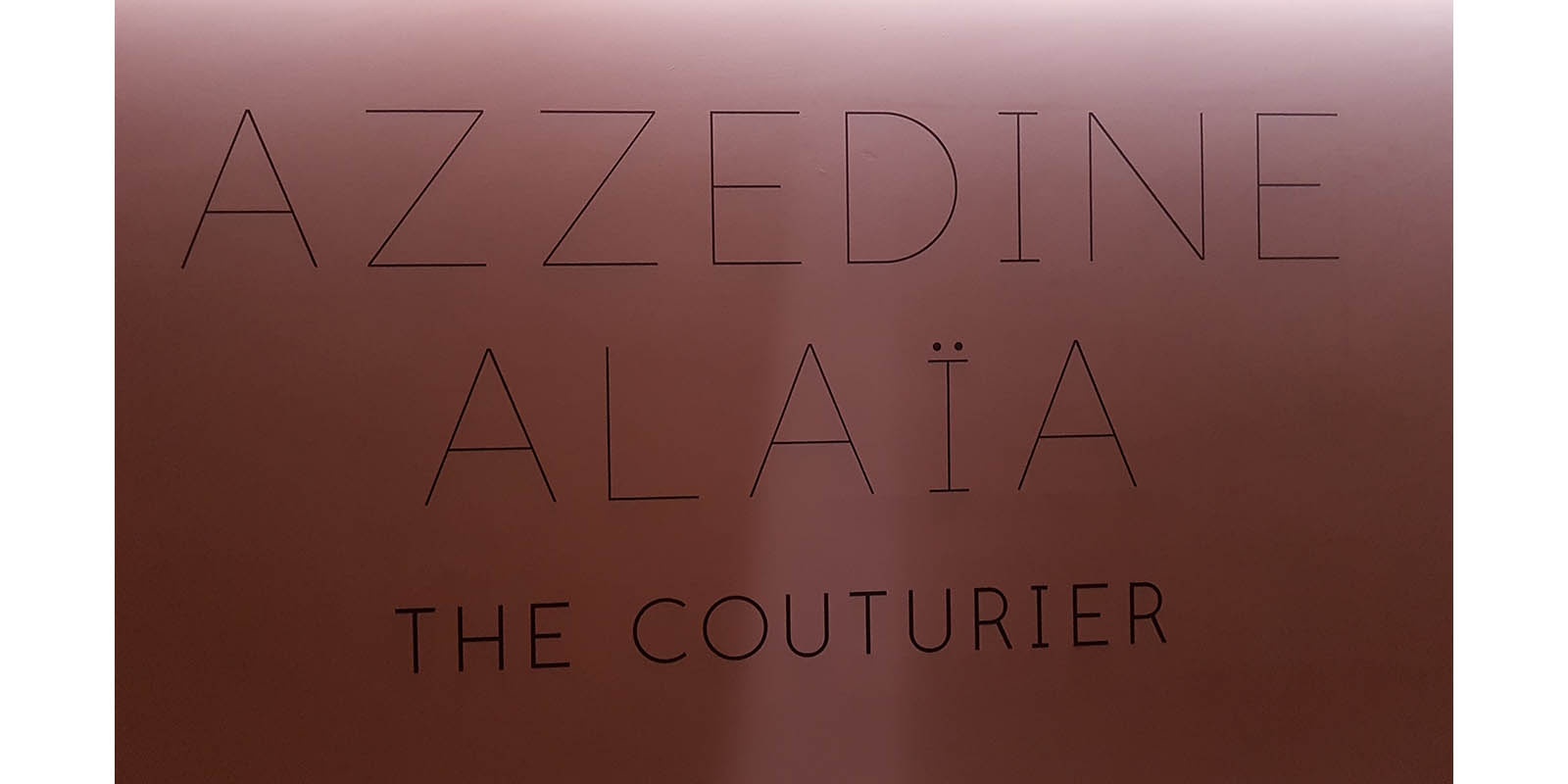
Between January 2016 and July 2017 Richard Wentworth was given rare access to Maison Alaia and observed the daily routine that took place in much the same way across the 30 years that the fashion House has inhabited it’s Parisian townhouse. The pictures show the painstaking dedication that the journey from inspiration, through creation to the flawless intricate finished Haute Couture is captured in these images. It was hard work that Alaia believed in and power of human relationships that had propelled him to success, from working with a Parisian dress maker in Tunis while a student, through to his entrance into Paris Society and introductions to writers and artists whom he would continue relationship with across his career.
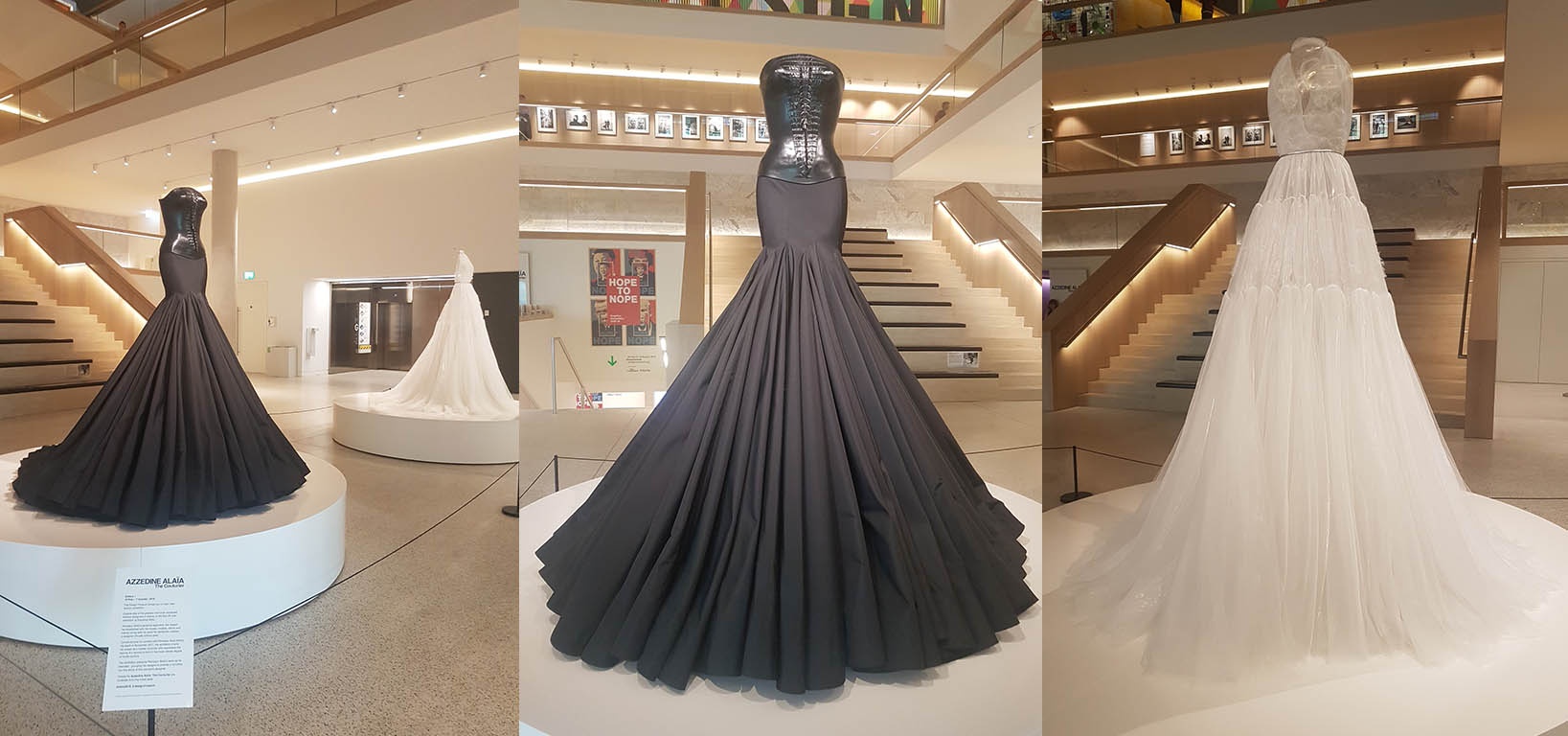
His early career as a sculptor lived on in his approach to smoothness of form in the designs that he produced. In his floor-length garments, the woman’s body is elongated and the flow of curves appear to take on an almost liquid fluidity. His ‘second-skin dressing’ has been one of the most influential styles of the late 20th and early 21st centuries and he personally constructed garments by hand. In doing so worked in the tradition of designers Christobal Balenciaga, Madelaine Voinet and Charles James who paid very close attention to draping, cutting and pinning on the female figure. Above in the entrance hall of The Design Museum, two dresses in the simple classic signature of Black and White greeted all guests of the museum as they entered. The codes of Alaia where plain to see in the sculpted fit and flare style with a fixed form bodice descending over the waist and hips in the Black dress above, before launching in ripples of fabric encircling the figure with modest train.
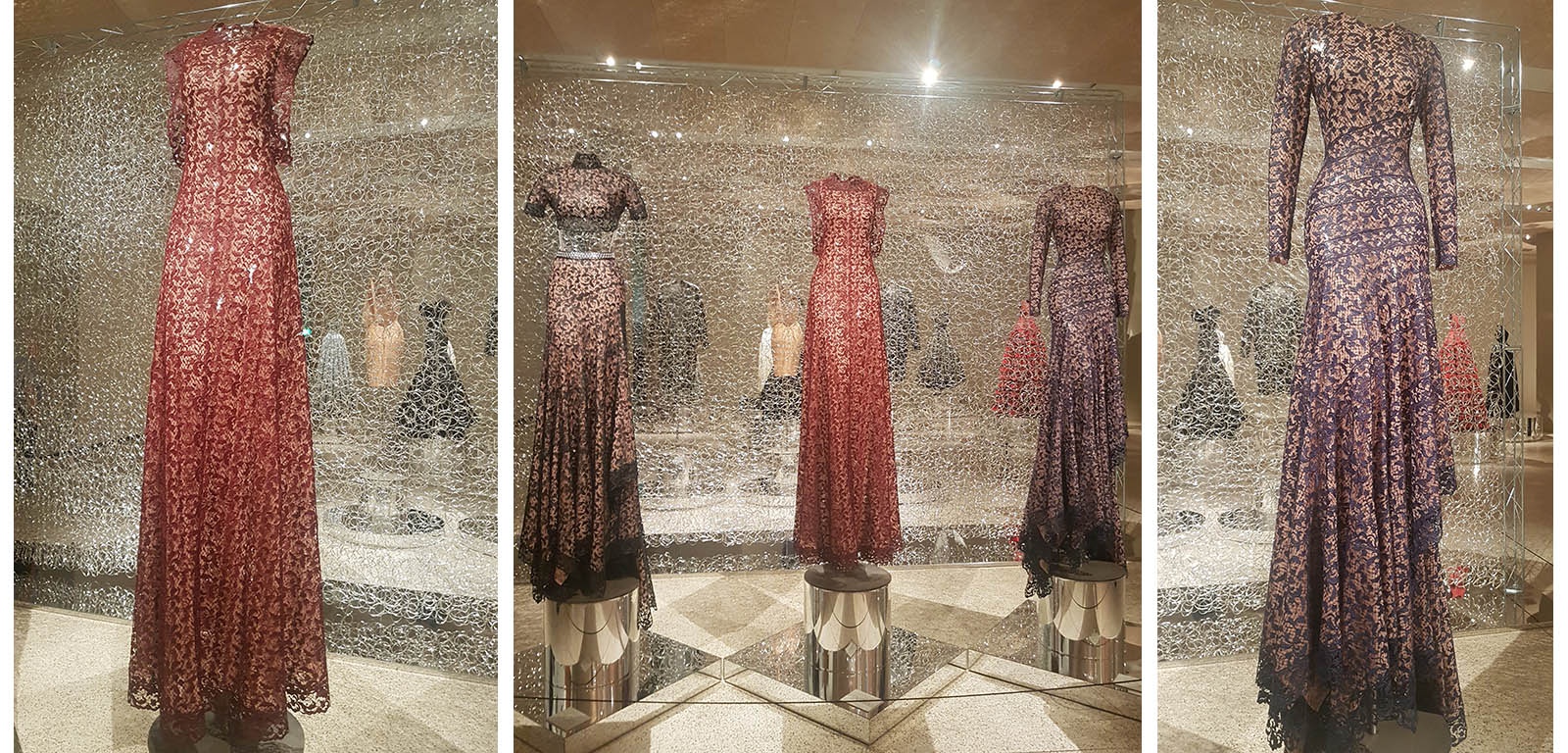
The visitor is brought into a large White single-room gallery, set with platforms and lighting to show the dresses at their best. It contrasts the Black that Alaia wore daily for decades. The garments are set in harmony with the work commissioned from artists Alaia knew including Kris Ruhs, the Bouroullec brothers, Konstantin Greic and Marc Newson in collaboration with von Weyhe. In keeping with Alaia’s belief in fusing mediums of art together the works are equal partners to the dresses that they sit alongside. Alaia believed he was an artist, not a fashion designer and at Maison Alaia artists, musicians, dancers and actors where welcome to drop by and share a meal with him and the Alaia family.
He dreamt the greatest dreams for women with almost anatomically impossible figures, as the mannequins show with models standing around 6 foot 6 at least to do justice to the vision of the diminutive creator. In life Alaia would tailor lengths a little more realistically to the figure and these beautiful dresses in soft metallic Charcoal, Red and Aubergine lace over a nude base fabric ably express his vision.
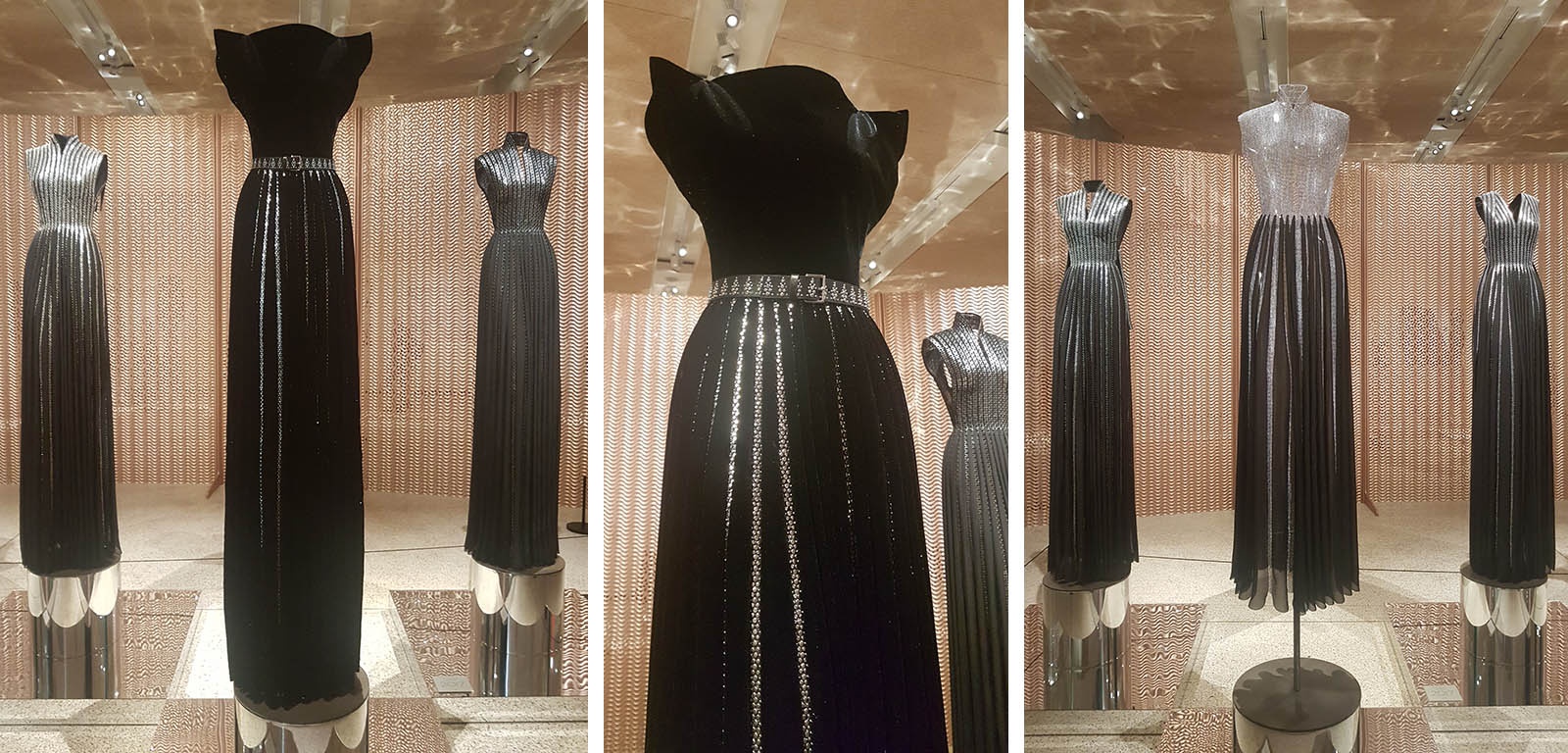
It speaks powerfully to his belief in women and adoration of the female figure expressed through elongated goddess-shaped outfits. Amongst his clients were Greta Garbo, Grace Jones, Naomi Campbell, Kylie Minogue, Michelle Obama, Tina Turner, Rhianna and Lady Gaga all of whom were used to a public space to wear his clothes. They were joined by legions of private clients who spread the word of his work enabling the establishment of Maison Alaia in 1981with the help of his friend artist Christoph von Weyhe overseeing many aspects of business. “I make clothes, women make fashion.” A sincere compliment but he created a hugely influential legacy. Within four years of opening Maison Alaia the French Ministry of Culture presented him with awards for Best French Collection and Designer of the Year. For most of his career he showed to his own schedule, when the work was finished, exploring moods and themes at his own speed.
Embracing the strength of women, he dresses them like warriors with chain mail detail in his designs. Fine metallic mesh is matched to strip layers of velvet and gauzy sheer silk to draw the eye to the impossible lengths of the figure. The waist is defined but doesn't distract from the message of the garment that is primarily conveyed by the fabric used. Like liquid steel it moulds to the figure of the wearer perfectly but is light enough to not be restricting or heavy.
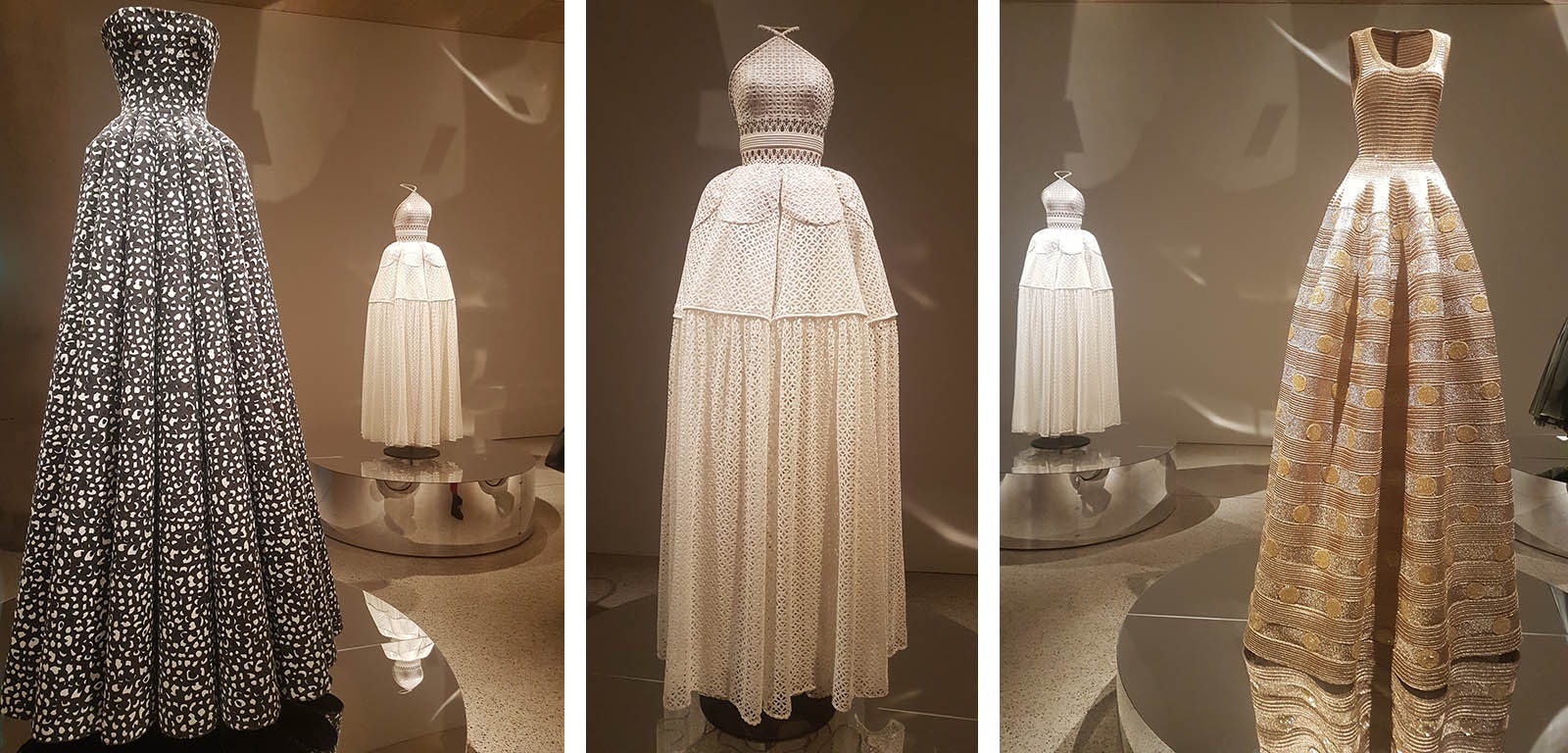
Using sculpted moulding to create circular waves, themselves encircling the figure, is a technique that Alaia used across several decades. Its conceptual without being overly dramatic and something that has been copied by several designers since with a notable American name coming to mind. To me the lengths of fabric, particularly in the look to the left also resemble the dangling lengths of spiders legs, or perhaps an Octopus. Perhaps a hint at the intuitive capabilities often credited to women. Centre above Broderie Anglaise features in the halter neck dress with a close cut bodice descending to a triple layered skirt. It manages to meld soft and natural with a contemporary art aesthetic. To the right, a burst of Gold with burnished Golden weave complimented by discs of Yellow Gold in banded layers presents a modern take on Majesty to enter your wardrobe. I think this piece would also look beautiful styled as cut to below the knee in length and possibly accessorised with a Black jacket. It's classic Alaia ready for the Red Carpet.
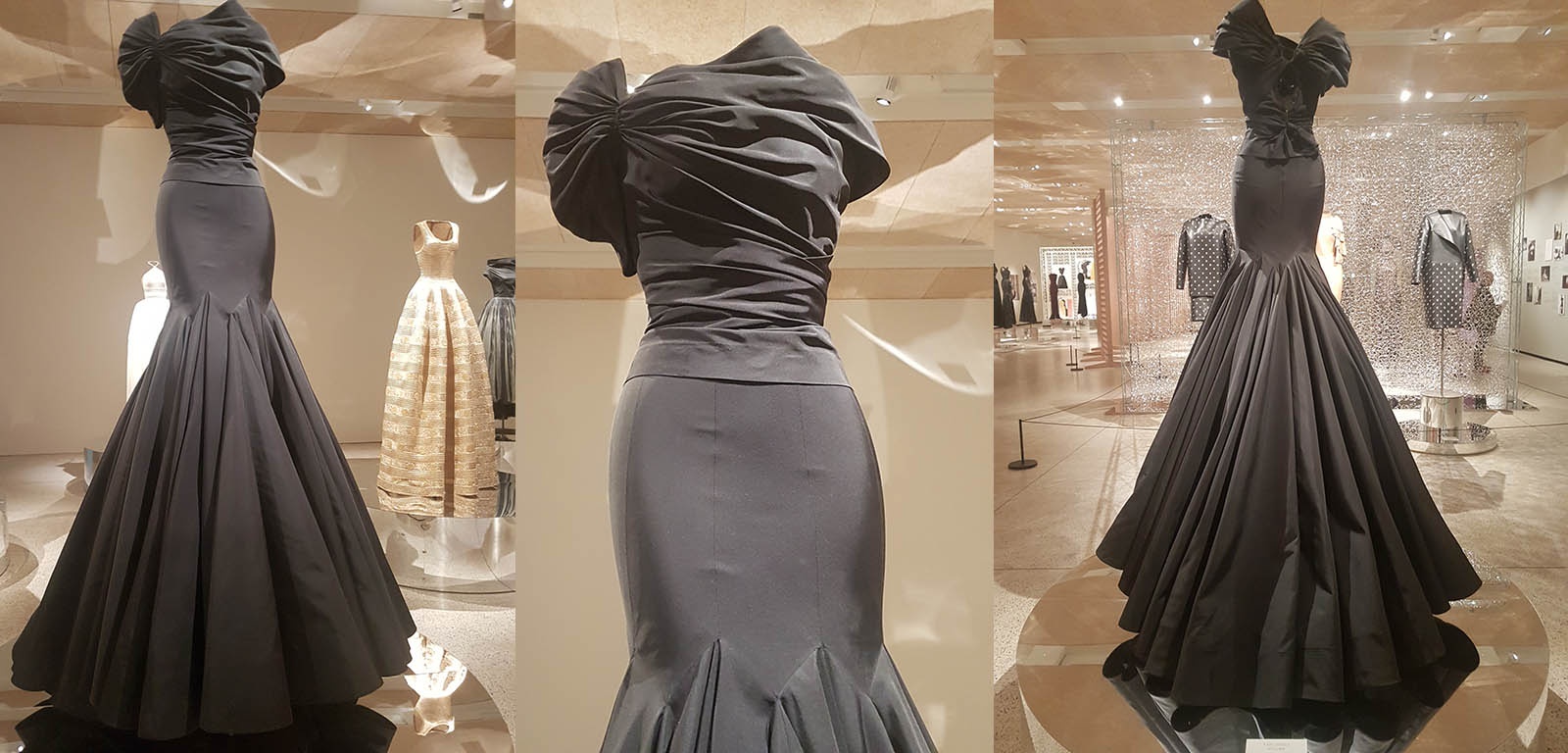
Evening dresses as a staple of the wardrobe is something that hasn't changed for many women across the last two to three centuries. You need to have at least a few key pieces you can fall back on for last minute invites as well as special things for events planned longer in the diary. Above from the front and the side you can see one of the collection masterpiece's. The classic Black full length formal dress is worked into three beautiful parts. A softly sculpted bodice created in ruched layers appears to be gathered casually across the figure. Fastened at the right shoulder in a gather to support the dress on the figure, it subtly covers both shoulders without appearing to try to. The skirt is created in one piece with two texture parts so to speak. Sculpted closely across the hips and thighs in a somewhat restricting style, it descends to a skirt cut with generous volume thanks to pleats couched in layers in half diamond rises and falls. This is a dress that is ready for the camera.
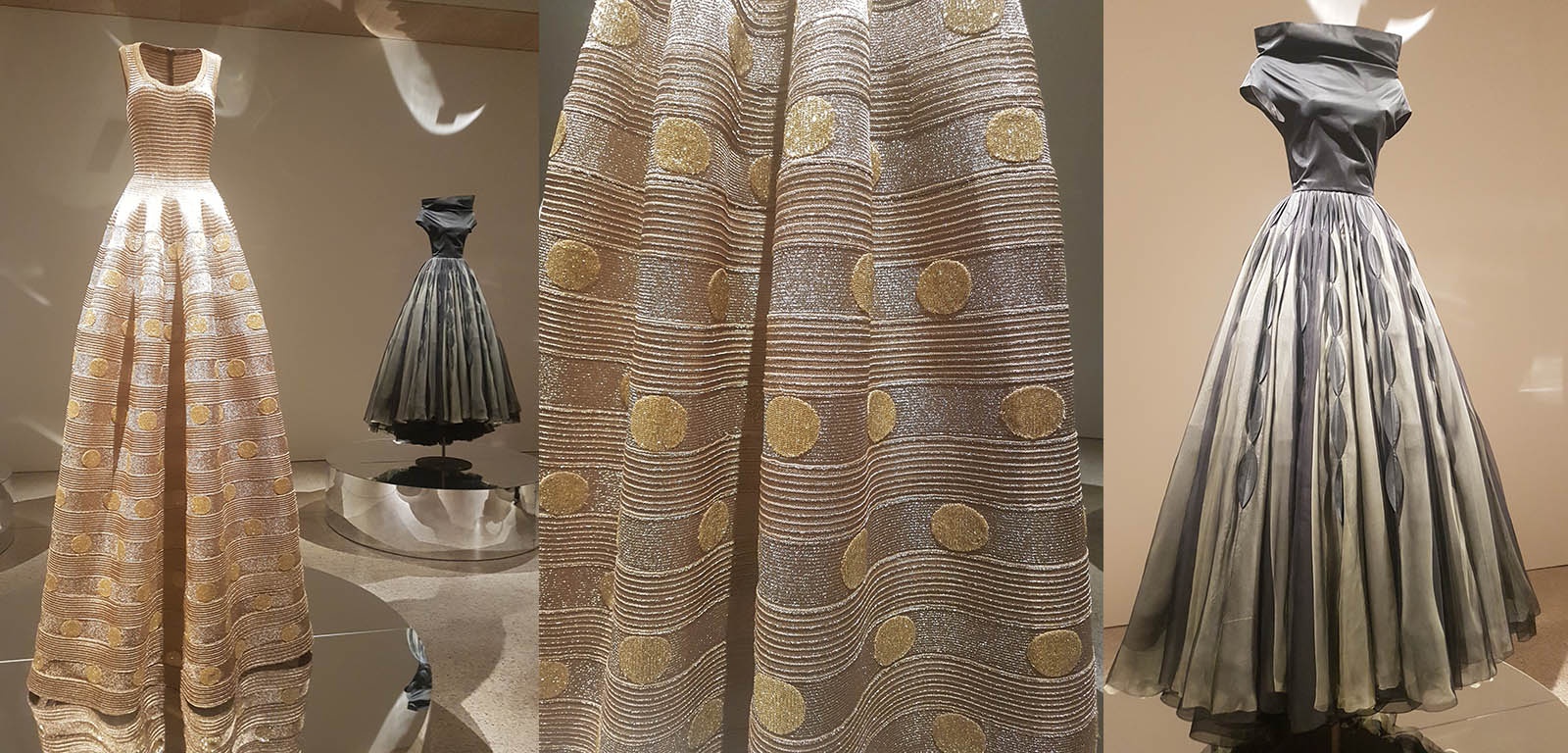
Here again another look at the tightly woven golden thread of the fabric and the Yellow-Gold button discs. To the right a dress representing perhaps a little more mystery in the elliptical shapes running down the lengths of the skirt. The piece in Olive and Teal-Grey echoes the lines of the classic 1950's long line cocktail dress and gown. A satin silk upper dress uses a wide boat neckline that wouldn't have been seen in formal wear in earlier decades dramatically raised above the collar bone. The dress comprised of a sheer outer layer plays with the gaze by alternating the colour of the garment underneath between Teal and Olive as the dress moves with the wearer.
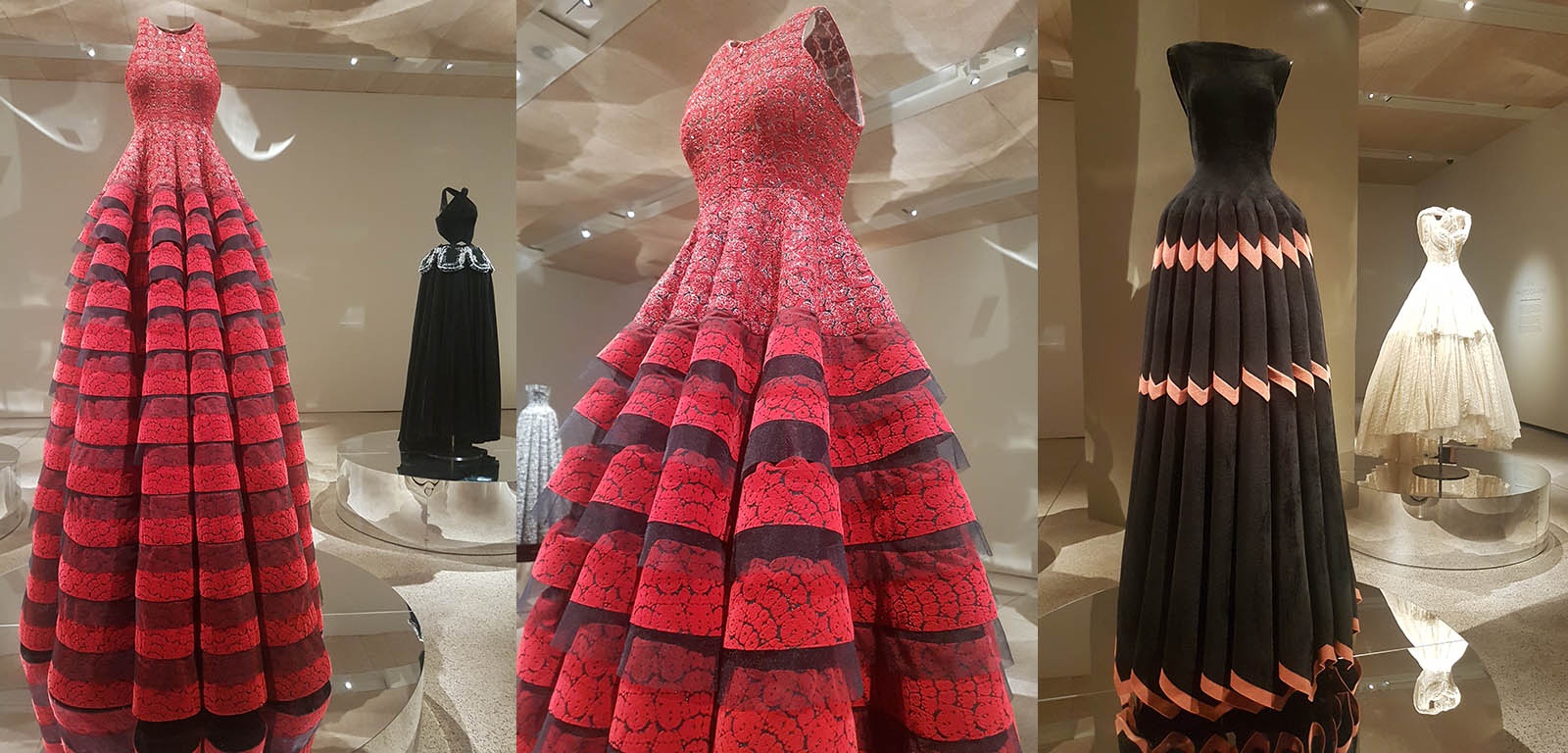
The broad statement folds appear again in a Scarlet Red dress that uses the deep pronounced folds loved by Alaia. This dress announces the two parts of the garment with a finely woven sleeveless bodice sitting above long lengths of the skirt. The skirt lengths themselves contain deep folds to increase volume but also a second style twist in tiers of dual layered fabric. The overall effect is an optically striking piece that needs to be in a single colour to prevent it from becoming overwhelming. To the far right a Black floor length dress is set in more ridged form with a dress moulded to fall directly downward from the waist. The fabric although soft, looks to contain a stiffness and looking at it another way, it has the presence of gowns worn by women in the 16th and 17th century in Europe. In simple Black with Pink-Honey banding formed into chevron stripes, it's cut at the hem into handkerchief corners that again expresses the almost architectural design feel to the pieces.
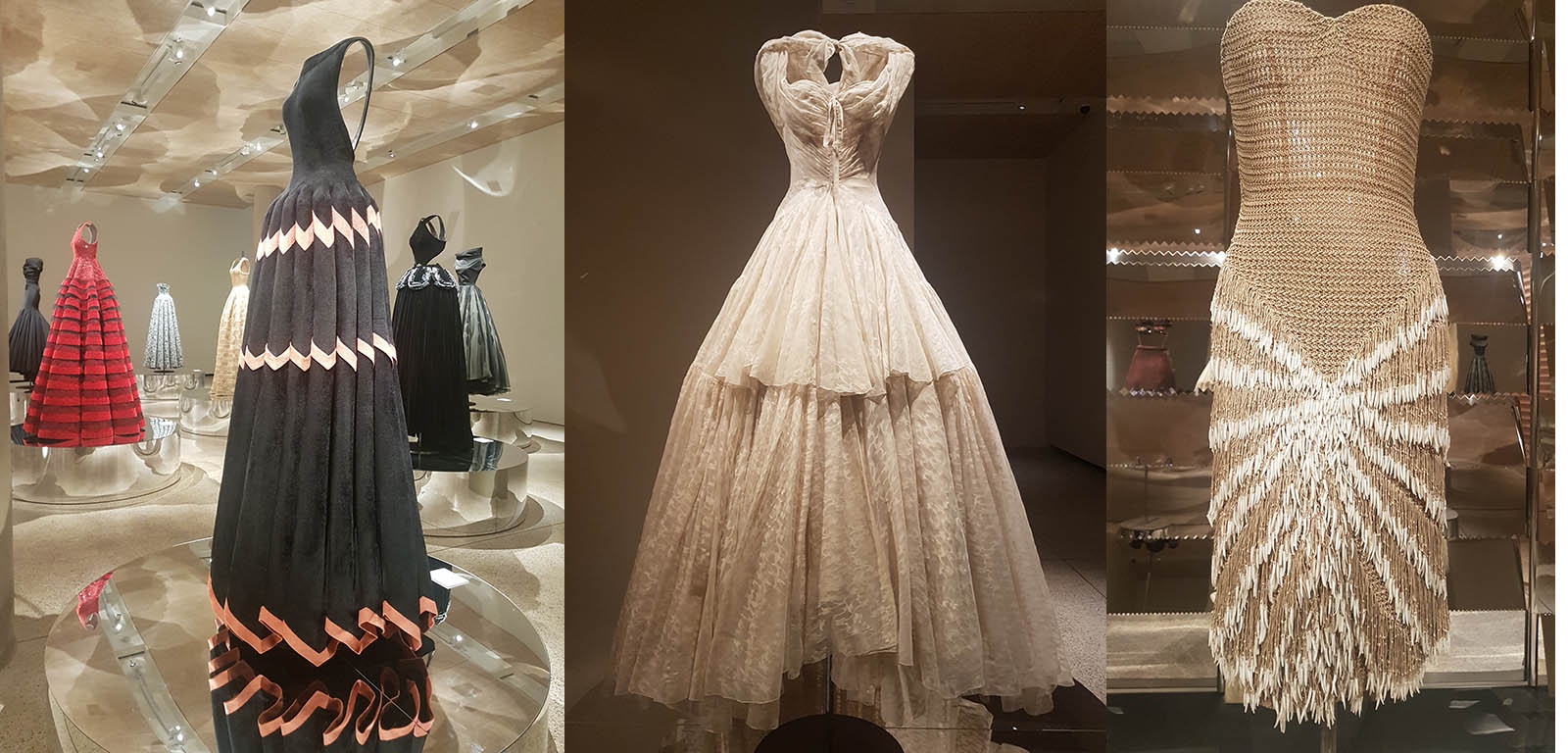
A view across the gallery from the side shows many of the dresses gathered in part of the exhibition. It's a neat illustration of Alaia's methods of designing and illustrates how he didn't subscribe to a rigid paten of showing collections by seasons or even themed collections, instead he largely produced work how and when he chose to and clients knew that they could go to him and order or find the latest series of works in his Paris boutique. Above to the centre a ghostly dress in White linen hints at a carefree distraction in it's uneven lengths. Sheer fabric layered with uneven hem lengths and a tightly sewn bodice evokes the 18th and 19th century sewn corsets of the past while ruching and gathers pleats add volume and generous fabric without any extra weight to the wearer.
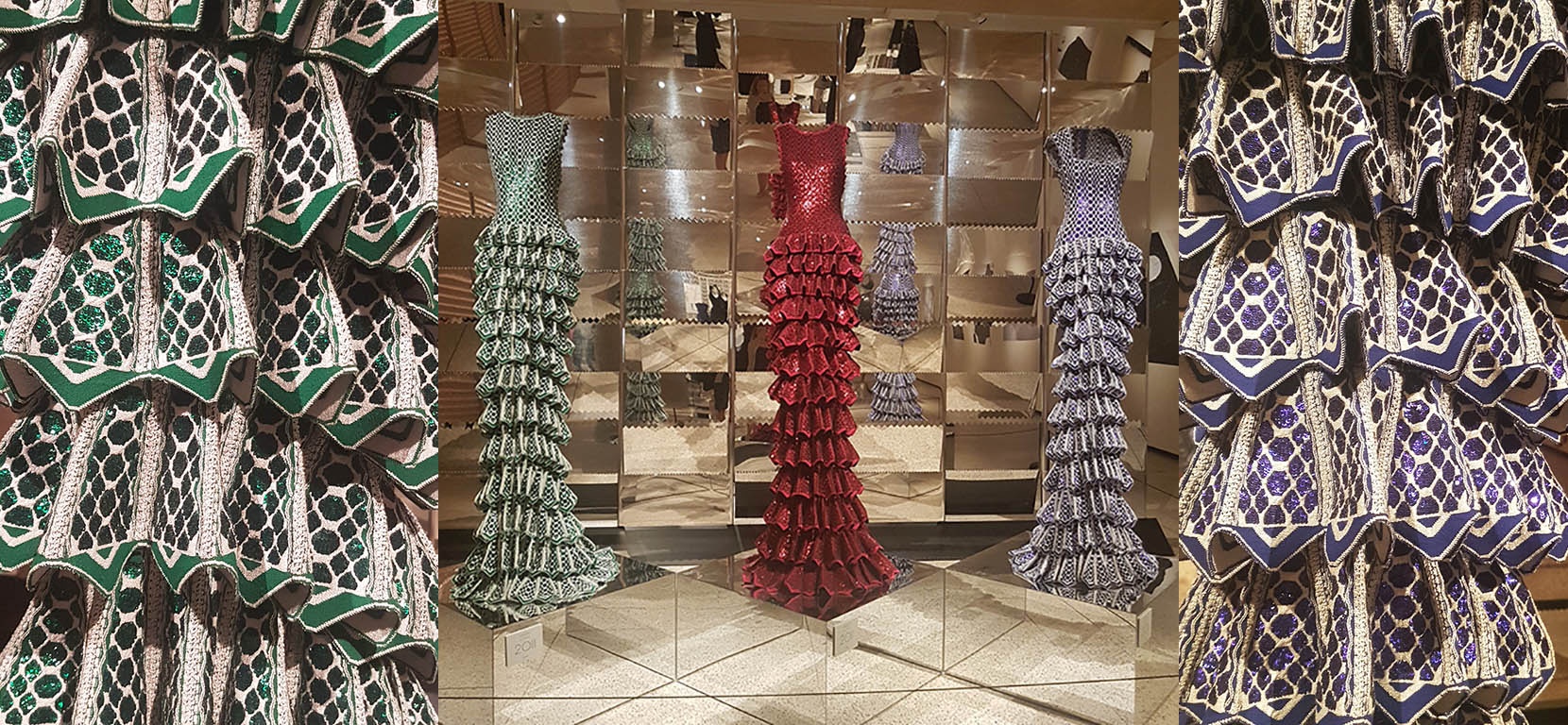
Colour is something that Alaia can use or reject in a collection to suit his whims above a range of three dresses illustrates a fascinating metallic coloured sheen that glints at the audience and also to me at least resembles some European carnival textiles worn in previous centuries. The series of three dresses with hallmark stretch-fit bodice descends to a signature style skirt length with concetina folds of fabric gathered in tight tiers. Green then Red and finally Lapis Blue, they each posses the power to stop a room upon entrance and hold the gaze of the observer or camera. Potentially on cold nights, they could be teamed with a cape or jacket.
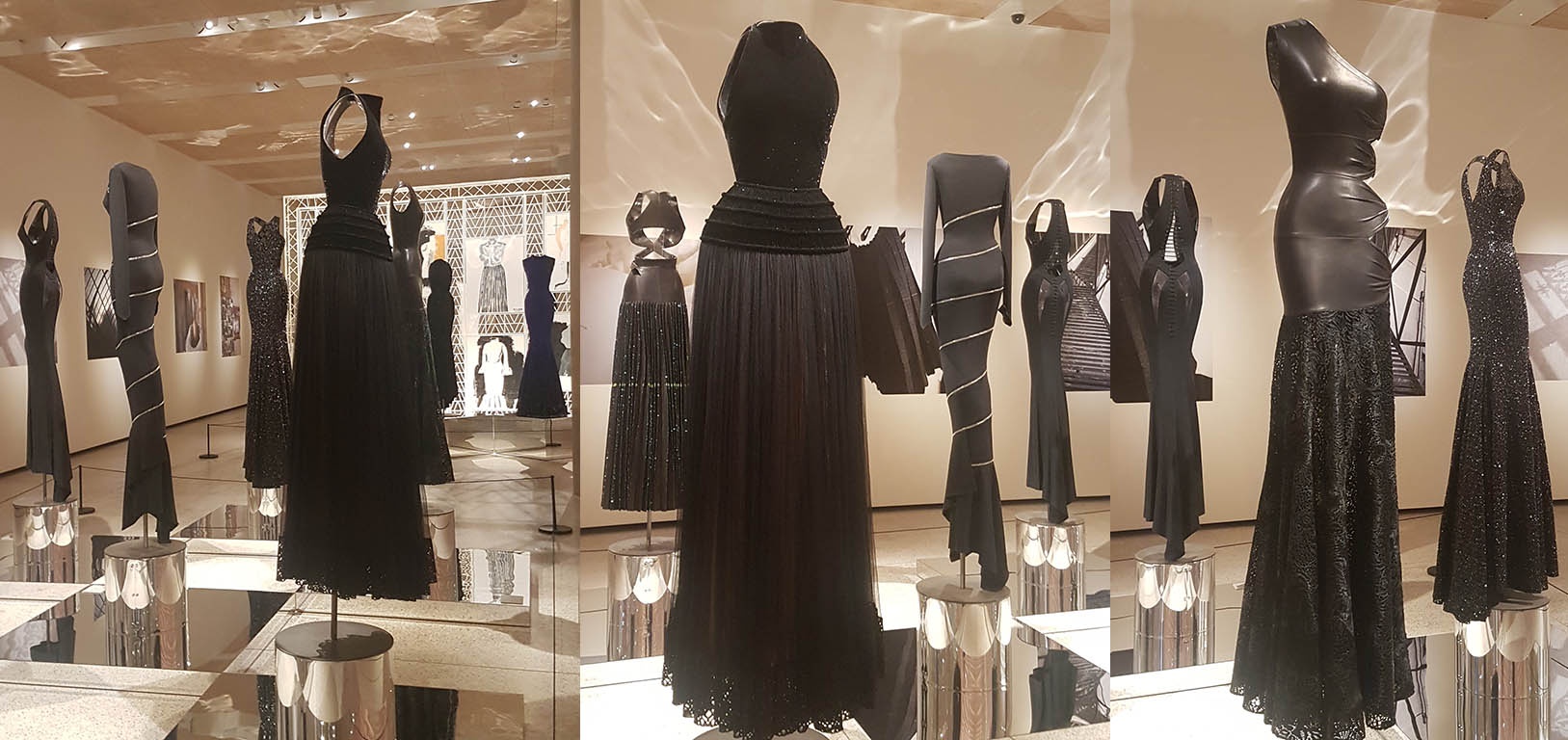
Black, that classic evening shade is a staple of the Alaia repertoire and the colour that is almost universally flattering and a colour that Alaia enjoyed drawing on to create garments for his clients. Above you can see a space within the gallery devoted to solely Black dresses. They share the common trait of being sculpted closely to the figure across the upper area while flowing downwards through the lengths. Interestingly whilst he seems to play with space and dimension of the dresses skirts they are almost universally long reaching ankle or floor length; rarely does he create a dress that falls to the knee, an exception would be the elliptical Olive coloured dress above. A round neckline bodice appears in the dress foremost seen above both left and centre as the smooth velvet bodice translates into a ribbed style flowing down across the hips. Alaia uses tremendous amounts of light fabric in the finely gathered pleated lengths of the skirt. The tight folds give the impression of limitless space for the wearer to move in as she walks and create an opacity from the multiple thin layers.
Behind it you can see several garments including a long figure hugging dress with a chord of crystal roped around the figure from shoulder to hem. The spiral cleverly breaks the line of the Black. In a more daring style the dress above to the right at front of shot features a cut away Black stretch fabric upper body sash-tied at the left side of the figure. Black lace closely gathered in the skirt and dropped on the bias in the lower part of the dress celebrates the natural beauty of the figure in a fabric contrast. Below you can see the garment’s skirt in more detail and the complexity of the fabric that he sought to create. Technical detail and pushing boundaries are something that has been very important to the Alaia team for many years.
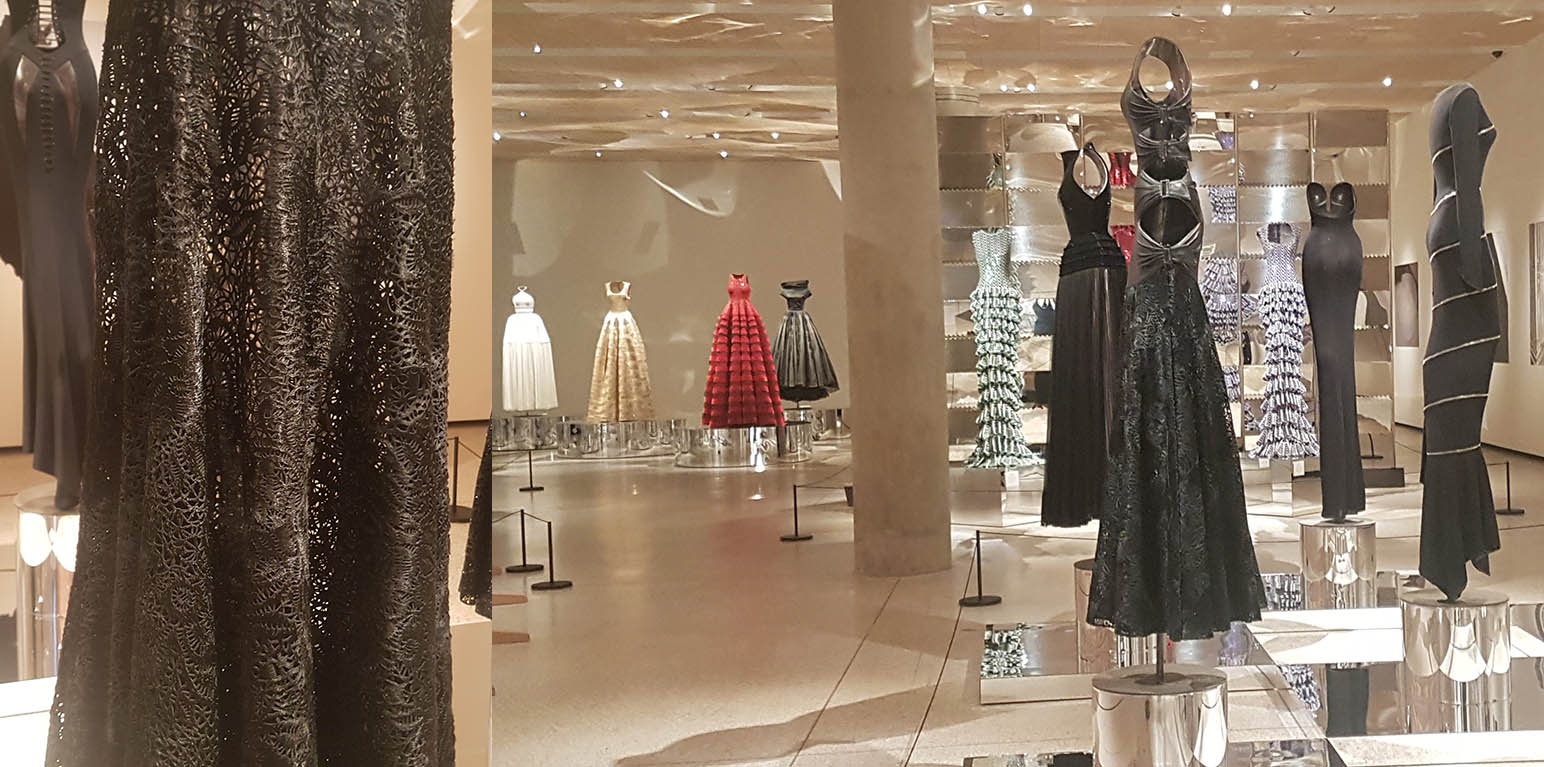
A broad view of the Design Museum gallery shows three phases of the collection moving through expressions of colour to the Concertina style metallic gowns and the phase showing the Black dresses. The span of colour and contrasting styles articulates the versatility of moods and collections that the designer was able to create for his audience. But rather than a simple shopping fantasy, this does have the feel of an art exhibition, something that I have long believed that high fashion can rightly aspire to be called. The design, composition and cultural impact of some Haute Couture and fashion can be rightly called this.
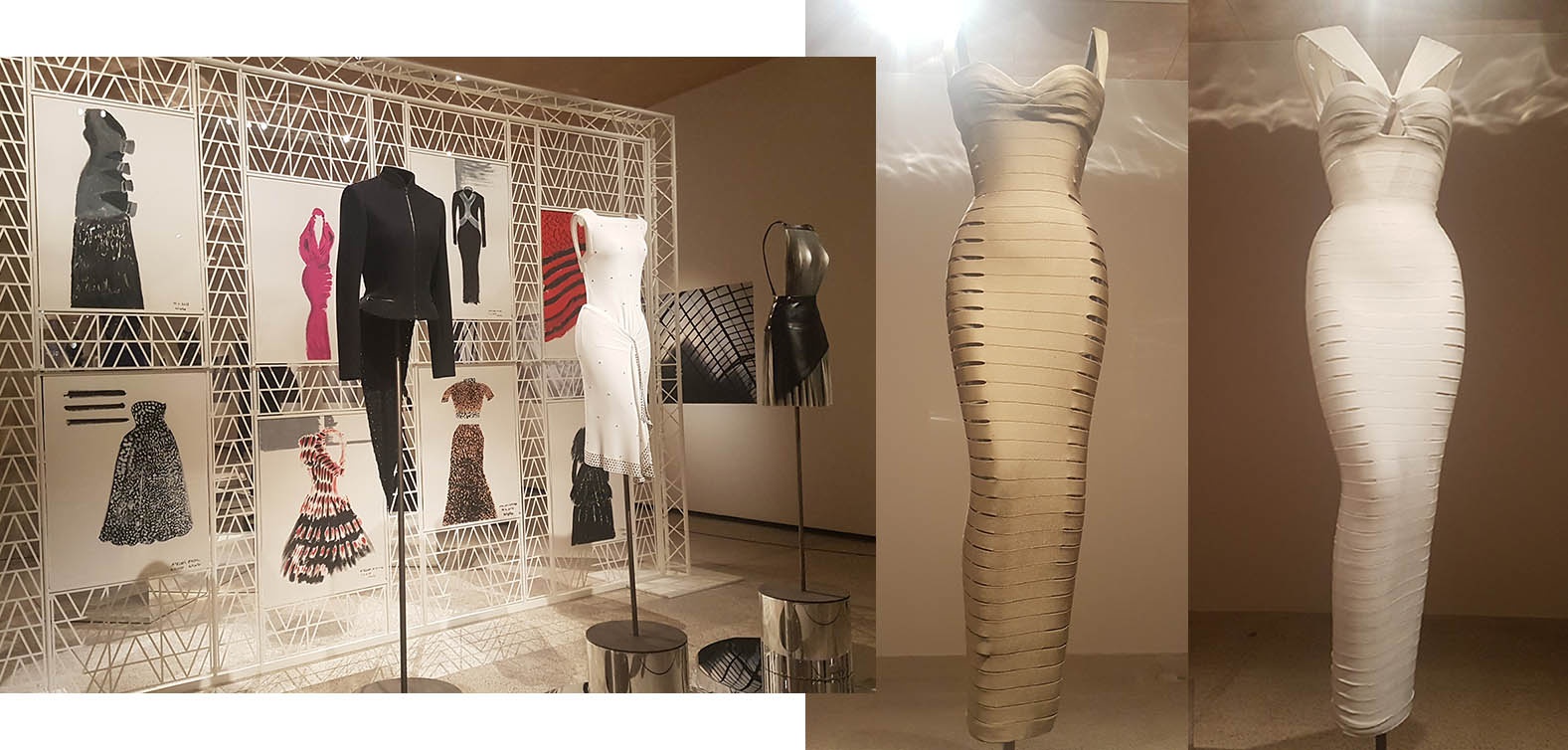
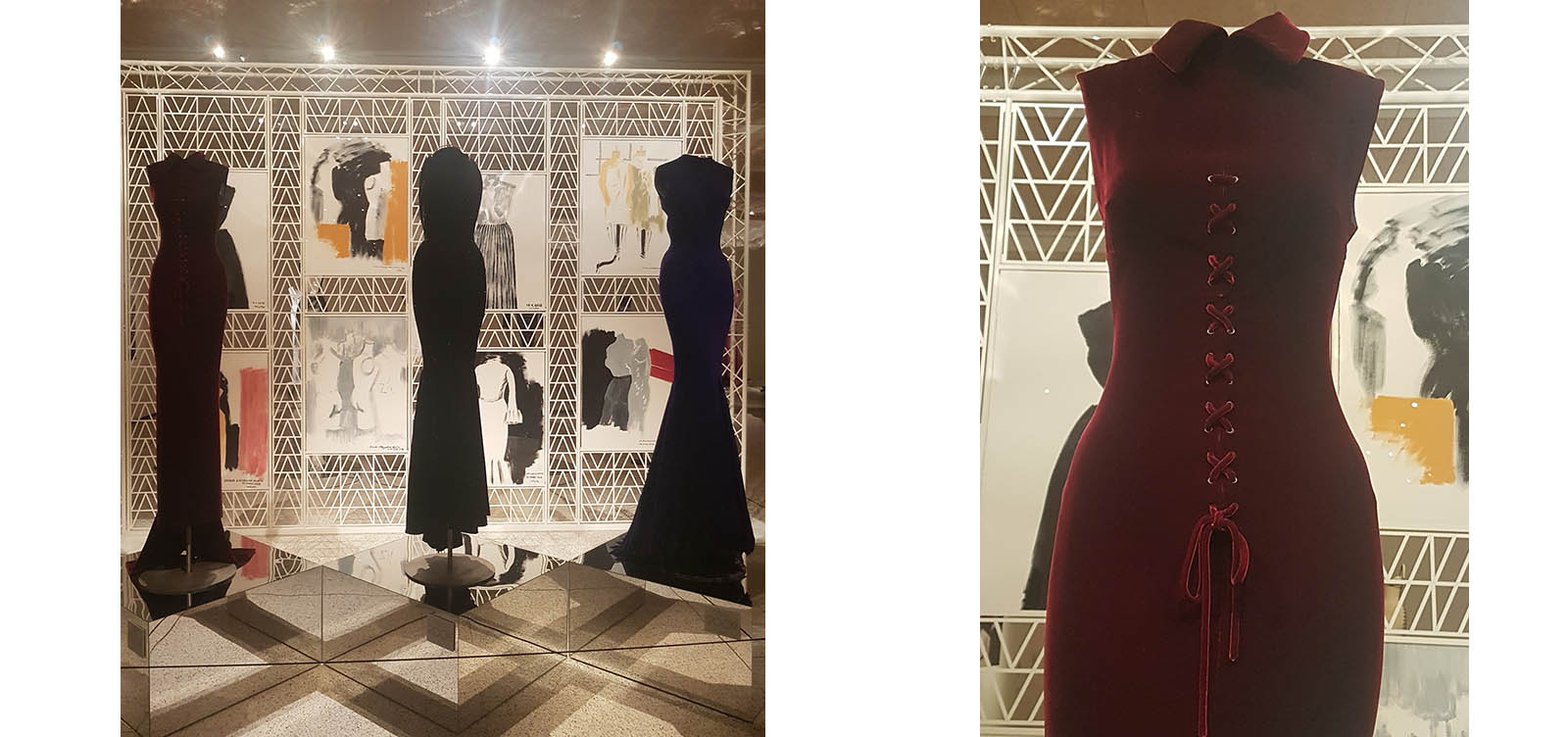
Art and Alaia go hand in hand and above a triptych of velvet dresses are backed by pieces of contemporary art that show stages of the design process and thoughts and feelings. All connect and form part of the complete scene. A deep Claret coloured dress features broad lacing down across the front of the garment in a cosmetic style feature. It references the simple basic element of the stitch present in all design no matter how simple or complex and also serves to draw the eye to the simple clean lines that demonstrate the health of a figure. It’s Black and Navy counterparts form more classic subtle style options for clients at Black tie events. As with all Alaia they are friendly to the well-kept figure but could also have pleasure power if collected as works of art, if not able to be worn on the living human figure.
The gouaches of designs to be created by Alaia also create another form of art in themselves. Positioned behind a presentation of a jacket and two dresses, they frame the setting with hints of the creative process. It brings the colour and the life of the studio to the viewer in a heartbeat. To the right the stretch fit high-impact ‘bodycon’ dresses that Alaia became famous for around the globe appear in Gold and White. Showing the figure in high relief, play at the neckline on differing styles of gather makes a flattering contrast to the slightly industrial feel of the side-slits following the line of the leg.
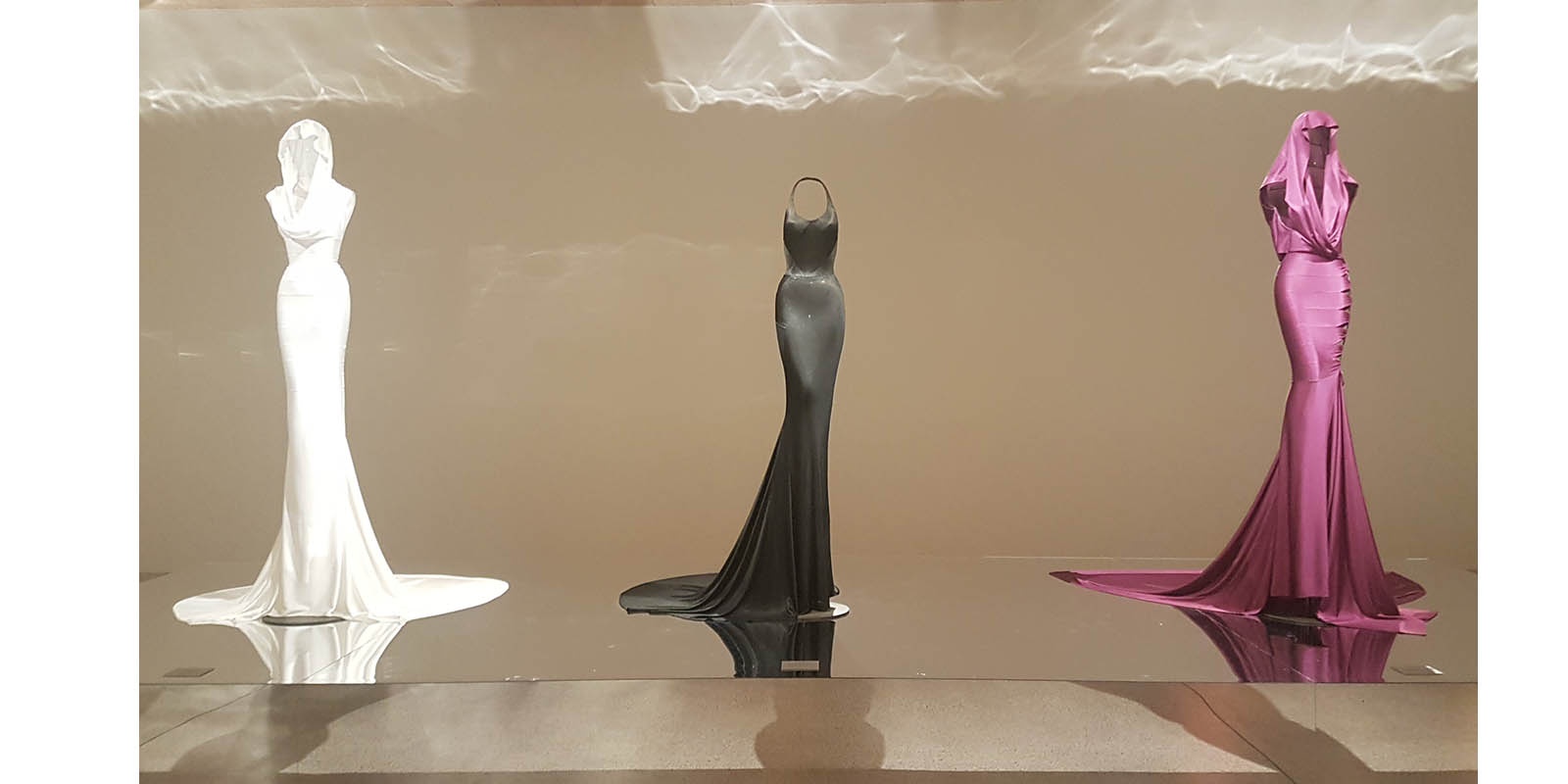
One of the most emphatic triptych’s of the exhibition stands with three dresses moving between the hooded and cut-away bodice styles. These where show-piece looks that Alaia accompanied clients with to events when worn. Alaia spoke about his wish to make women beautiful and in his vision he did this. He had a mathematical eye for design like many other designers and sought to combine his aesthetic with the goddesses that he met in the fashion industry. His legacy is an example of the pursuit of the Aesthetic of idealised feminine form.
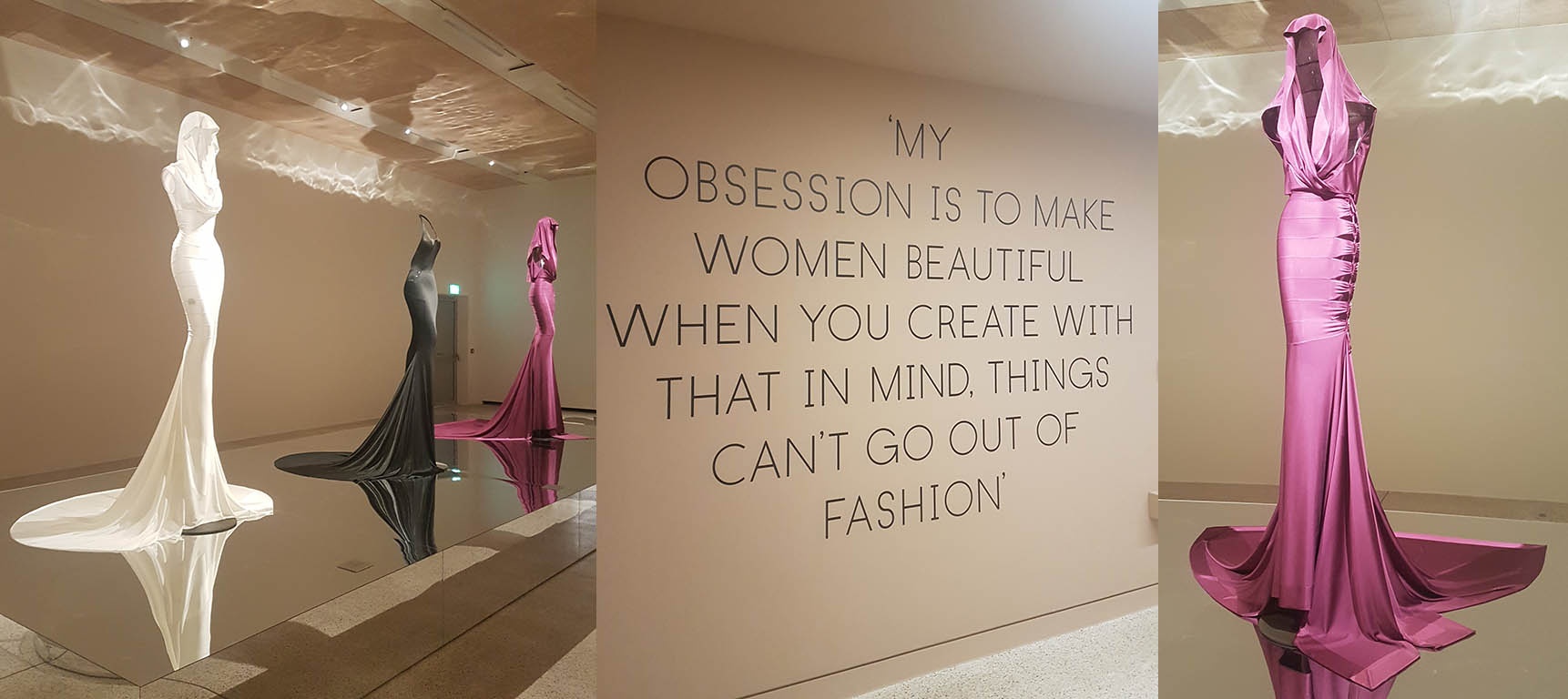
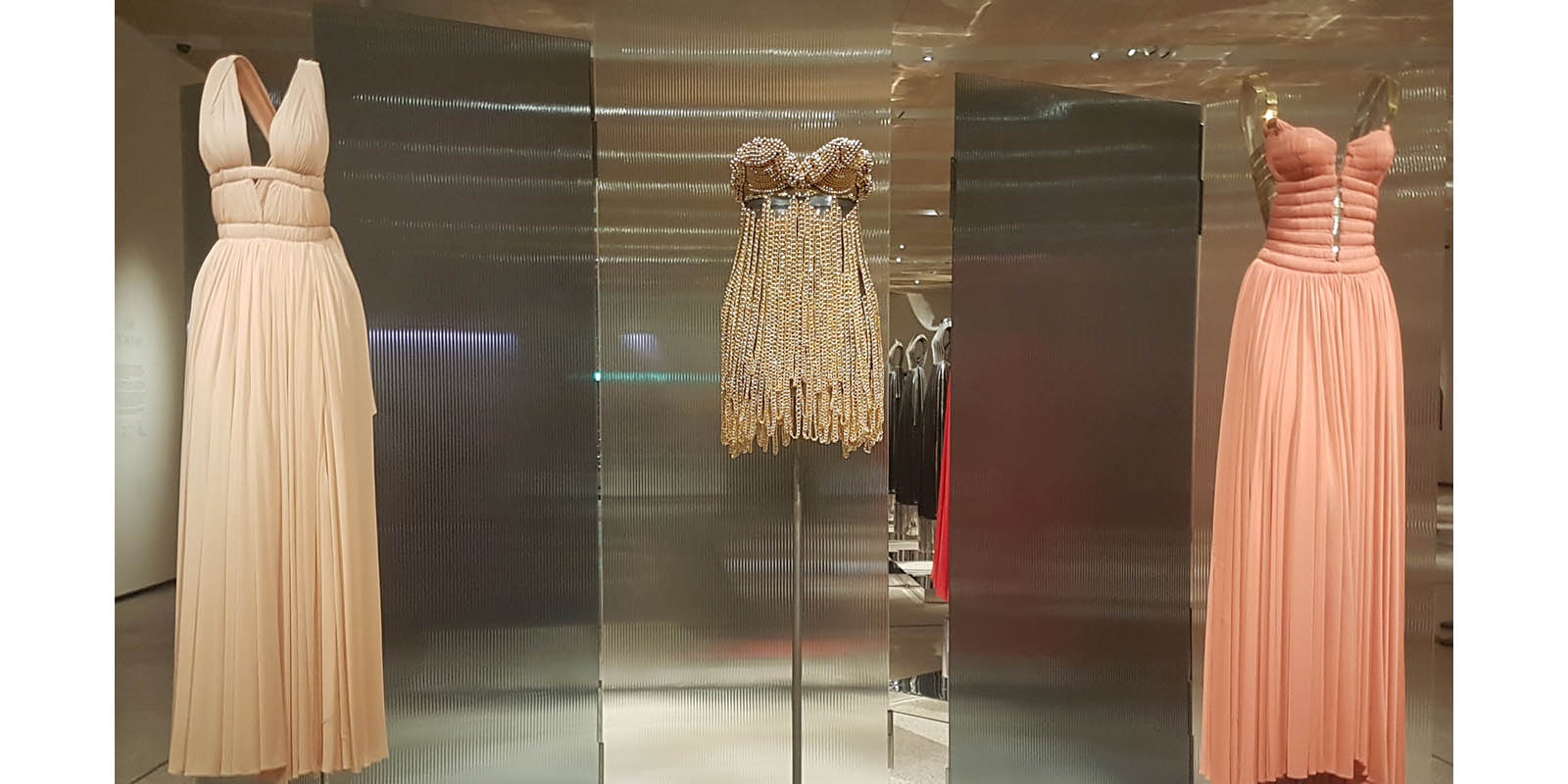
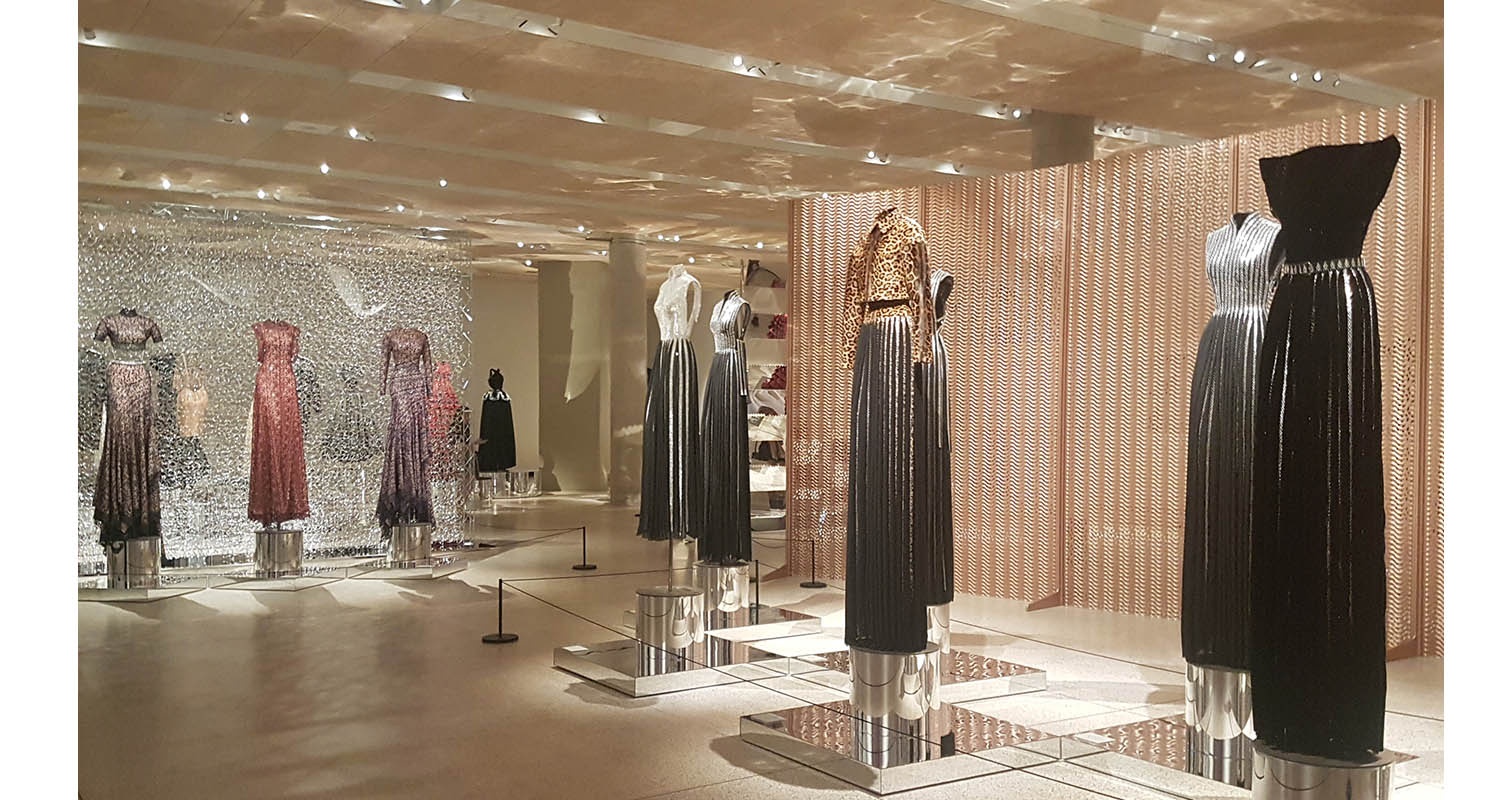
Charles II - Art and Power.
The Queen's Gallery in Buckingham Palace and Hollyrood House
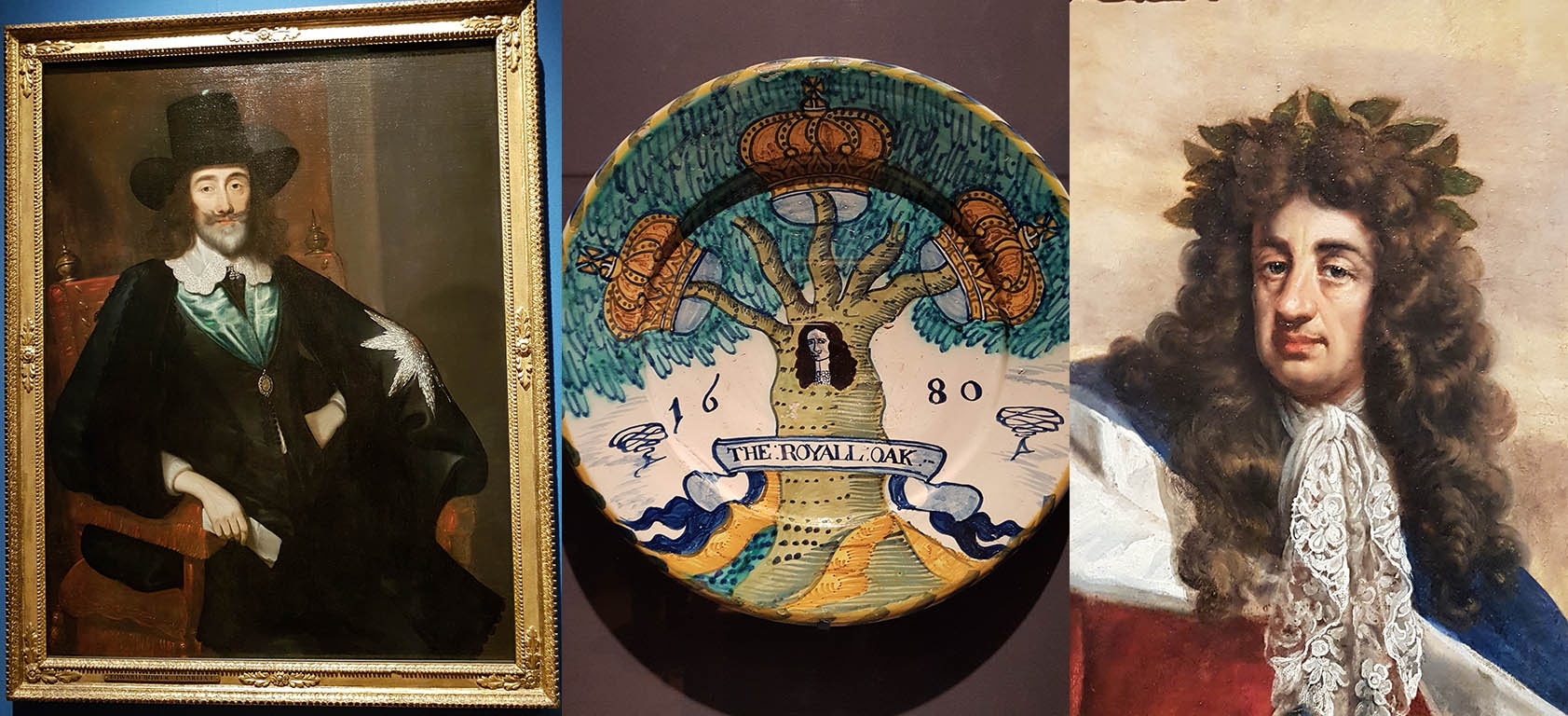
A painting of Charles I not long before he died shows him dressed in the Black cloth of the puritans and Light blue Stuart sash. It’s a stony gaze of a man defeated, a man who will not see his wife and children again but the gaze remains dignified and calm, not submissive. In the Queens gallery the family are partly reunited. Charles II and his court, which his mother visited occasionally from France after his restoration, aimed to bring back the spectacle and social nexus that had existed before. The years spent on the hoof between the death of his father and disposition are woven into British legend. This ceramic plate a charming keepsake of troubled times. One of his most famous hiding places was inside an oak tree after the battle of Worcester, a little different from the Inns and sympathetic family homes that he had usually known. Three branches of the tree hold three large crowns to represent the three kingdoms that the Stuarts reigned and also resembles the trefoil Fleur de Lis of the ancient Lily symbolising the Frankish French Royal origins.
To the right Charles II himself, the ‘very ugly baby’ Henrietta described in incredulity to her relatives in Europe. No doubt his charms where many and alongside his belief in beauty he also shared his European cousins understanding of the impact of art on the wider public and society in terms of representation. Cloaked in the Red, Blue and White of his native Britain, Charles identified himself unquestionably with the homeland he returned to.
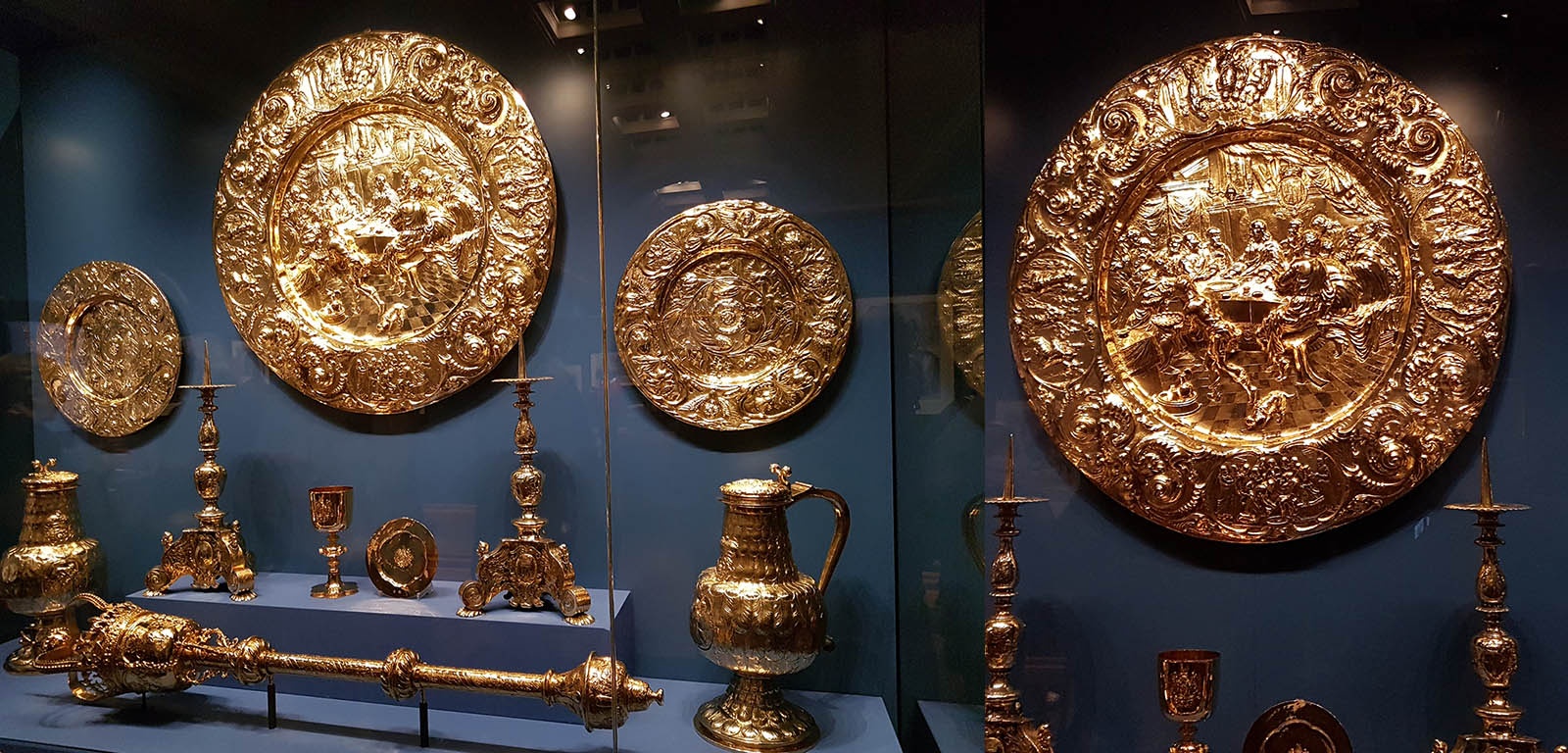
There are many symbols associated with majesty and traditionally in the UK and other countries families who are wealthy show the ‘best plate’ for formal occasions such as weddings or ceremonial use. Following the restoration Charles II commissioned some pieces of Gold Plate to replace some of the regalia that was sold and melted down during the Commonwealth era. Above you can see a mace, a symbol of the authority of the crown and the enormous plate of state.
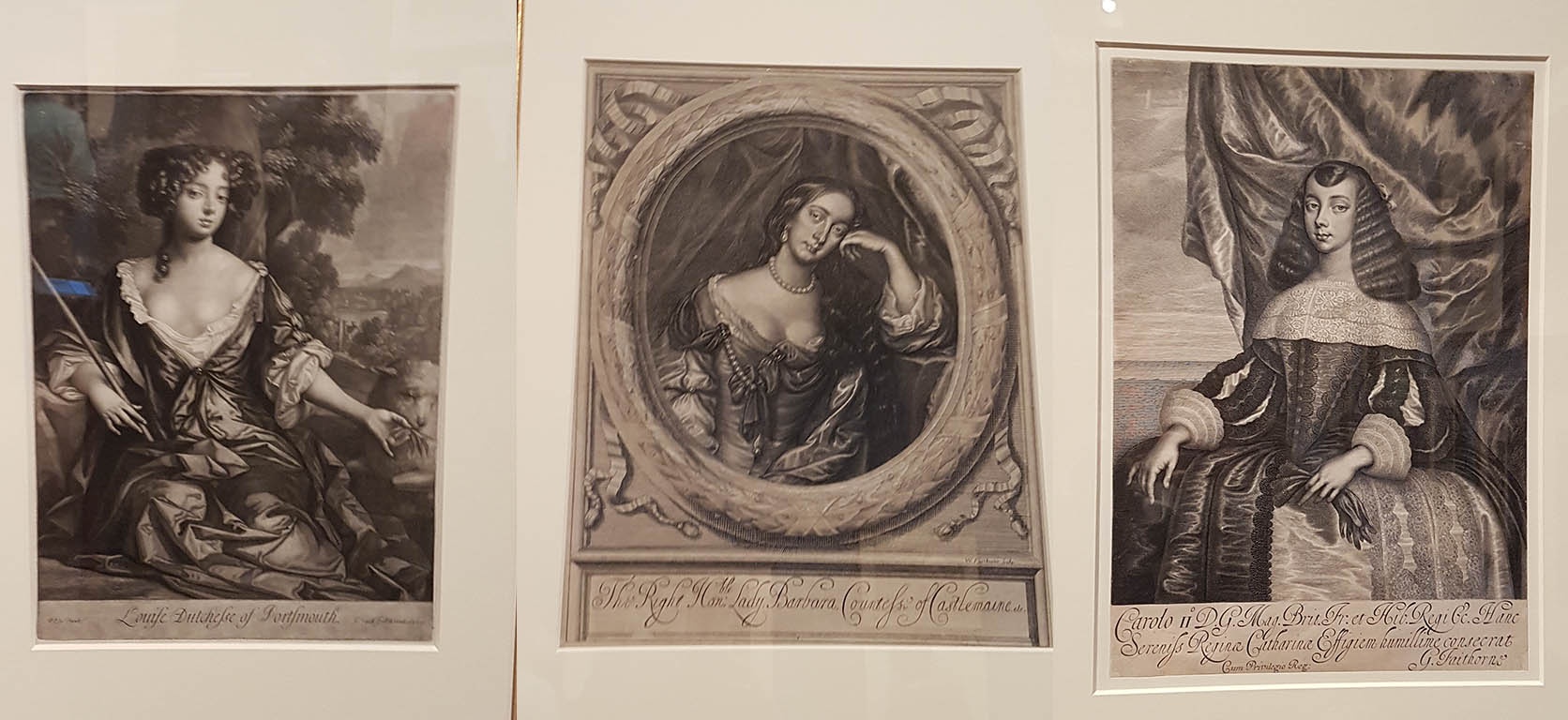
A Royal Court functioned for several reasons, for governance in law, to diplomacy but also continuing from the era of Elizabeth I, the Stuarts made efforts to re-establish a creative, crucible at the heart of Royal Court life. King’s will always attract ambitious men and for Charles and to some extent his surviving brother, later James II, women also where drawn to their allure of what a Princes company could do for them; financially, politically and for sheer fun. Louise de Kerouaille the Breton aristocrat was an early pioneer of the advantages that could be gained in the restoration court in securing Charles’ favour following her time in the court of Charles’ cousin Louis XIV. Some think she was a spy, I think she may have found a relatively new court more of an open field. It’s a sad thing to realise that due to restrictions on the lives of women in the 17th century for many women, being at court may have been the only career option for those who were intelligent, curious and wanted independence but even this was only an option usually for the well off.
In the centre above, Barbara Villiers, probably the most mercenary of Charles II’s mistresses in terms of her greed. The engraving is unusual in the simple unbound style of her hair and this would have been instantly recognisable as sultry and ‘wanton’ to circumspect eyes before the mid 20th century. To the far right, Charles’ Queen Catherine of Braganza, the only woman to appear in modest portrayal in contrast to the bosomy ladies, the Windsor Beauties of Peter Lely’s portraits. Her neckline is covered, her pose is predictably more composed and while not necessarily regal most people would not need to see a caption to recognise the portrayal of a noble woman worthy of respect.
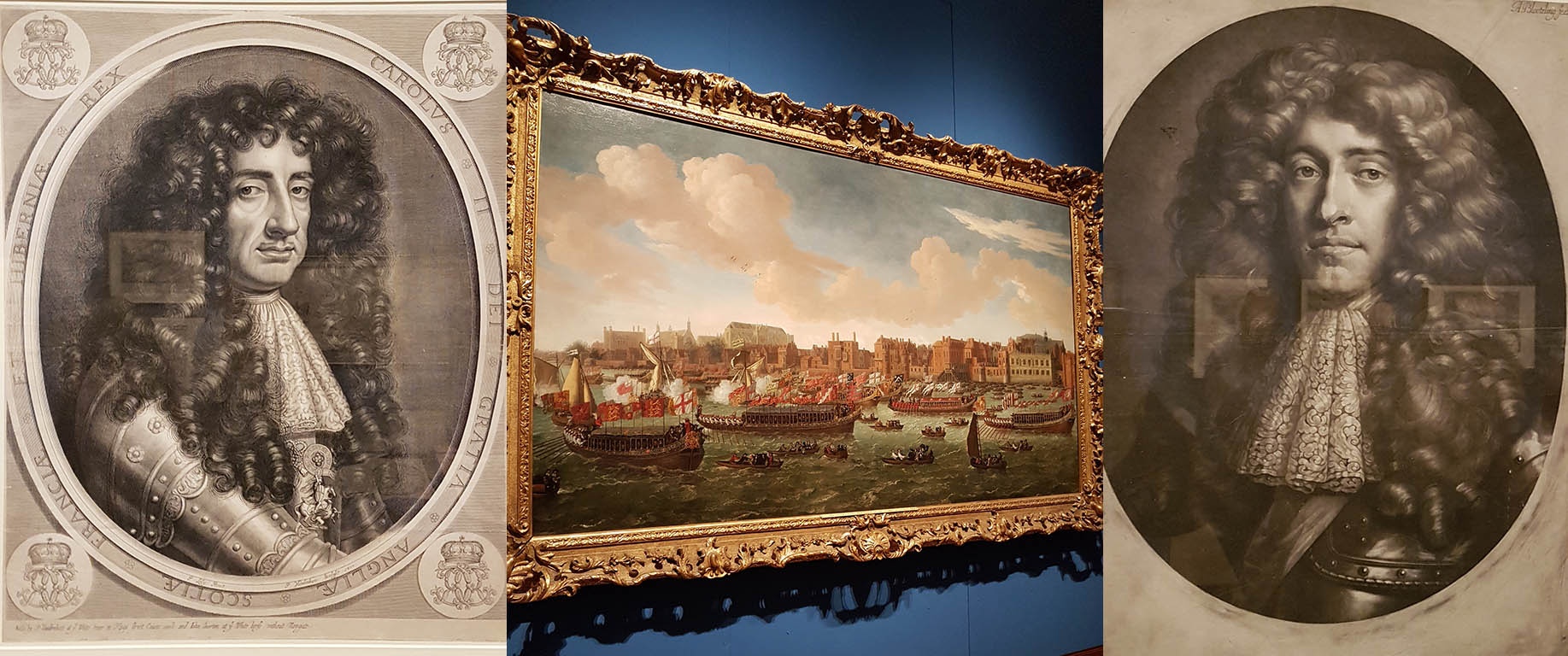
Charles and James as surviving brothers of a much larger family (with also two sisters abroad) clearly kept close most of their lives and seemed to enjoy a relationship between themselves and their children as something too dissimilar to the family life many of us enjoy today and was remarked upon at the time. It can be hazardous to transplant modern values on the past and but they settled to a bustling busy life and art played it’s part. A broad depiction of the life of the Thames, the water highway of the of London stood proudly in the gallery. Charles and James would have used it often to travel between their homes and court as many Londoners and International visitors and tradespeople would have done also. Through the painting we are drawn to imagine the life that they would have seen from their barges.
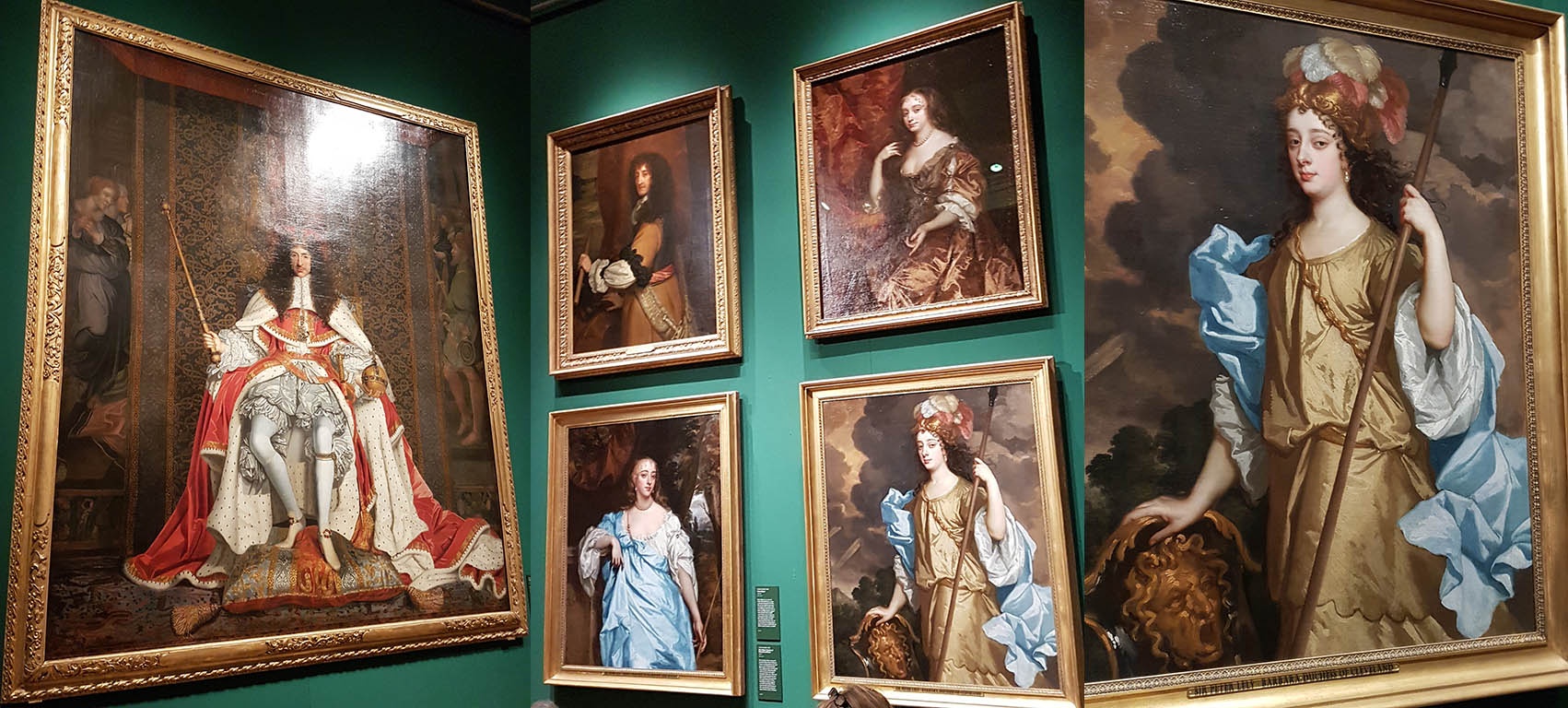
The splendid court paintings that come with the Stuart era are some of the most memorable in British history and Charles II sits proudly enthroned, back home, surveying the main room of the Queen’s Gallery. His gaze is level and like many portraits of himself and his brother James that I’ve seen, there seems to be a small somewhat smile on his lips almost looking slightly ironic when you stand to the right of the figure in the room. This could just be me but I felt like it was a moment when people say they ‘feel’ a painting watching them as they move around a room.
The Sir Peter Lely portraits of the 'Windsor Beauties' are in a beautiful genre of art portraits. Whatever the realities of court life numerous painters where able to form studios and employ teams of artisans to support them through the steady stream of court commissioned paintings. They appear bejewelled to perfection with gowns precisely folded and fit together naturally as a set. To the right Barbara Villiers is dressed as Britannia, a mistress at the height of her fragile power. Fiercely independent but dependant on the King’s good will for the ability to sustain it.
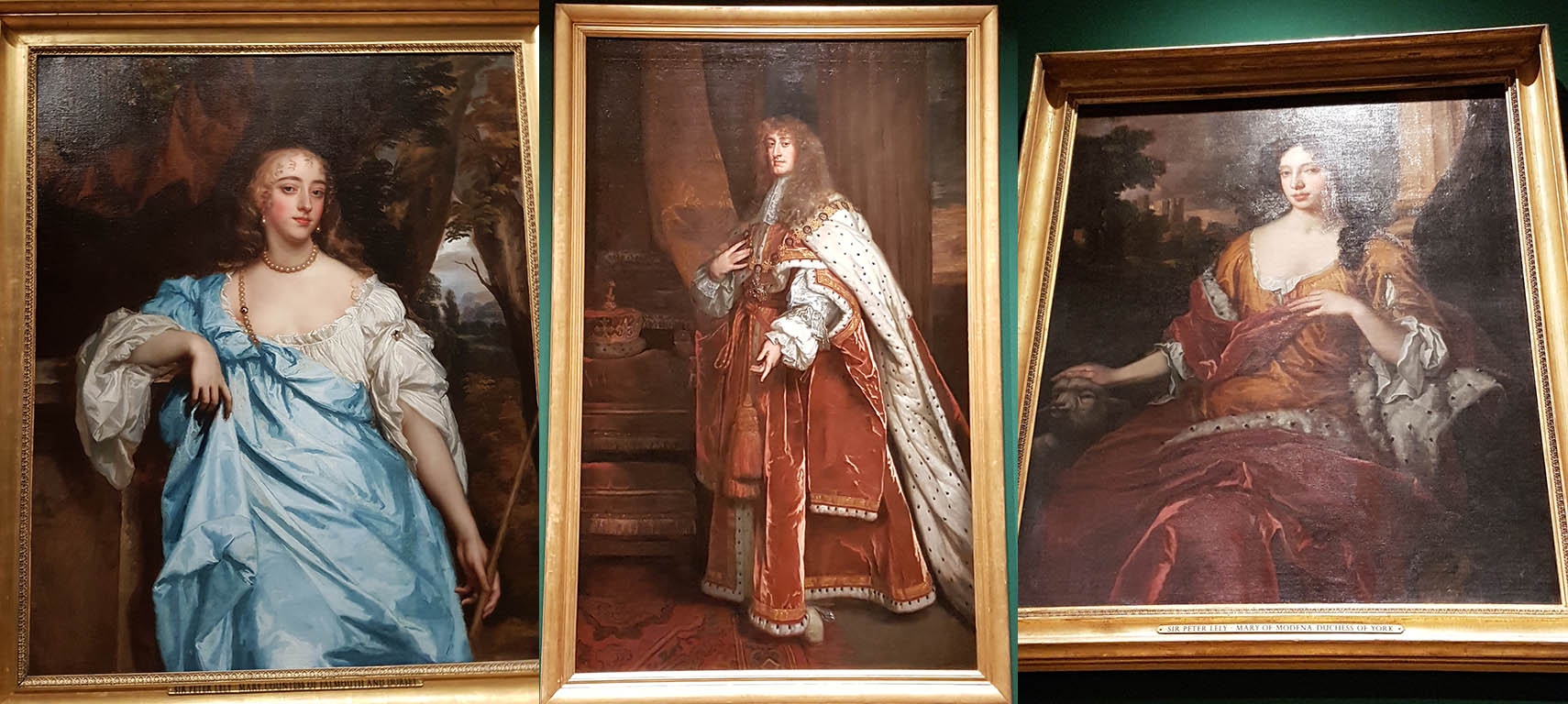
These three portraits above tell a story of how close history came to possibly running a different way. To the left Mary Bagot later Countess of Falmouth and Dorset was suggested as a bride for James II when his wife of many years Anne Hyde passed away. A widowed British gentlewoman would have been an uncontroversial choice but James followed the path of his new faith and married an Italian bride with close family connections to Rome which began to sew seeds of later turmoil. It was however a happy marriage despite a large age difference punctuated with the passing infatuations of James’s mistresses and for five generations or more their direct descendants lived on the continent in exile, and later in the 19th century quietly in Britain from time to time.
It was also notably the late Anne, Duchess of York who had commissioned the 'Windsor Beauties' paintings from Lely, creating the ultimate Royal girls club including her husband and Charles’ youngest sister Minette, the Duchess of Orleans when visiting from France. For me it was the clothes and the smiles that first drew my attention to these pictures when I was a teenager. At one point I realised that the Stuart era was the one area of British history that was never covered in any of my school syllabuses from 4-18 so with the art ‘drawing me in’ I was curious to learn more of these characters and their stories.
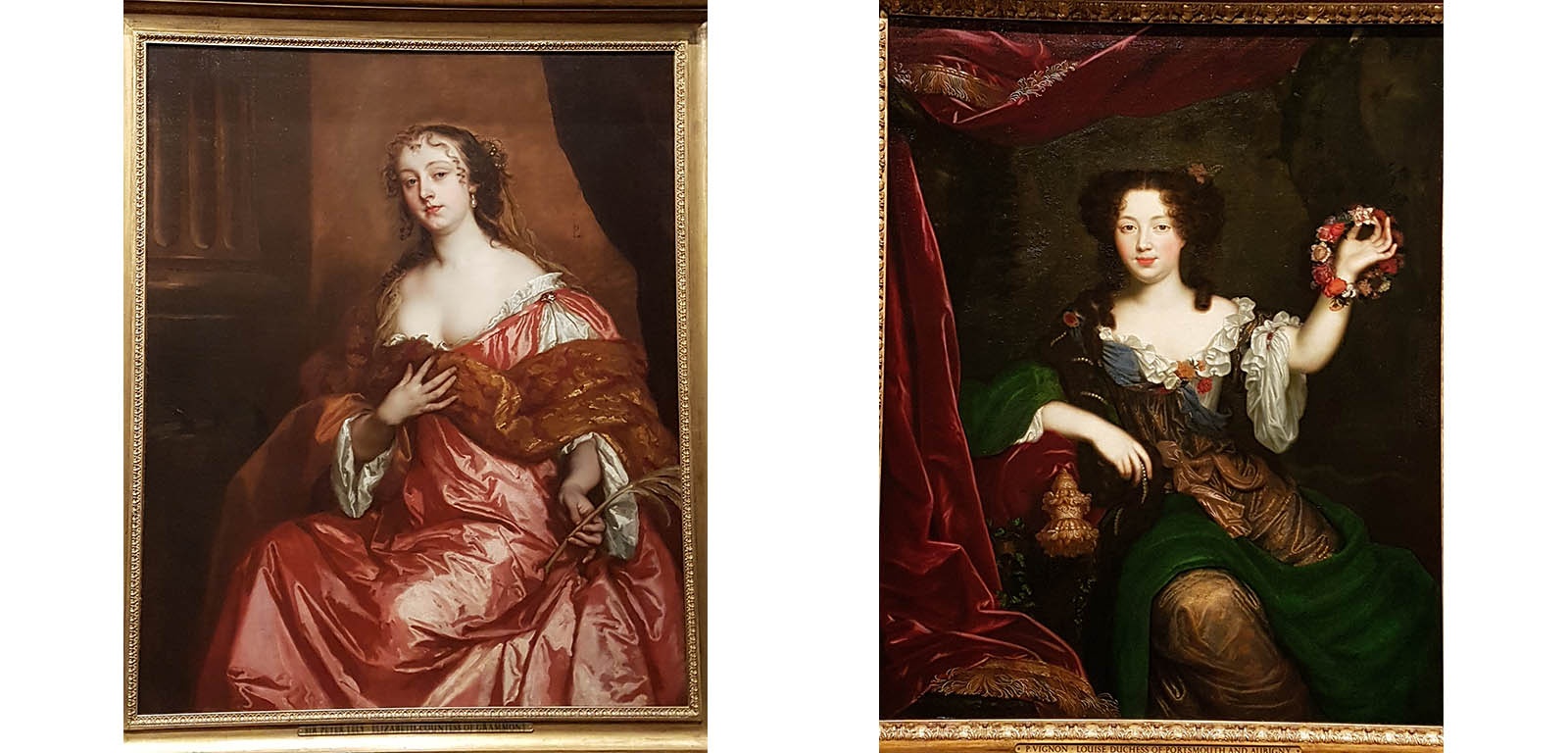
Two more portraits that capture the beauty of the period so well and create a costumiers dream. To the in the burnished Red dress Elizabeth Hamilton who became the Countess of Gramont illustrated that it wasn’t just the Royal family who could make international marriage links with a diplomatic purpose. Born in Ireland she married a French aristocrat and became a lady in waiting to Louis XIV’s wife and was a courtly friend of Minette, Henrietta Stewart married to her cousin Louis’s younger brother. We almost take travel for granted now but in the time of Minette and Elizabeth, Mary of Modena and James’ daughters, cross channel travel and the journeys of aristocrats between royal courts and kingdoms would have been an unusual experience and given them a different outlook on life to many. The paintings are executed with skill and stand the test of time with subtle charm and a hint of the wit about them that made the fortunes of the women that they depict.
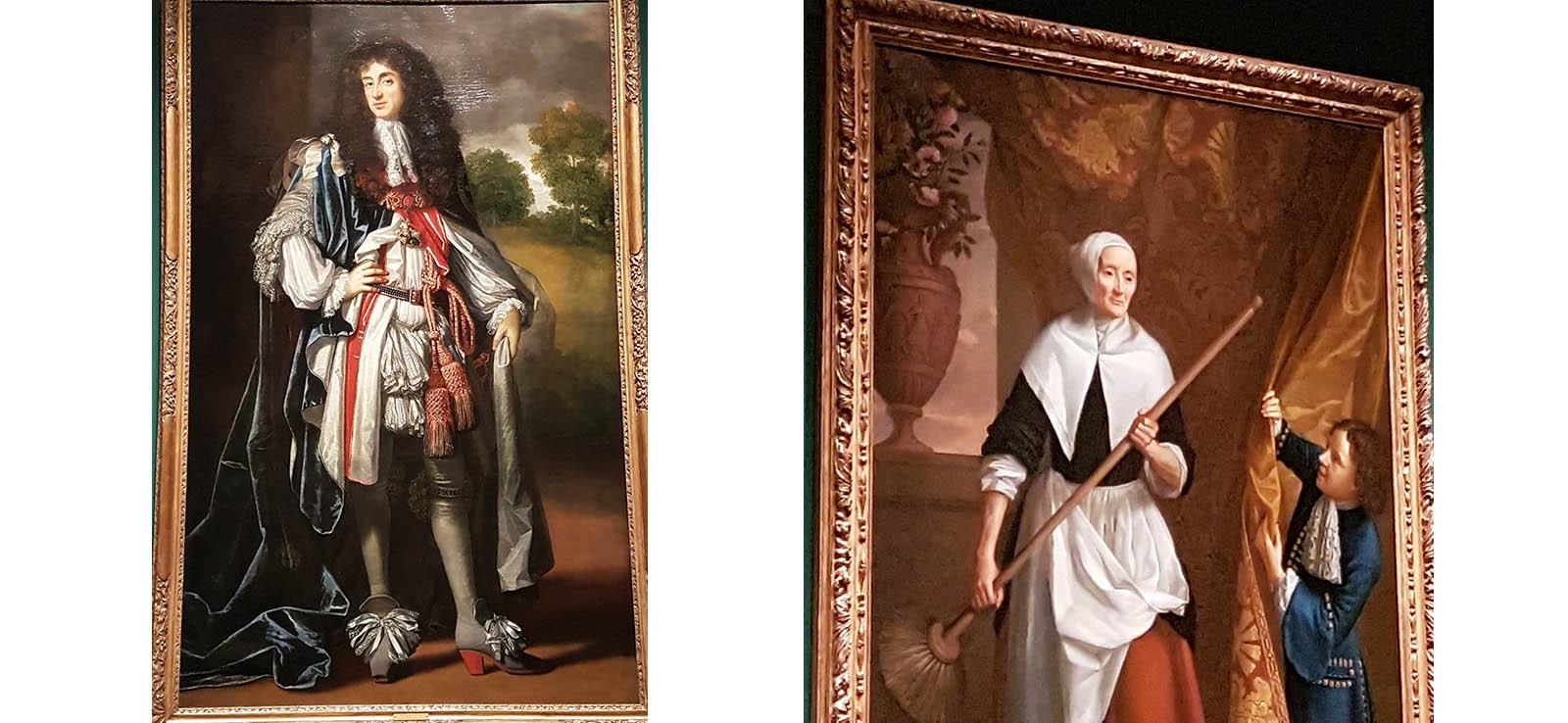
Sir Peter Lely had also painted for the Royal family in the reign of Charles I so he must have seemed like a key ingredient in the restoration mix and the Stuart family where known across generation to remember supporters. Another sign that Charles II and James II never forgot people who helped their family, as later Stuarts, was the painting of their house keeper. She was a woman who had looked after their father and possibly their paternal grandparents and continued to serve the royal family after the restoration until she passed reportedly aged over 100 years. I think it’s almost unheard of for Royalty to have their domestic attendants painted in this way and it suggests that the brothers saw beyond the hedonistic environment they lived in at court and valued people in themselves.
Fashioned From Nature at the V&A
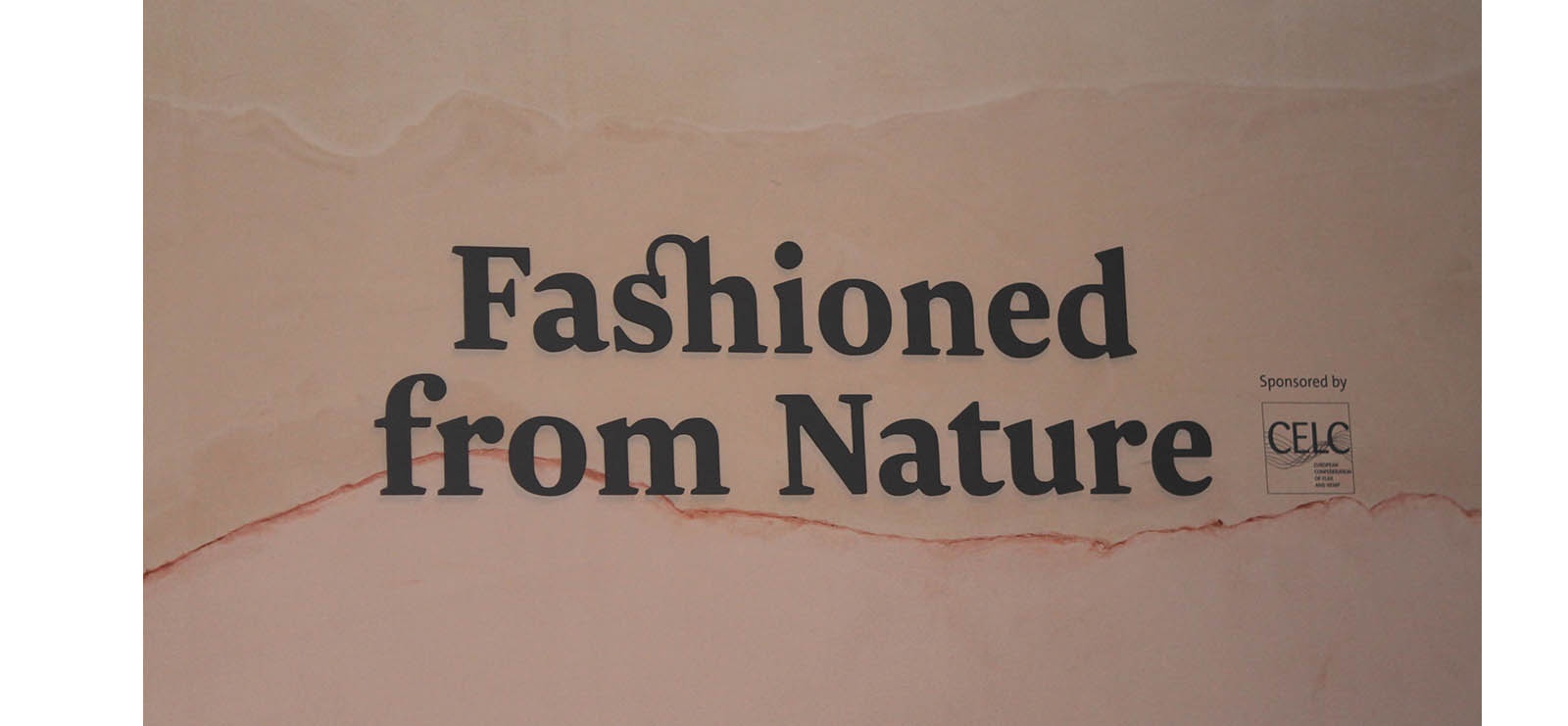
We’re all thinking a lot more deeply about the earth and the changes it’s experiencing now and the V&A chose 2018 it launch a fashion exhibition examining the relationship between fashion and the environment. Fashion through it’s use of textile has always been closely bound to the planet we live on and across tens of thousands of years the earth has provided the key elements that we have needed to create garments worn across the globe.
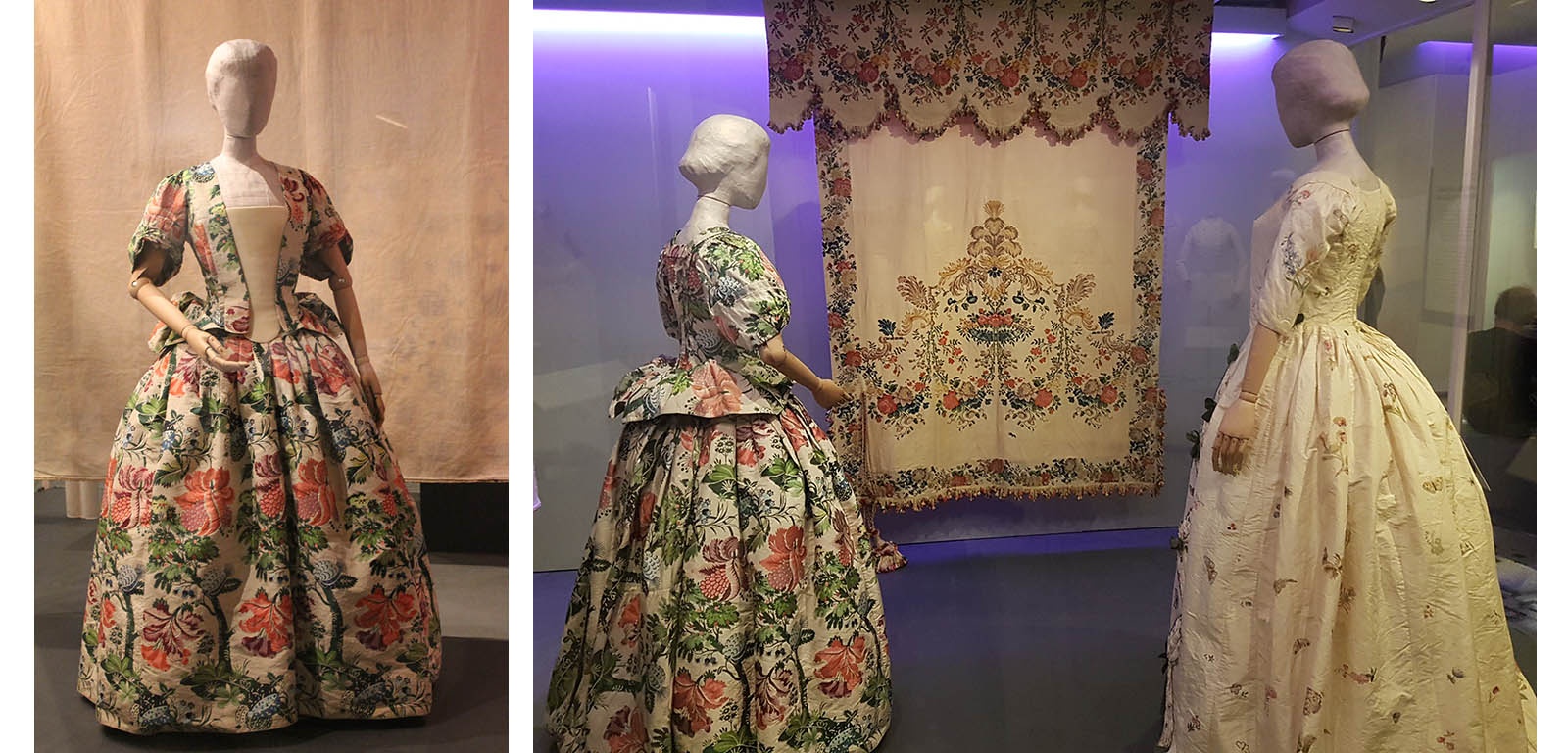
The exhibition opened with a look at some garments from the 18th and 19th century and explored the relationship between the burgeoning trade routes that facilitated the growth and expansion of the British trade empire. Above two dresses from the 18th Century show the fascination of people in seeing the vibrant colours created in Asia from natural dyes to enhance their wardrobes. In a time when women’s lives where very constrained by the custom of religion and society colour was one way in which they could express themselves and also showed the fascination they had with the wider world. Prior to the 19th century few women from the UK would travel to Asia so clothes allowed women an outlet for their curiosity of far flung places.
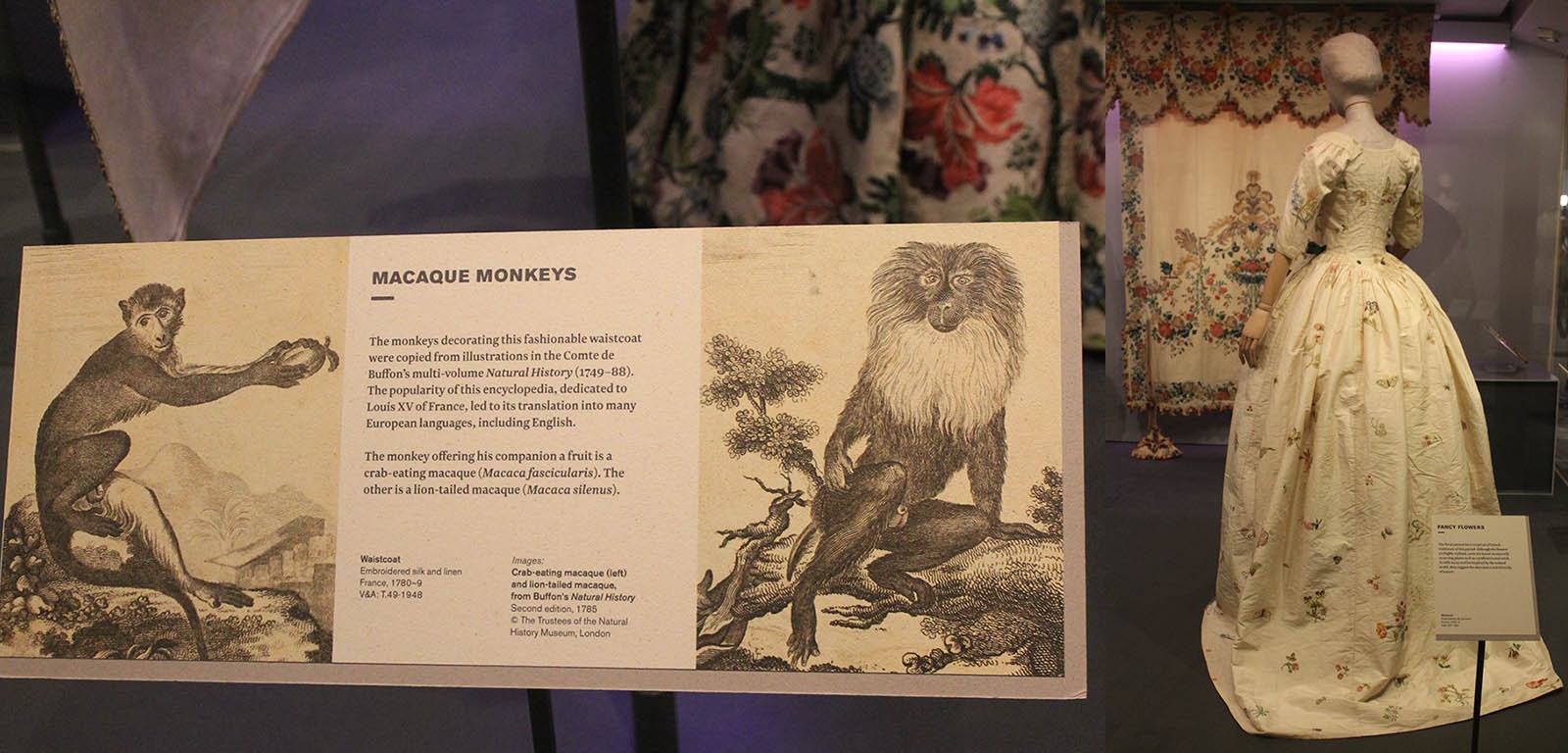
The waistcoats below were inspired by the vibrancy of the tropical jungle inhabited by the Monkey’s of Macau. The workmanship of hard working hands is exquisite and this close work would have required expert hands taking many hours to perfect the detail. These are truly works of art in their own right.
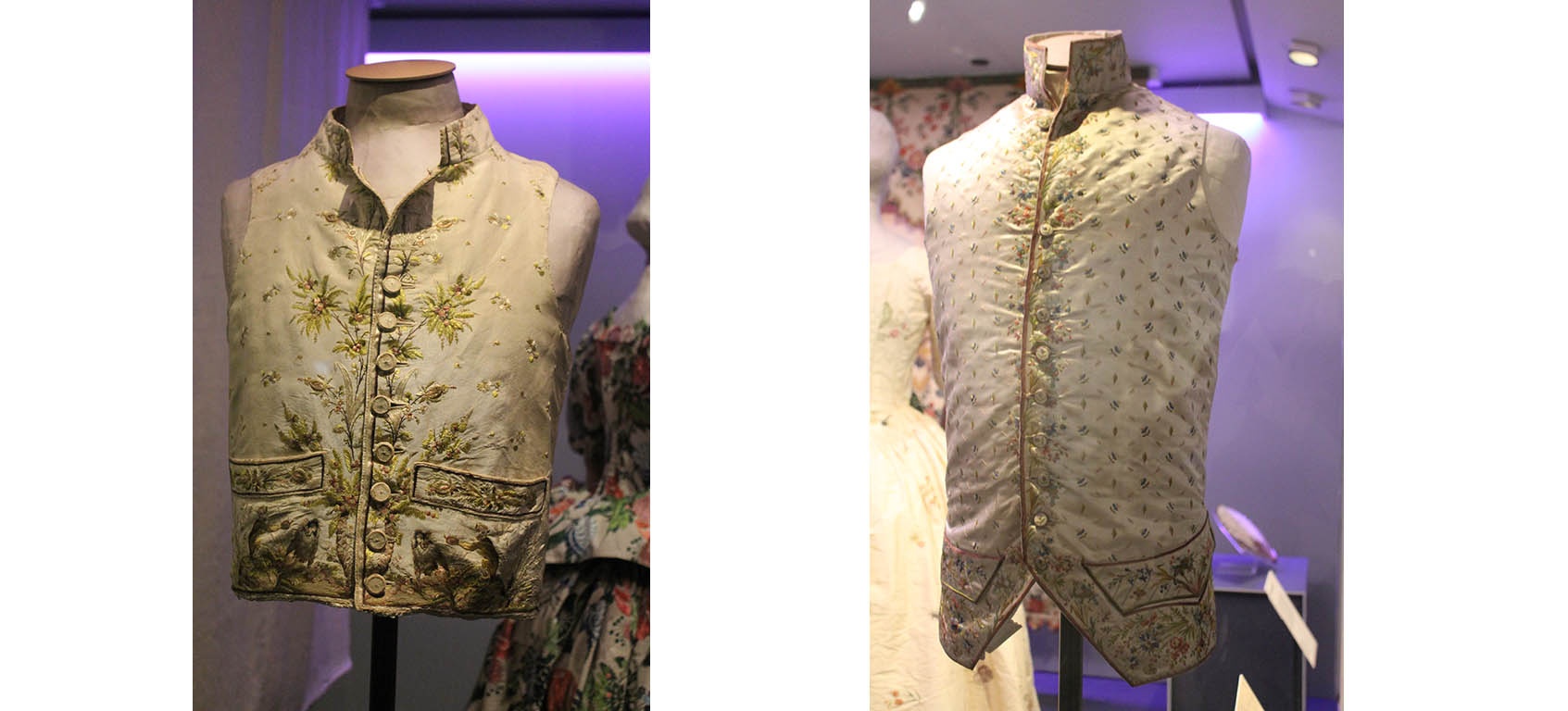
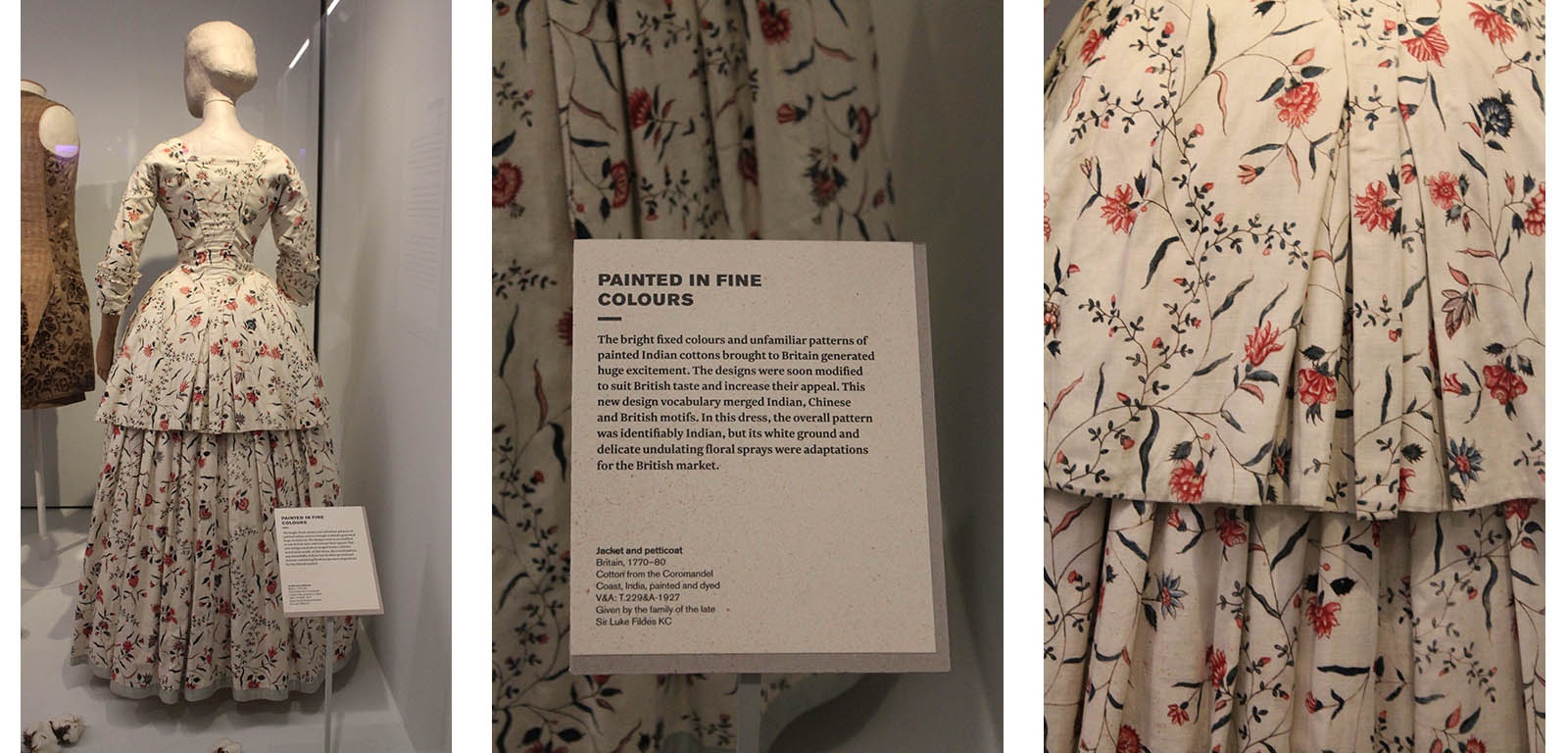
Above the right the bright colours of India painted on Indian cotton caused great fasciation to women and drapers clients through the second half of the 18th century. Above to the right this beautiful day dress would have been admired and a source of fascination when it entered the room or garden setting. Anything connected to India and China generated huge excitement and conversation.
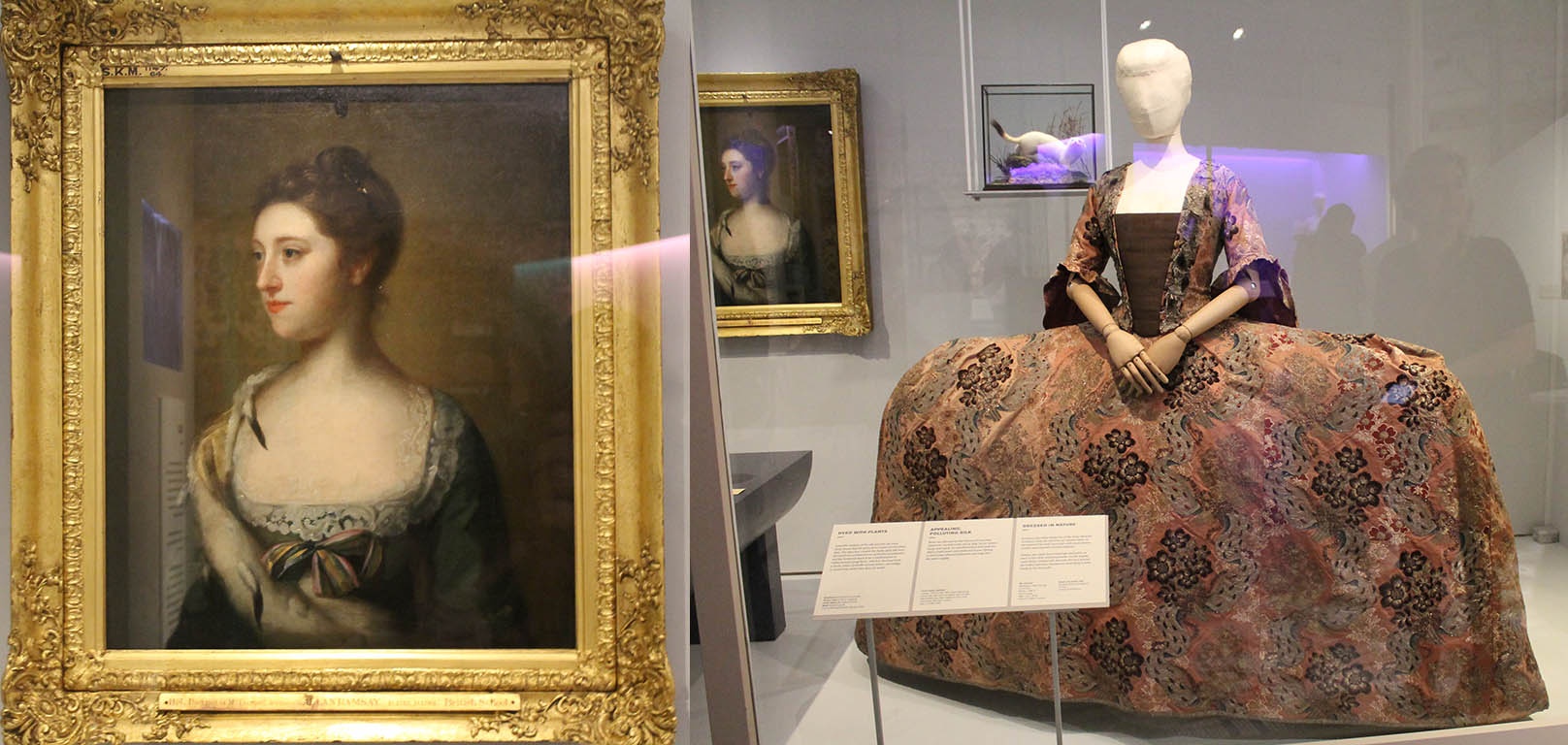
‘A Dress of World Proportions’ highlights the global assemblage of materials that could be composed to dress wealthy European and American women in the 18th century. Above a woman who would have worn such designs sits in a portrait behind a dress that is composed of raw silk from Italy, Spain and the Middle East, flax from northern Europe and Minerals probably from what is now Bolivia. The garment’s fabric itself was woven in Lyon in France. This was a piece that was light and easy to wear yet complex in it’s composition.
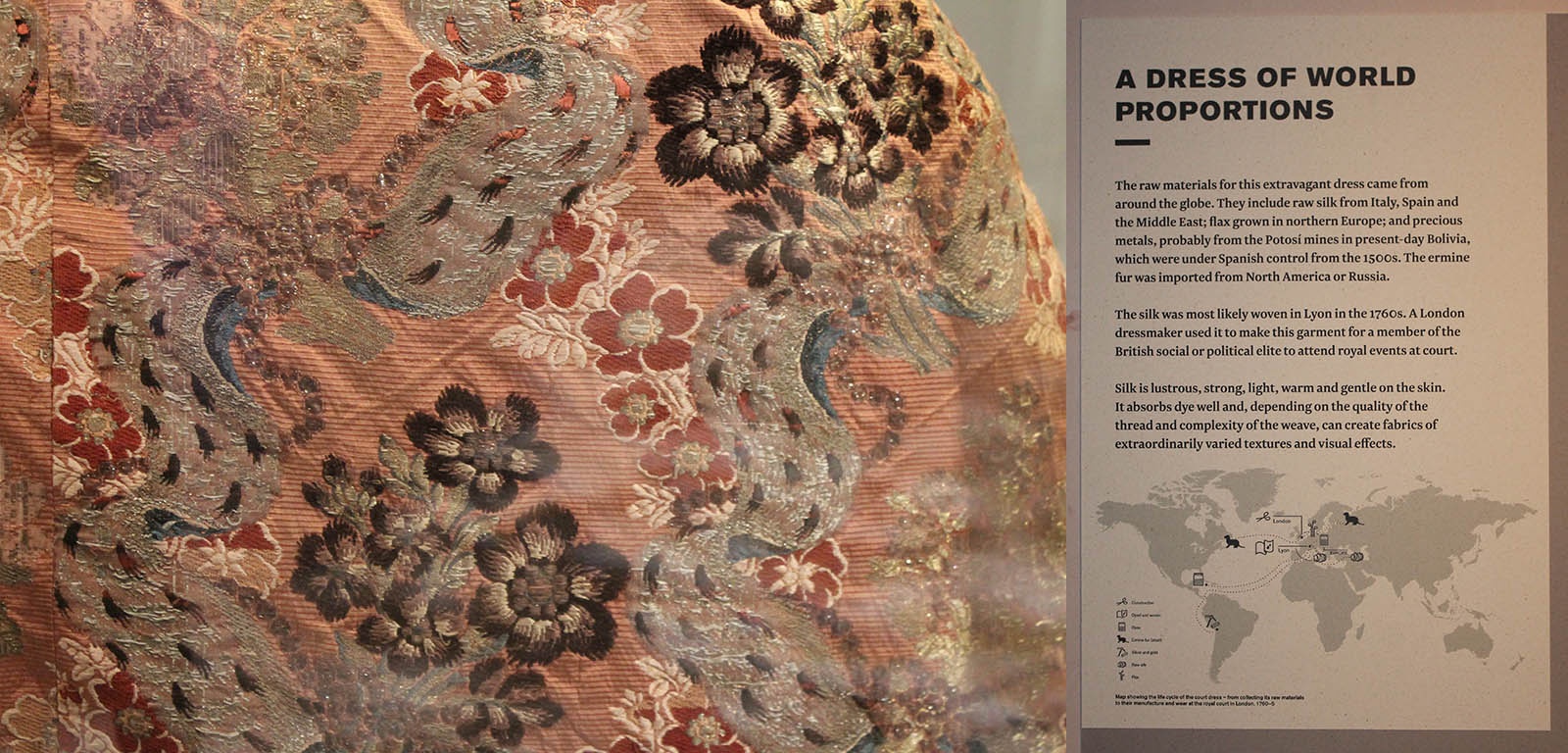
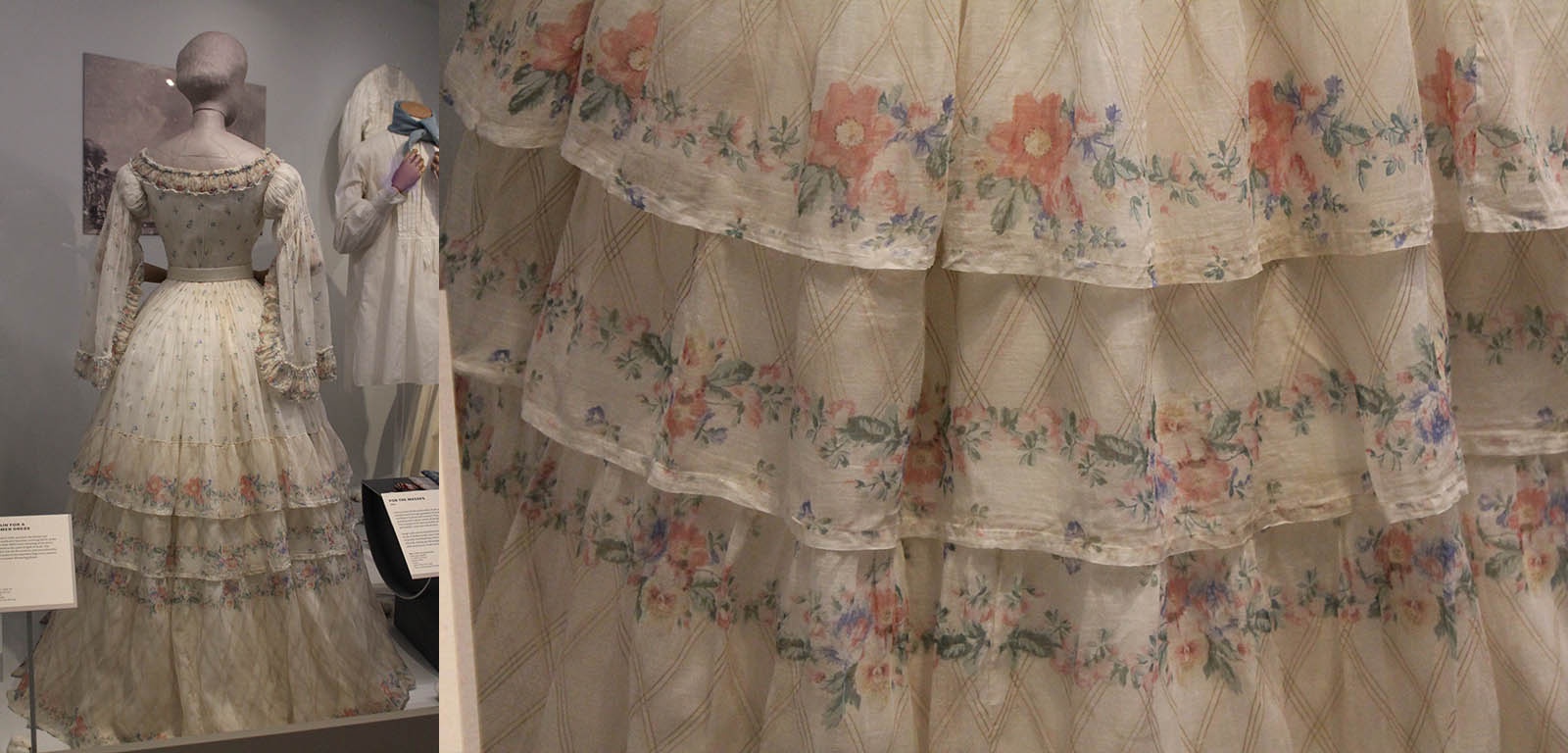
The backbone of much of the garments created was cotton and for goods coming into Britain, the most widely sourced was that from India which produced arguably the purest product for the looms. The light softness of the buds translated into delicate light florals that came into their own during European summers with soft romantic dresses created across the continent and beyond for women of fashion. The fascinating floral design here is combined with geometric patterns to give a further sophistication to the design and hint at higher quality workmanship.
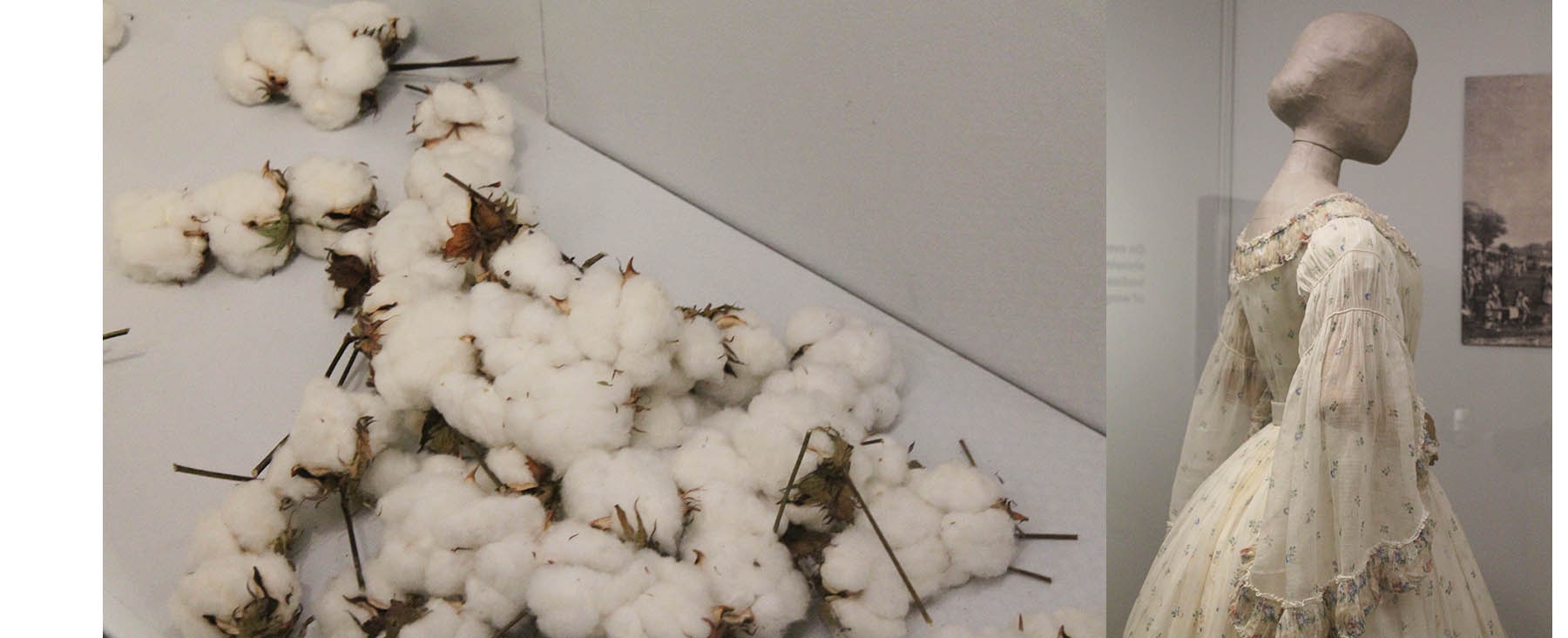
The ancient process of creating silk originating in china could travel much more quickly across the world and in the 18th century silk farming accelerated as it was increasingly spun and woven in the way that lace often was. Below you can see the intricate weaving of silk and the stages of production that transformed raw and natural silk into wearble material.
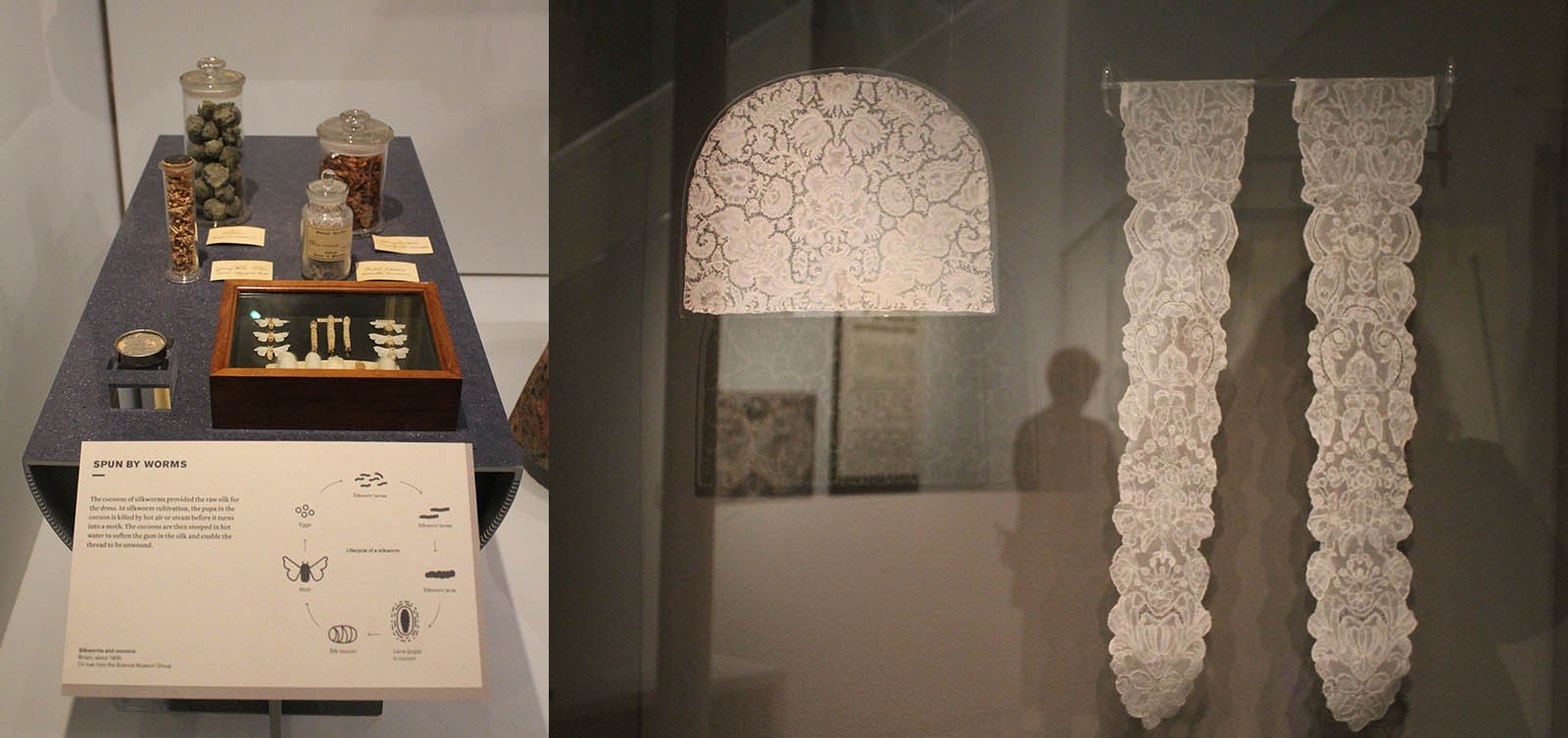
Looking further back into the 16th and 17th centuries many garments, famously some of the outfits worn by Elizabeth I that she and other noble women where painted in where heavily embroidered with a insects, small animals and flowers in a symbol of life swirling around the figure of the wearer. Snails and grasshoppers, pansies and strawberry’s, some in lightly padded quilted form emblazon the piece and bring it to life before your eyes showing nature in every inch of the surface.
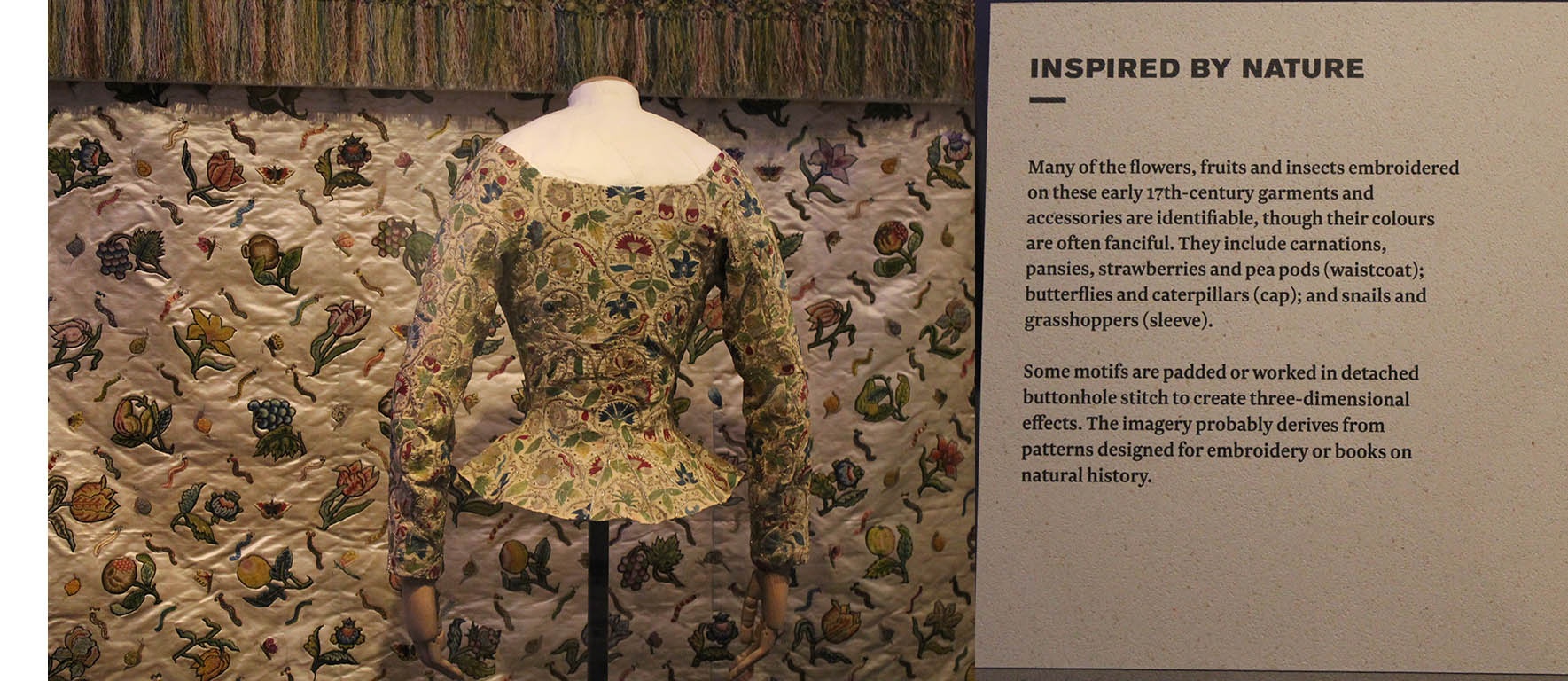
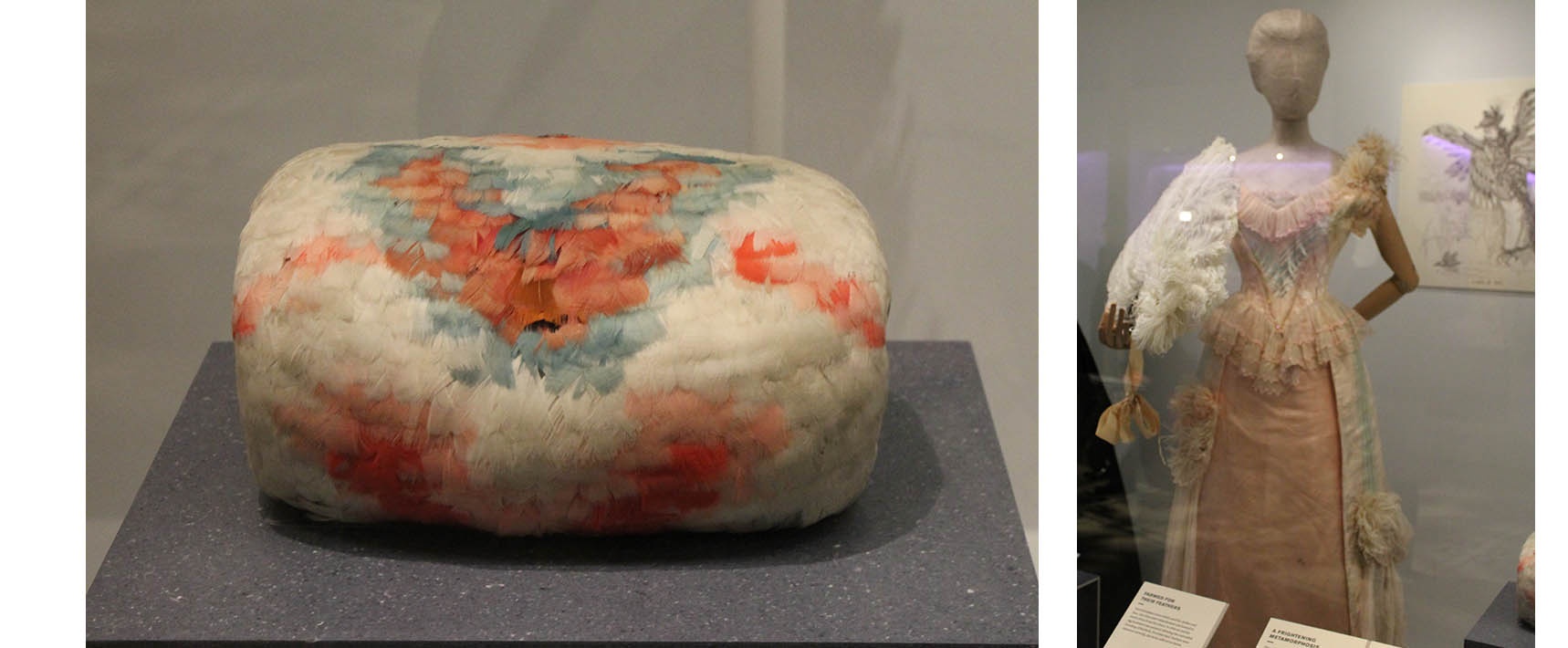
Ostrich and exotic bird feathers, a little controversial today and not to my personal taste where a mainstay of eighteenth and nineteenth century fashion. Dying techniques, not very environmentally kind by modern standards, allowed seamstresses and accessory designers create a myriad of possibilities for clients. The evening dress to the right is a classic design of late nineteenth and early 20th Century fashion. Beautiful like a jewel in itself, it wouldn’t be complete without a fan.
Below a cluster of set of fans (accompanied by a gentleman) show the exploration of nature and natural symbols that could be wrought across the surface. Fans where something almost universally owned by women and beyond the language of communication that they were used for in high society they could also display interests and cultural curiosity of the wearer showing their taste.
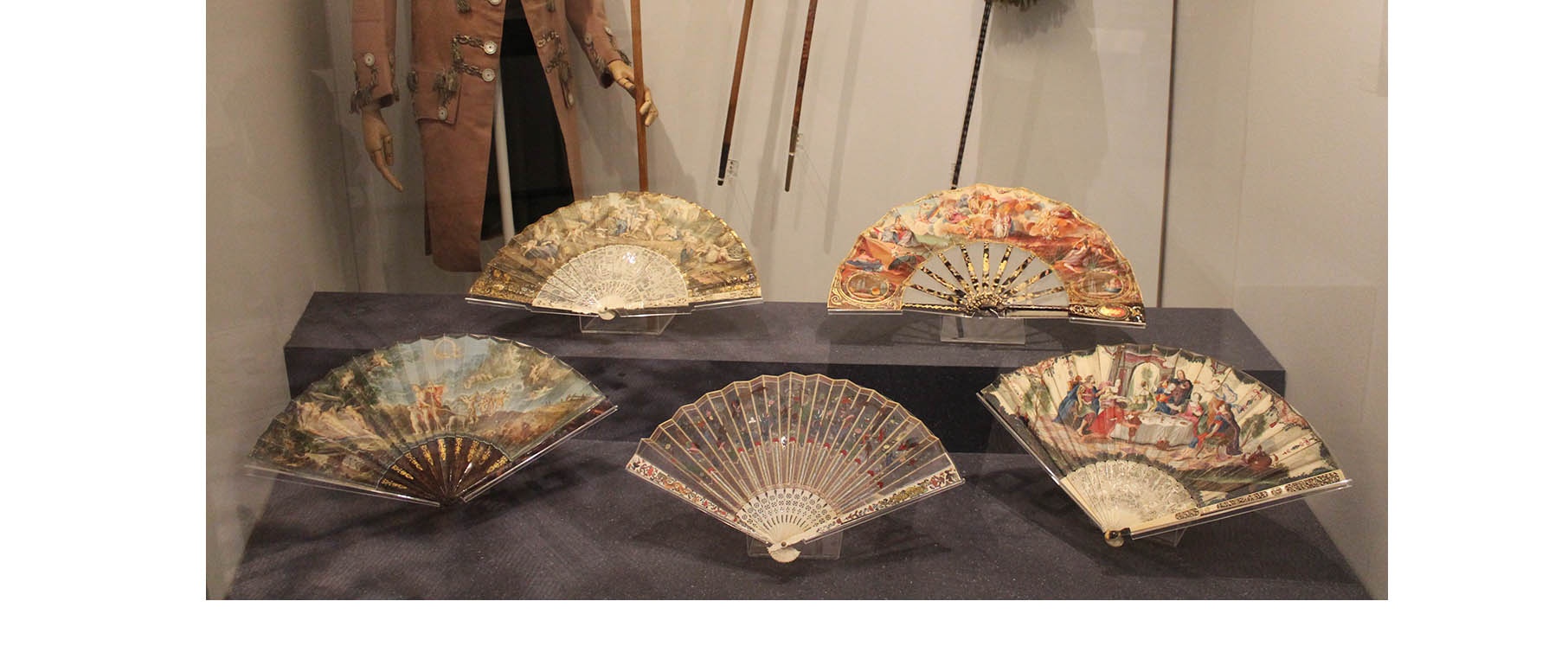
Dying technology developed rapidly through the industrial age of the 18th and 19th century but sadly it meant that the environment began to suffer the consequences at a rate gradually accelerating through towards to start of the 21st century. The myriad of colours available to clients and the strength of dyes was a huge boon to fashion and taste makers of the age but the pollution created by the industry that would also have generated much wealth, would never have been off-set or recompensed. The Purple of this dress was derived from Coal Tar, one would guess through a smelting process.
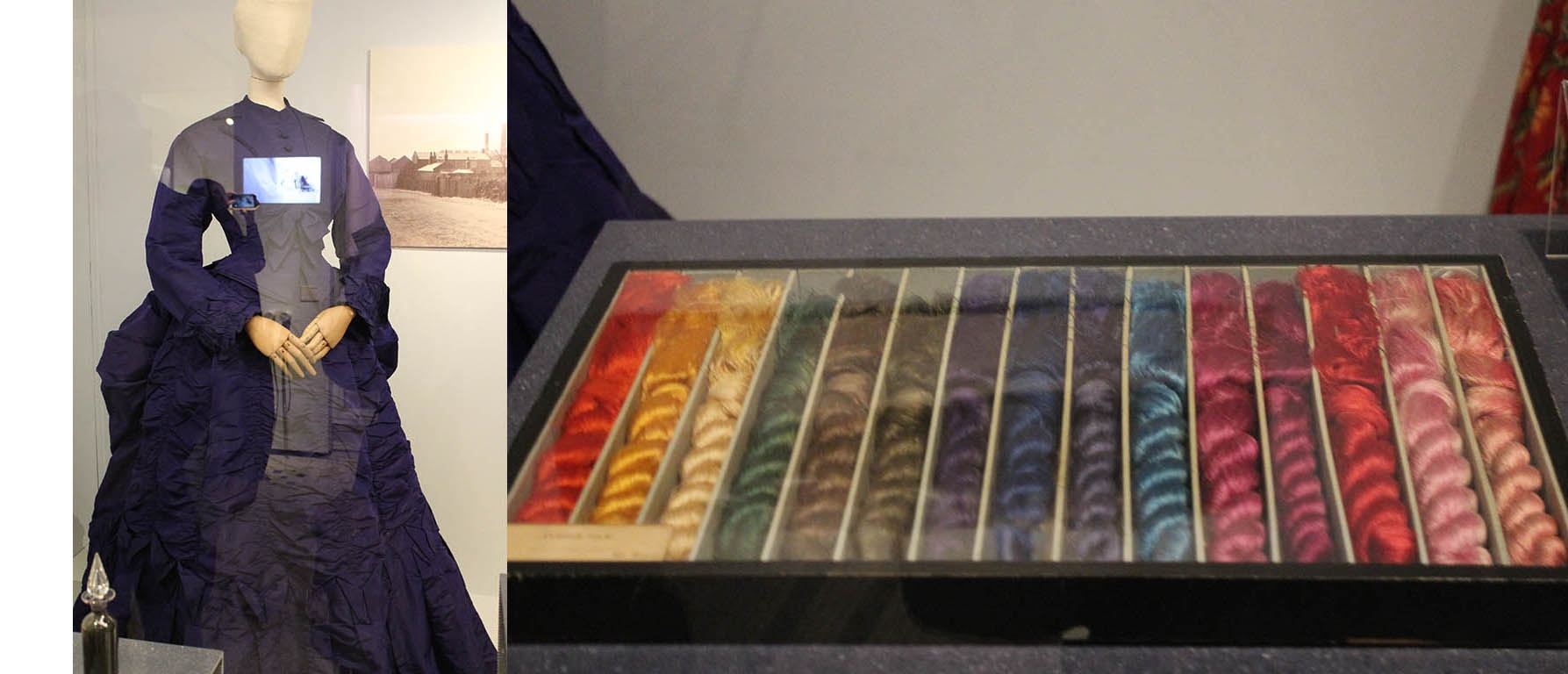
Moving forward in time we’re very keenly way of our interaction with the biosphere that we live in in a way that our very distant ancestors were also keenly aware and respectful of. A dress composed of eggs celebrates the rich natural diversity of the simple beauty of the egg shell, that fountain of life that seeds creation. The evening or formal wear day dress by Giles Deacon claims to take it’s inspiration from the work of Peter Carl Faberge yet it rather than metals and jewels it seems grounded in nature to my eyes. Once again another fan below with it’s broad sweeping arch combines mother of pearl, one of the natural jewels of the ocean with the light delicacy of woven printed silk.
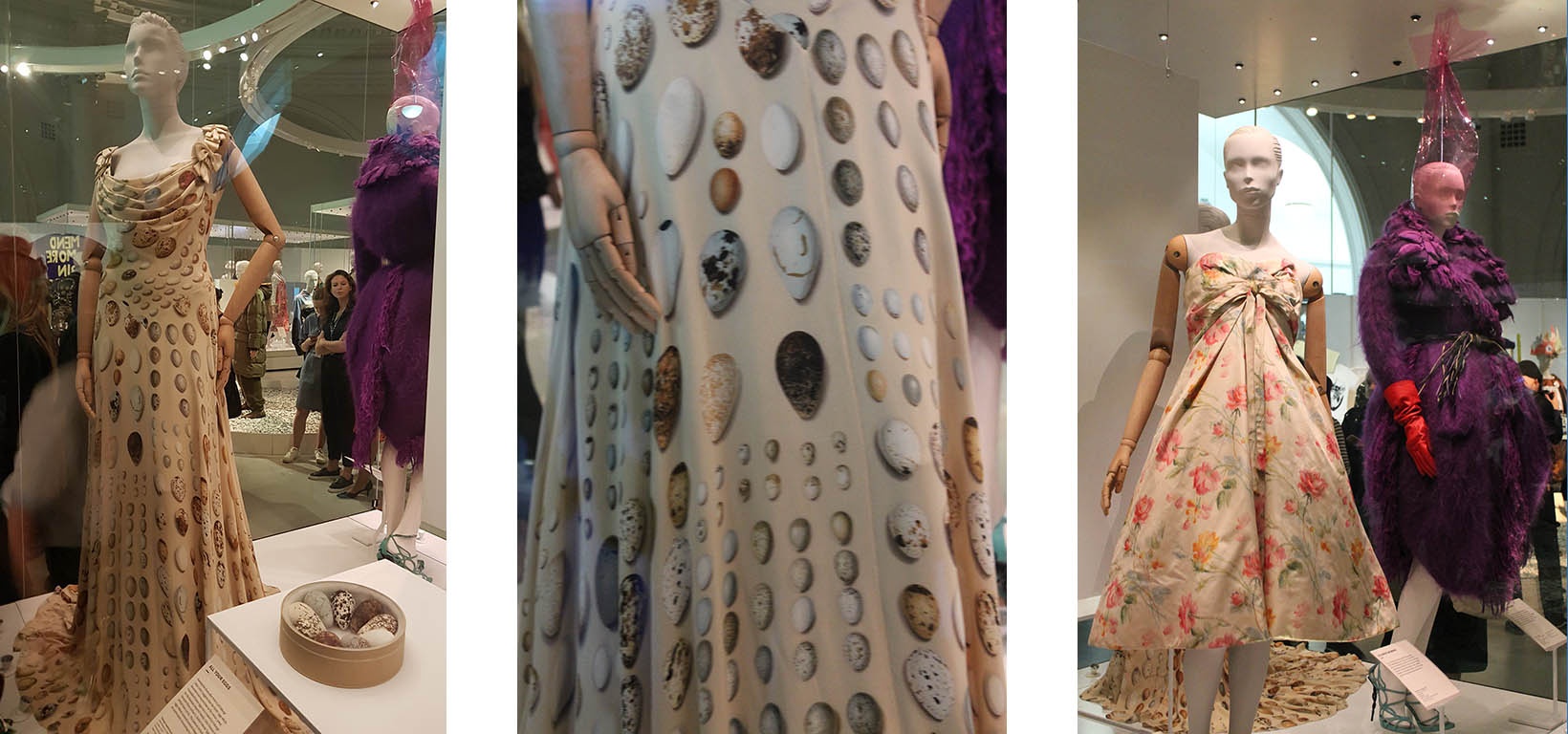
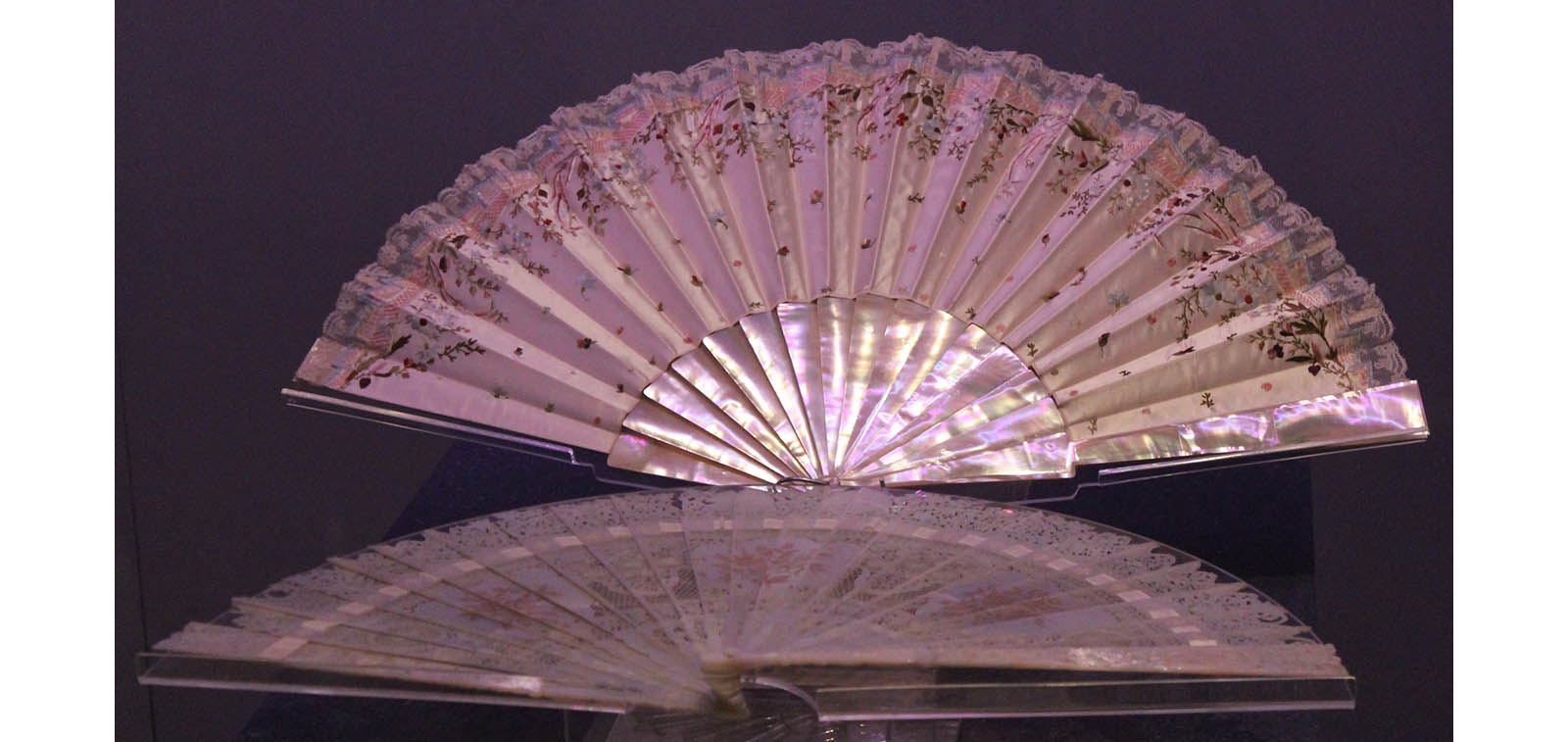
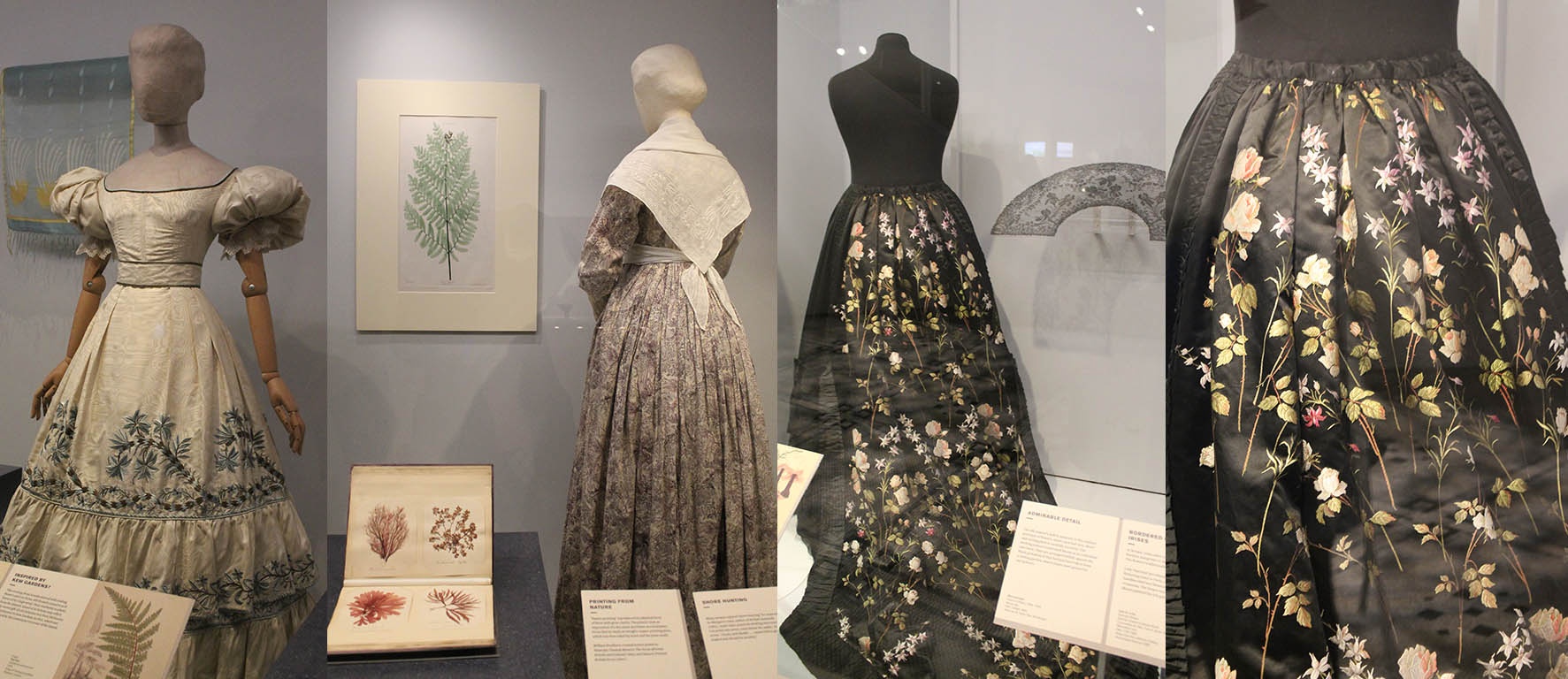
The natural detail contained in the designs above enhances the delicate beauty so prized in the Victorian era when women were expected to be ornamental largely in life and not able to show strength of character through their clothes, although many needed it. A White cotton dress embroidered with Blue flowers creates a delicate Summer time composition and voluminous shoulders indicate that the garment was possibly worn during the evening. Centre above a day dress with close set floral patterns shows the passion for translating illustration across to wearable garments. To the right a Black evening dress with richly embroidered pastel silk flowers flowing through the length of the dress shows the classic design worn for eveningwear in the late 19th and early 20th century. It’s elegant and a complex construction that would be fitting in the environment that it would be worn in. For fashion historians, admirers and costumiers of today, it’s absolutely fascinating.
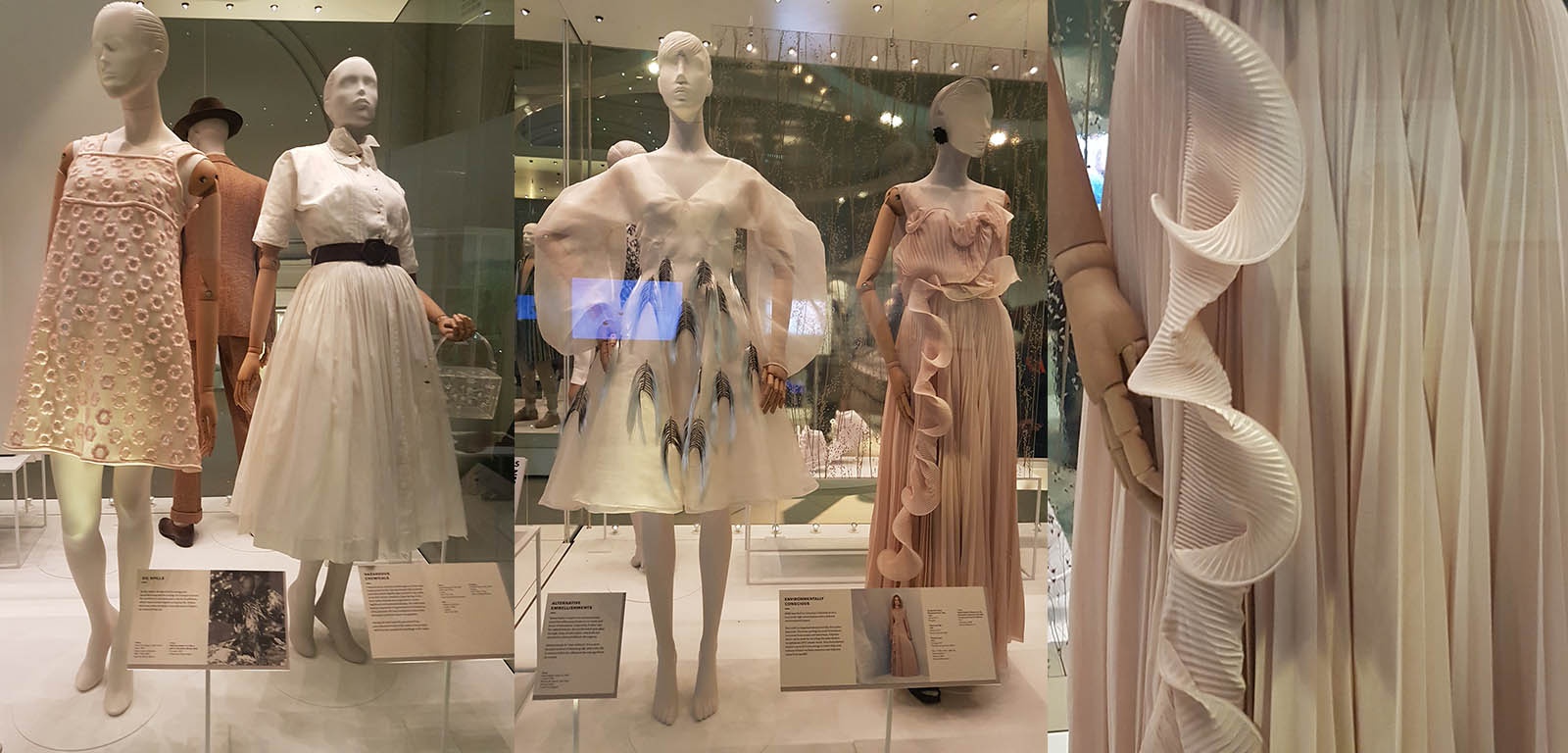
The use of petrol, one of the most controversial fuels in the world due to it’s environmental impact, became an essential element in opening up the fashion market in the 20th Century. Extracts from petrochemicals allowed for the production of nylon and other synthetic fabrics that opened the path to mass producing textiles and fashion at much lower costs and brought fashion closer to the wider population. The above dress by Andre Coureges was the height of ‘60’s fashion. To the right a belted short dress using many gathered meters of fabric illustrates the translation of style into something more casual. An experimental approach to style is shown by play with shape and feathers across a White silk dress shell appear to replicate the air as feathers fly through it in the breeze. The waves of nature, in sound, air and clouds ripple down the side of a dress that could be worn at formal events and engagements. This dress is from the environmentally conscious collection produced by H&M in 2012 and illustrates two key points, that high fashion worthy of the Red Carpet can be found on the high street and that fashion high and mass market can be produced with a sustainable ethos.
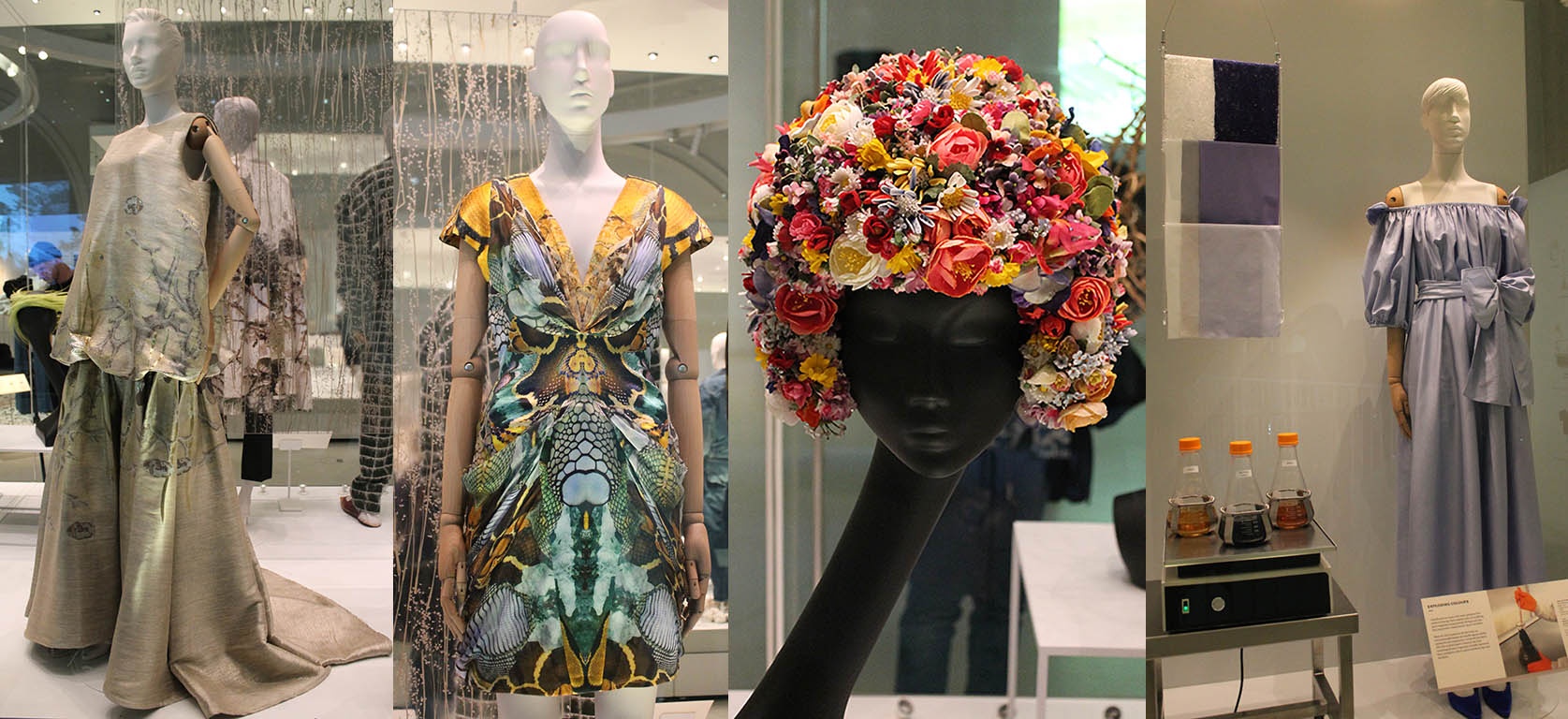
The ‘Underwater’ gown by Zac Posen produced in 2007 illustrates the beauty of nature in form of the movement and shape of waves around the figure. To the right a piece from the last full collection by Alexander MacQueen themed on Plato’s Atlantis. The intricacy of the print work is astounding and testament to the power of fashion to be a voice on many issues. The dress above features land submerged by global warming and humans evolving to live under water. To the right, the floral helmet created by Philip Treacy in 2016 forms a dichotomy between strength and supposed fragility in the make-up of the design. The bright colours indicate a strength of confidence and frame the face beautifully. Synthetic colours created from chemical aldehydes are a central part of modern fashion but looking to the future, there is a growth in interest in natural sustainable dyes that can be produced a little cost.
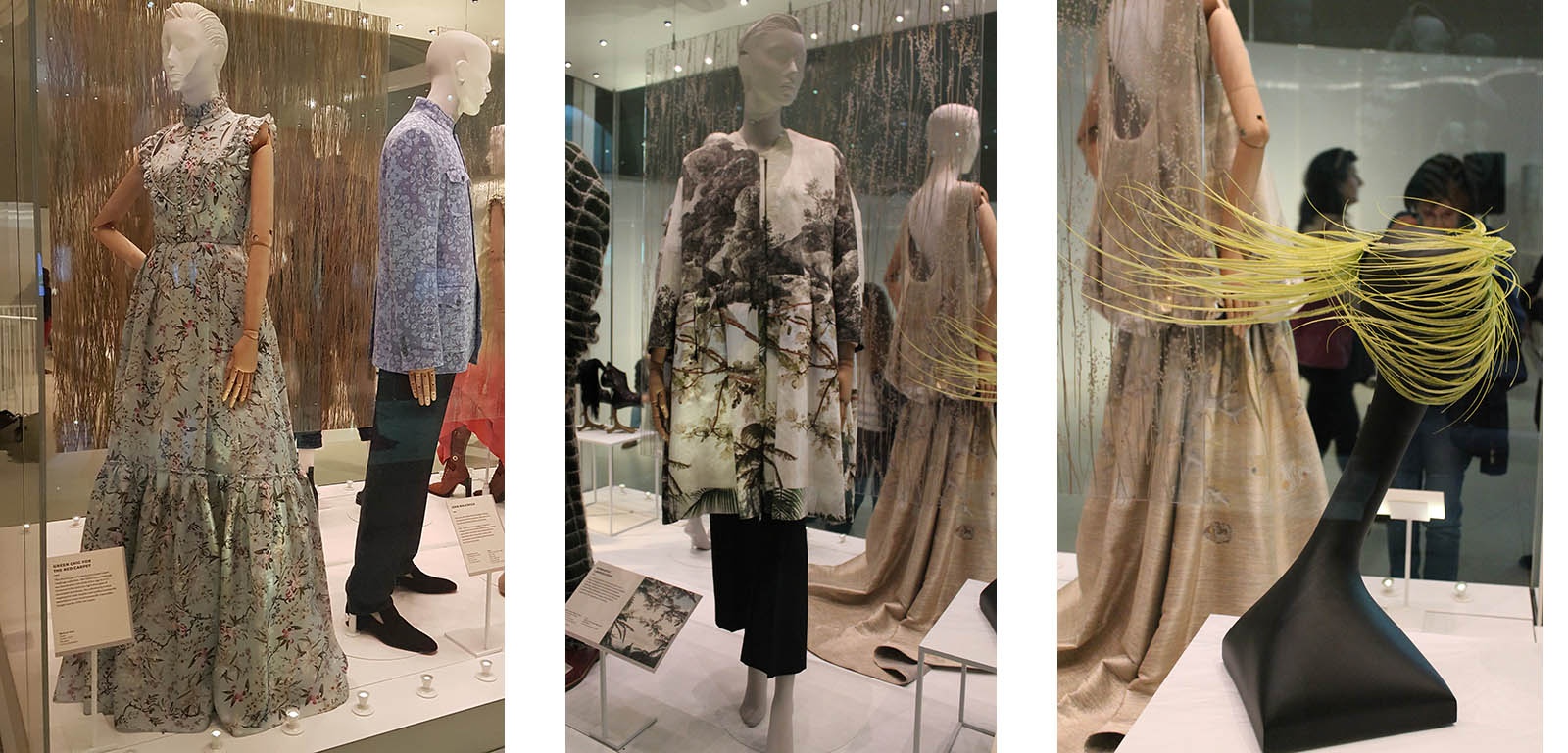
This dress above to the left was created by ERDEM in 2010 for Livia Firth’s Green Carpet challenge and symbolises high fashion taking it’s place in the Eco Age. We need a lot more Green Carpet events to push forward fashion’s ingenuity and support for change. The two printed fabrics that comprise the Dries van Noten garment above take inspiration from 18th century Chinese wall papers and textiles that celebrate an idealised version of a European landscape. To the right, ‘Bowing in the Wind by Philip Treacy illustrates the carefree beauty created in a veil by the breezes and gusts of the air.
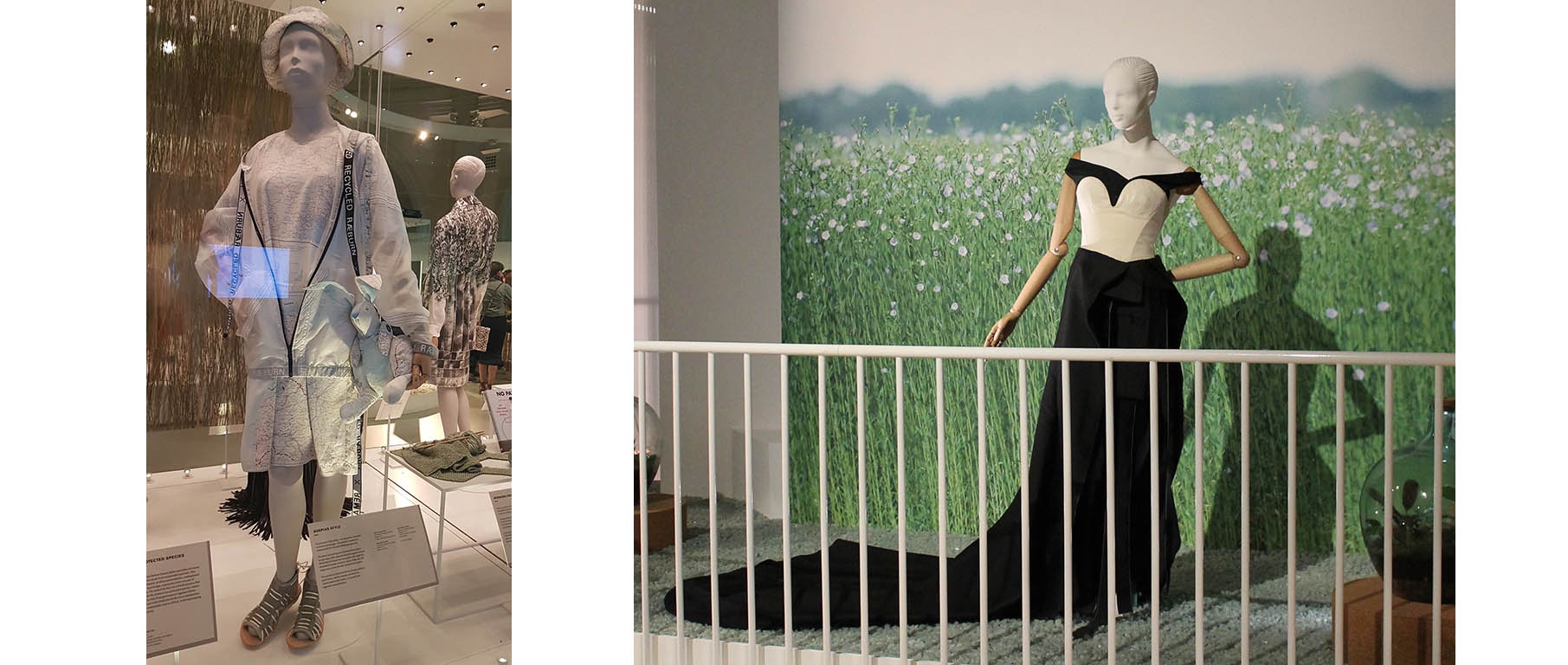
One of the designers currently exhibiting on the London Fashion Week Schedule with the strongest commitment to sustainable fashion is Christopher Raeburn. Above he showed one of his urban ware looks for which he’s become very well-known using re-purposed military textiles. Fashion had taken great inspiration from nature but I like most if you reading this I’m sure pray that in the next century it will find a way to give back to the planet instead of taking and taking as in the past.
Style at OnMotcomb
One of the many pleasures of taking a strole through north Belgravia is the charming quarter around Motcomb Street. In it’s cluster of chic boutiques, On Motcomb offers a rare glimpse of a multi-label Ready to Wear and Haute Couture ordering service that shows dresses from internationally famous design houses from Oscar de la Renta, to Zac Posen and Alexis Mabille.
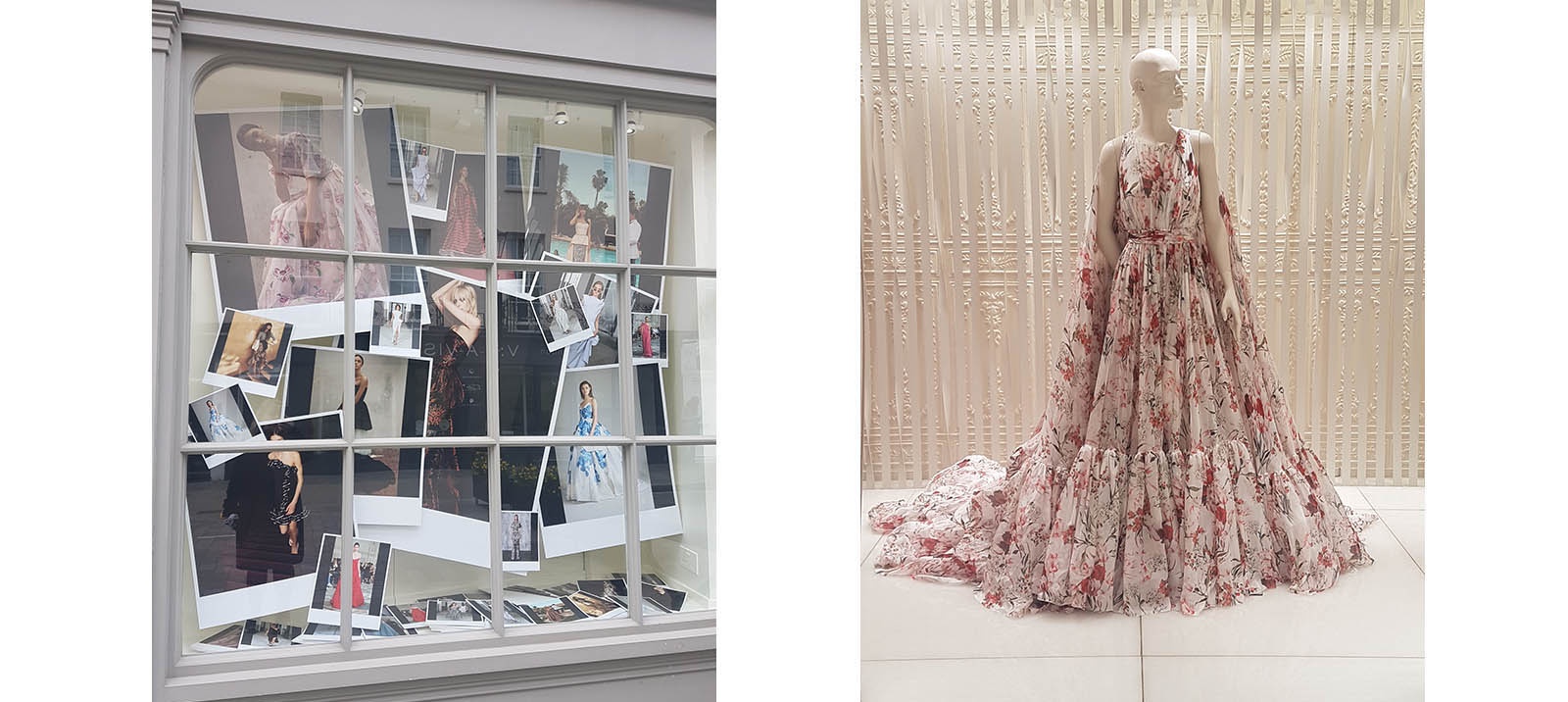
On Motcomb is a boutique that designers and clients both enjoy and the window display of editorial and campaign photo shoot images illustrated it’s place in the affection of the industry. To the right, the centre piece gown greeting clients as they entered was by Giambatista Vialli. Cut in one of his signature broadly flared dresses. Floor length with a deep hemline, the dress is composed of abundant fabric patterned in bright florals leading with a Red tone. To add maximum glamour impact a long train falls behind the wearer as the walks and the floaty piece is set to make an impact.
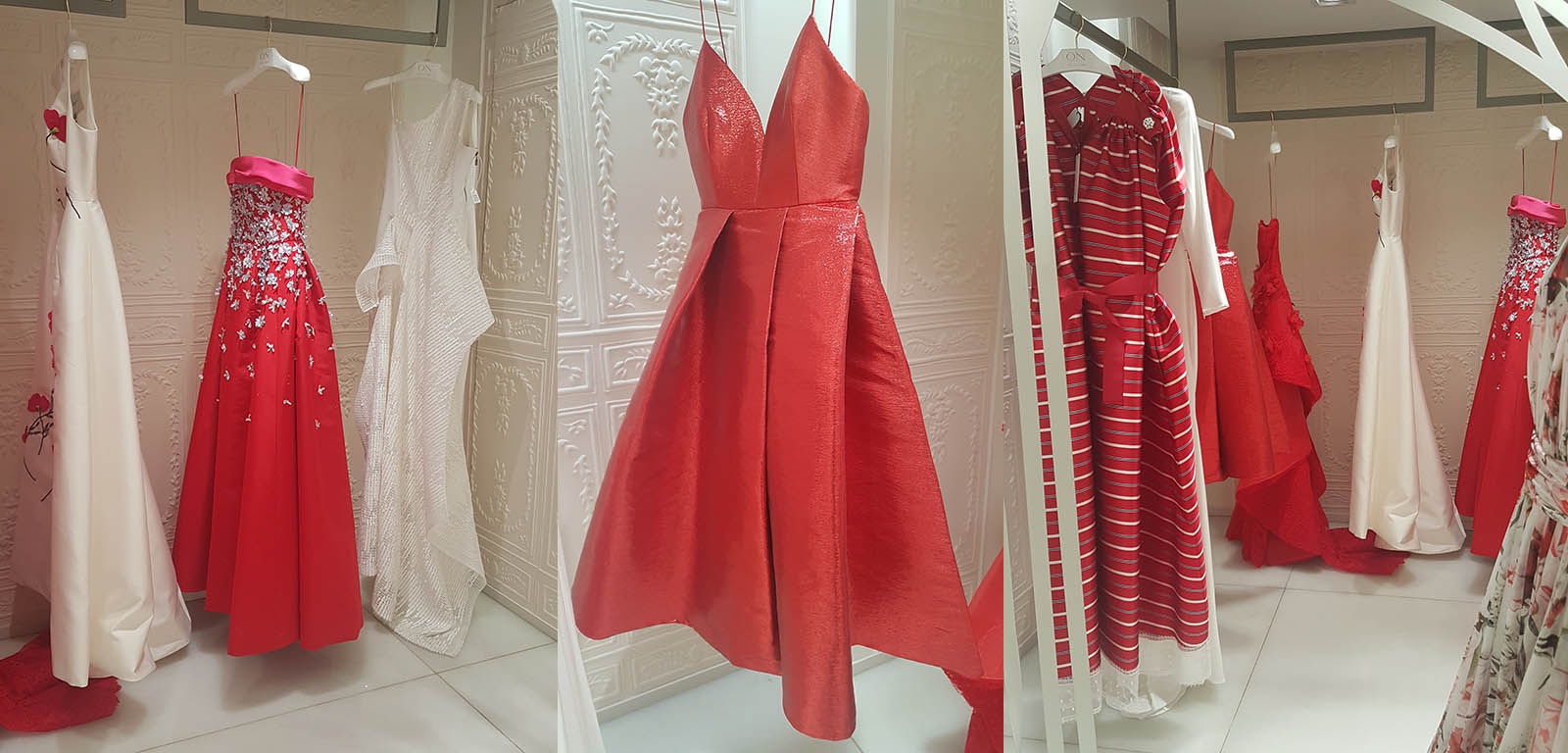
Dresses are arranged by colour themes and the span of designs on offer is highlighted by garments being hung side by side with subtle style contrast. The rails of Red and White dresses above offer many different looks to suit different figure shapes. Most of the dresses are sleeveless but could be combined with a jacket or wrap for more formal occasions. Bold statements are popular with floral designs, applique embroidery or simply through a strong note of colour. Stripes are also a possibility for less formal occasions.
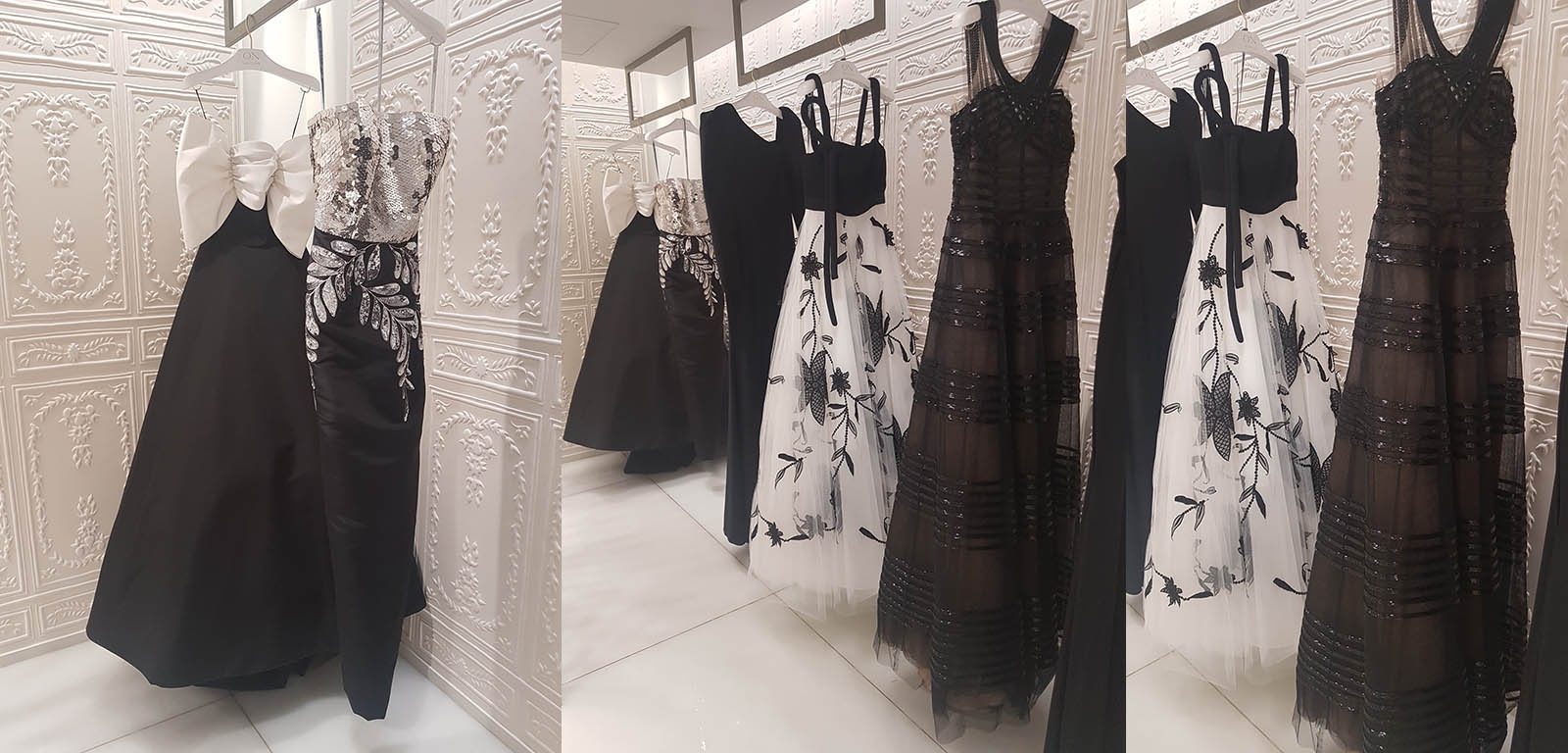
The Black and White rail showcased some beautiful styles fitting for Black Tie events. A bow is transformed to create a feature across the bodice of a gown with sashes at the side above a large A-line Black floor length skirt. Extra fabric creates a train behind the wearer. A shimmering bodice branches out into flowers across the lengths of the Black silk skirt bring a nature element to the design. Several of the looks in this series also feature the same with a Black bodice giving way to a flowing White tulle skirt also embroidered with foliage suggestive of the life giving power of feminine creation. For formal ball all year round it would be a versatile piece to own as would it’s neighbours either side in full Black. A Black dress with light panels in the sheer outer layer to the right of this frieze of looks timelessly classic.
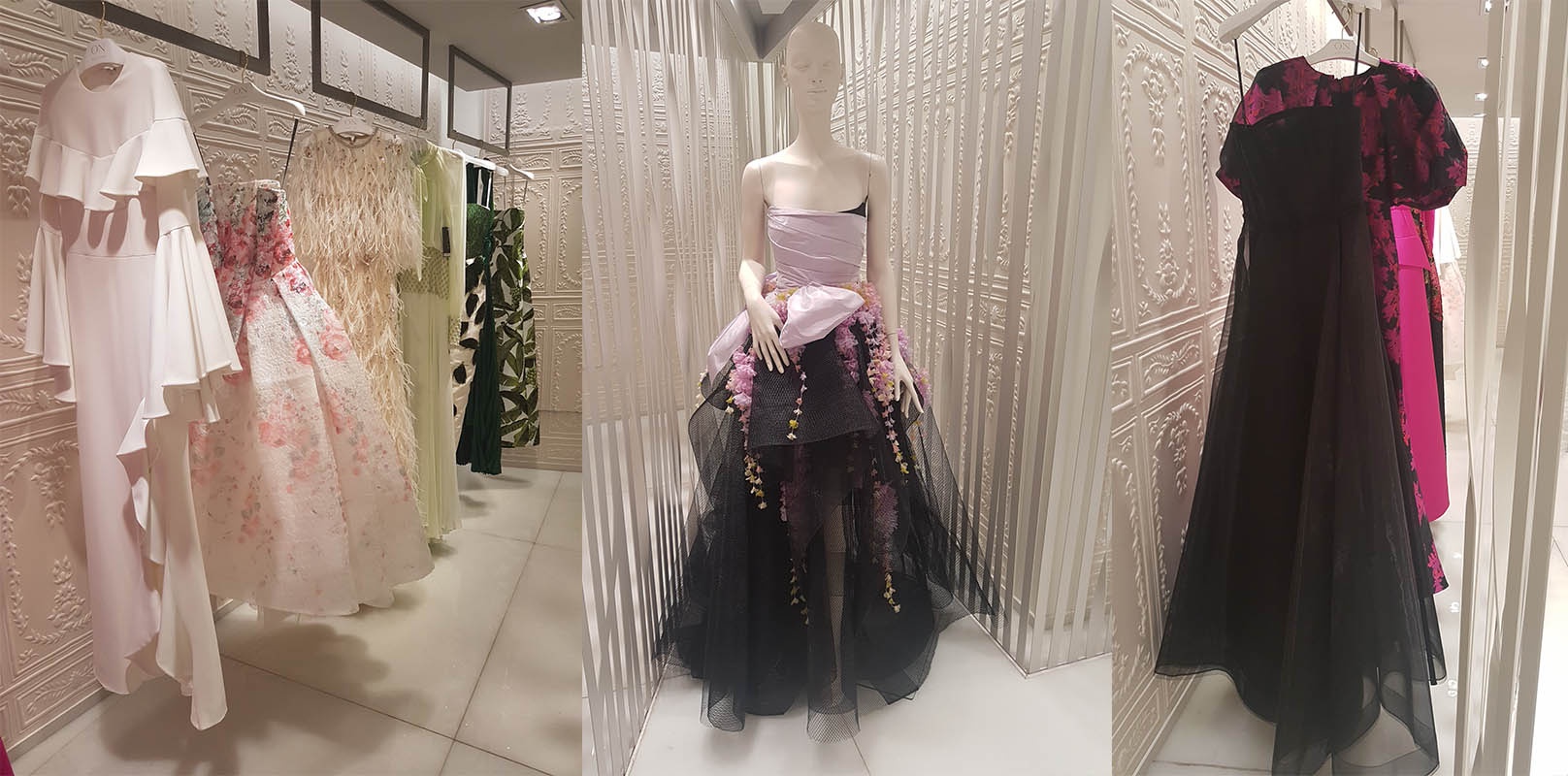
White opens the series of looks on the next rail with a beautiful White dress with peplum tiers at the lower neckline and sleeves expands the feature to the marine like ripples to the swirling wrap hem. Behind it a broad skirted floral cocktail dress evokes 1950’s and 60’s rock and roll chic with bold colour at the bodice in foliate Green and Rose Red. Centre above a carefree with an open tulle layered skirt embroidered with flowers descending across the figure. A Lilac sash at the waist grows from a wrap-around bodice. To the right another series of dresses in Black and Magenta offer year-round style options and will make a stunning colour entrance on cooler evenings.
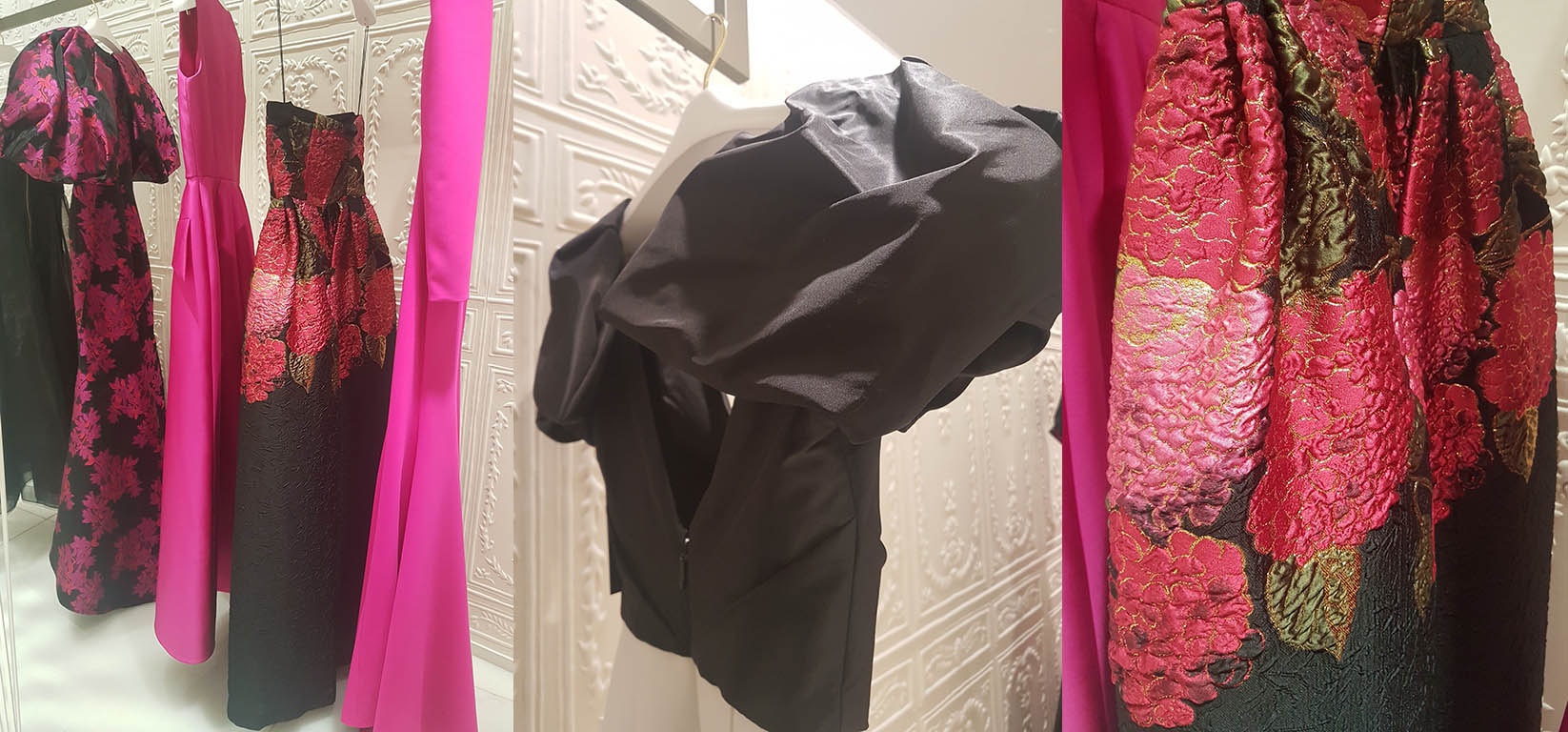
A simple Black dress is almost universally adaptable with a counterpart in bold Magenta (familiar colours themes to me) also creating a wardrobe classic. You can see in close-up above some of the rich elaborate embroidery detail that makes the garments truly masterpiece items to treasure. It’s of course up to the individual how they use they dresses, some women will wear them only once by I quietly try and encourage clients to build collections for themselves and daughters, goddaughters or granddaughters or pass clothes on to friends. Generosity is sustainable and it also preserves design classics for future generations.
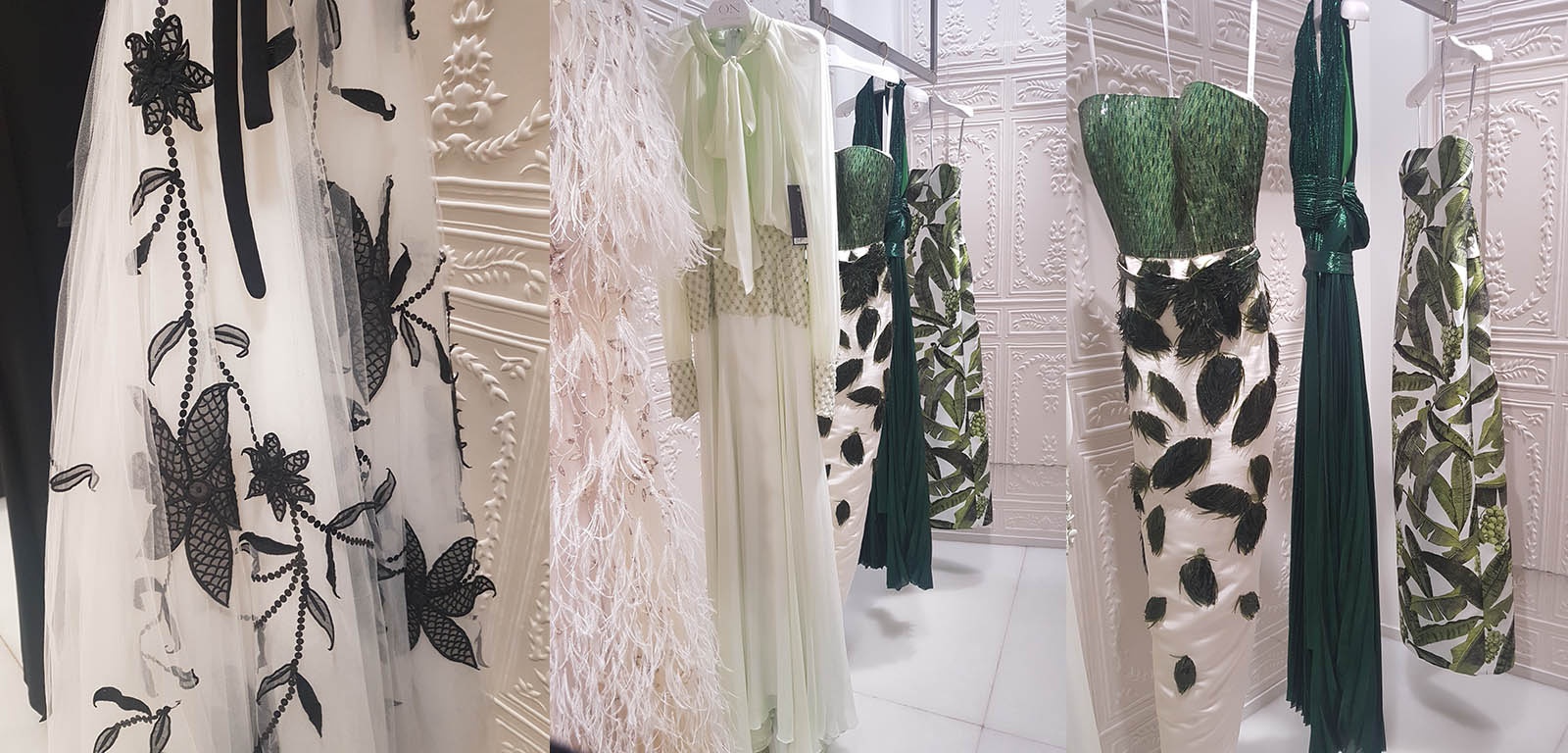
To finish with a look at some dresses themed with Green. Green isn’t a colour that is worn so often and in recent seasons seems to have come to the fore as a possibility for occasion wear. I would say that Spring and Summer are the best seasons to take it out although a rich Green velvet around Christmas and New Year is also a nice addition the wardrobe. Nature comes vividly to life in these images with 3D effect applique using a raffia appearance to bring the texture of the outdoors to life. The shimmer of lush Green forest life appears in the lengths of a generously cut dress with fabric gathered in the lengths.
Baobab - luxury candles with a sustainable message
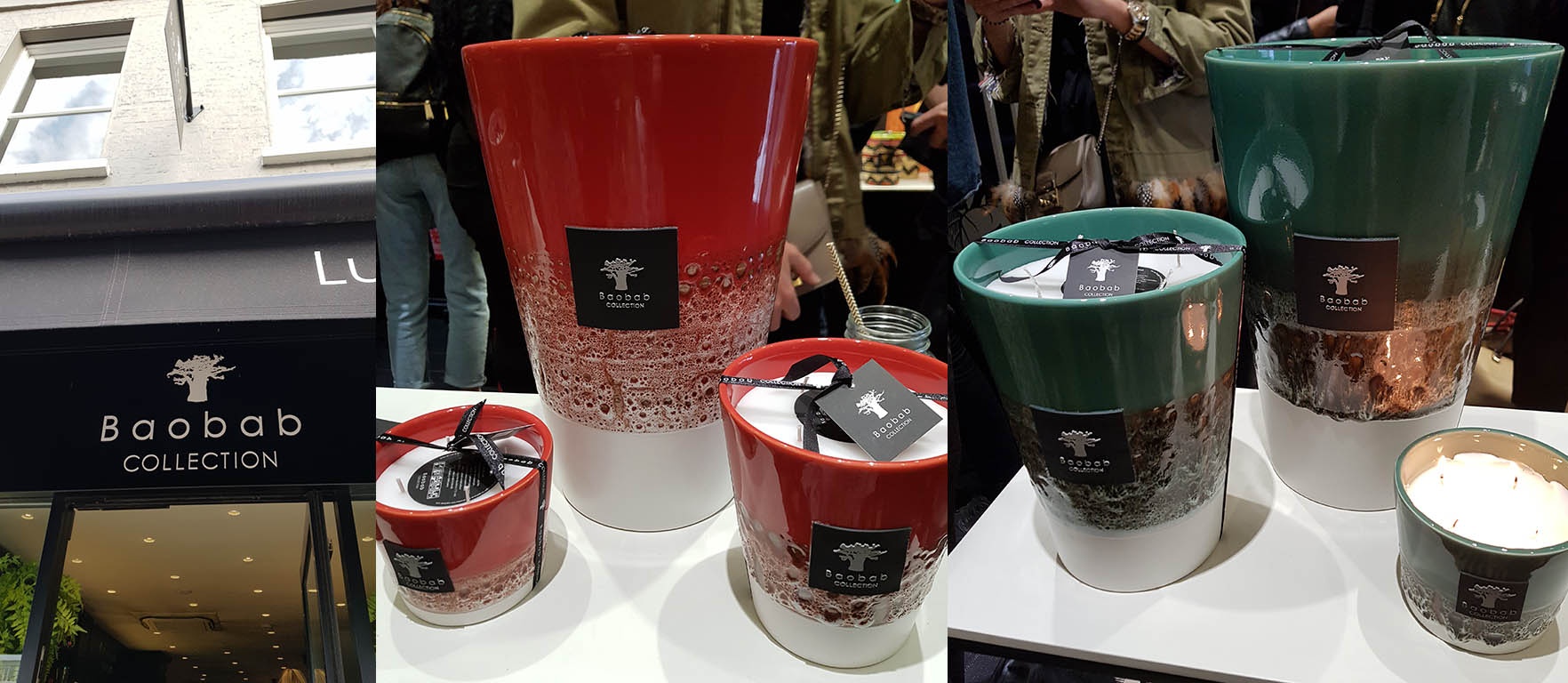
On a sunny evening in early Baobab Collection launched their first London boutique in Walton Street, Knightsbridge. The luxury candle company is the brainchild of two Belgian artisans who wanted to create a brand which genuinely had a strong sustainability at it’s core. Co-founder Jamilyn Fournier and her business partner Corine Bensahel travel the world visiting the crafts people who work to create the brand as well as reaching new retail markets across the globe. Stocked in Harrods and high fashion homewear outlets around the world, the brand is growing from strength to strength.
Above are two version of scents from the Elements collection, the Feuago in Red and Agua in Green evoke the experience of these primeval forces of nature. One of the many unique facts of the production of Baobab is that each candle jar is handmade and is unique. Patterns vary in each individual glass vessal and they are something to treasure and re-use long after the candle has been burned. They can be refilled with a new candle or used a flower vases or display and storage in other ways.
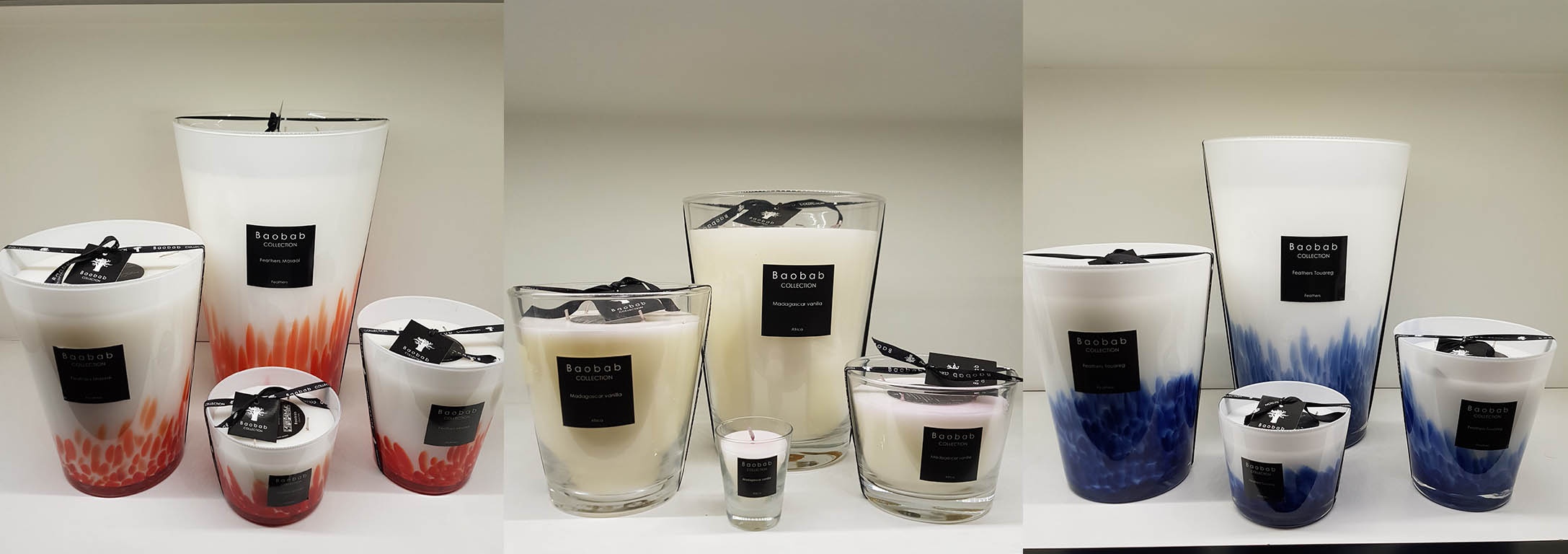
Above three more scents in their beautiful glass vases evoke with warmth of spices, the soft sweetness of Madagascan Vanilla and the light touch of feathers. It’s a skill to try capture these moods and elements but the team manages it well with careful blends that will work well in home or workplace environments such as meeting rooms. The four sizes available allow a great choice of options for gifts and for yourself.
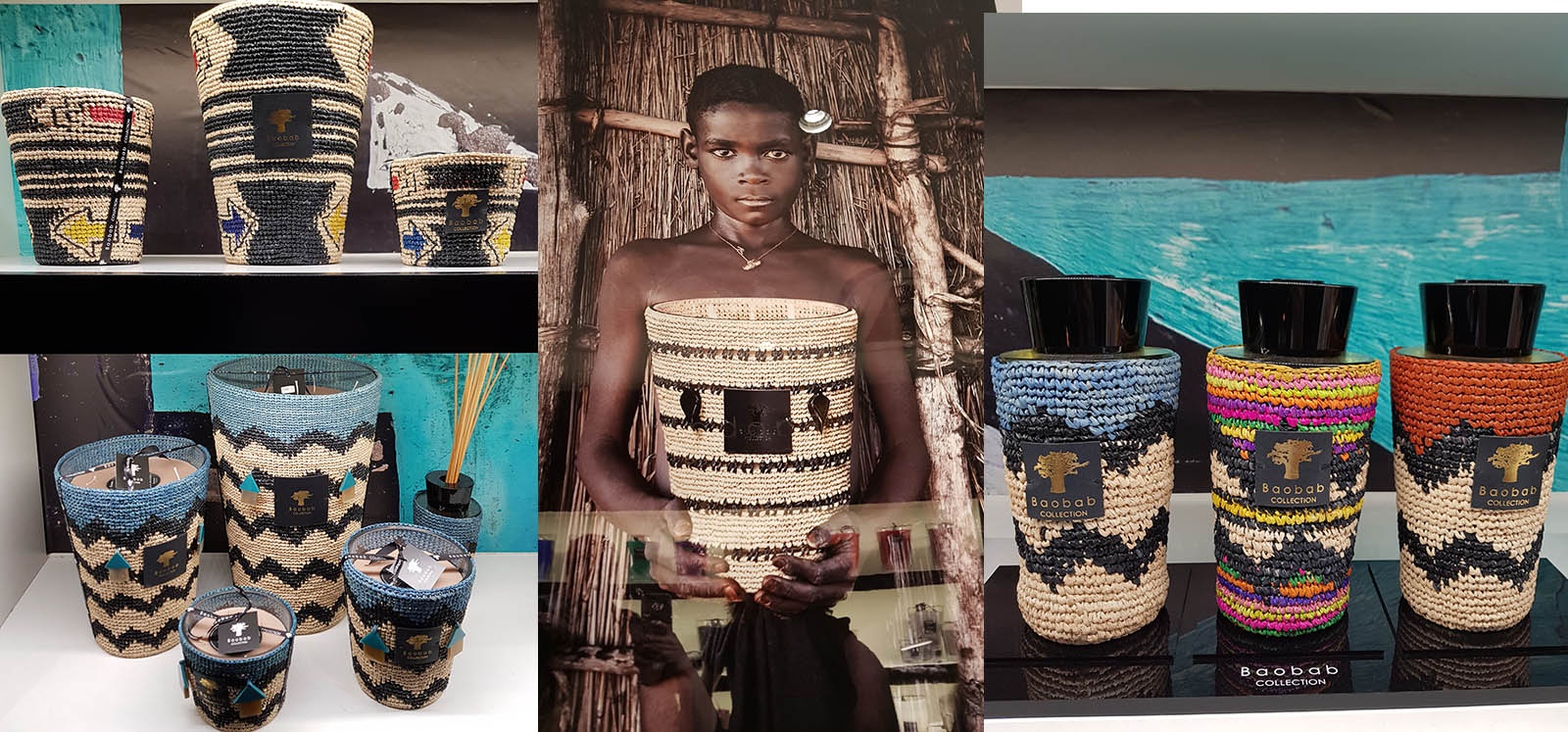
Baobab practices the philosophy that it’s artisans should never be under pressure. As I have encountered in other sustainable projects, the company partners with weavers in developing countries to create baskets and firmly supports workers working at their own pace and not pressured to meet supply demands. This is crucial when many artisans are juggling numerous other daily pressure such as childcare and sourcing clean water and food potentially but still gives them the flexibility to earn an income to support themselves and potentially families. The raffia woven vase cases of several collections are produced in several locations around the globe including Madagascar and all are produced by people free to work at their own speed and make independent choices about their work. This is true sustainability; supporting without applying pressure to people.
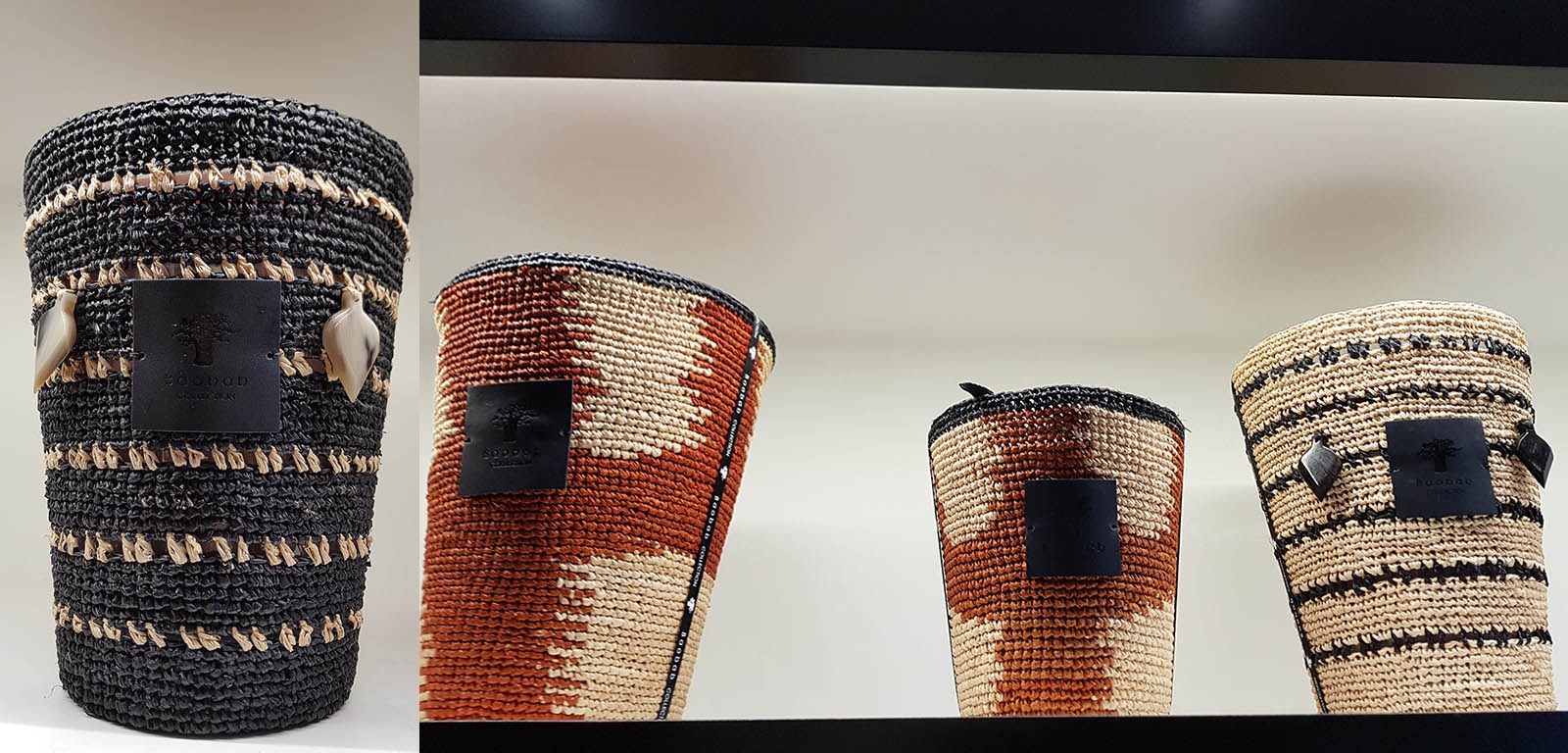
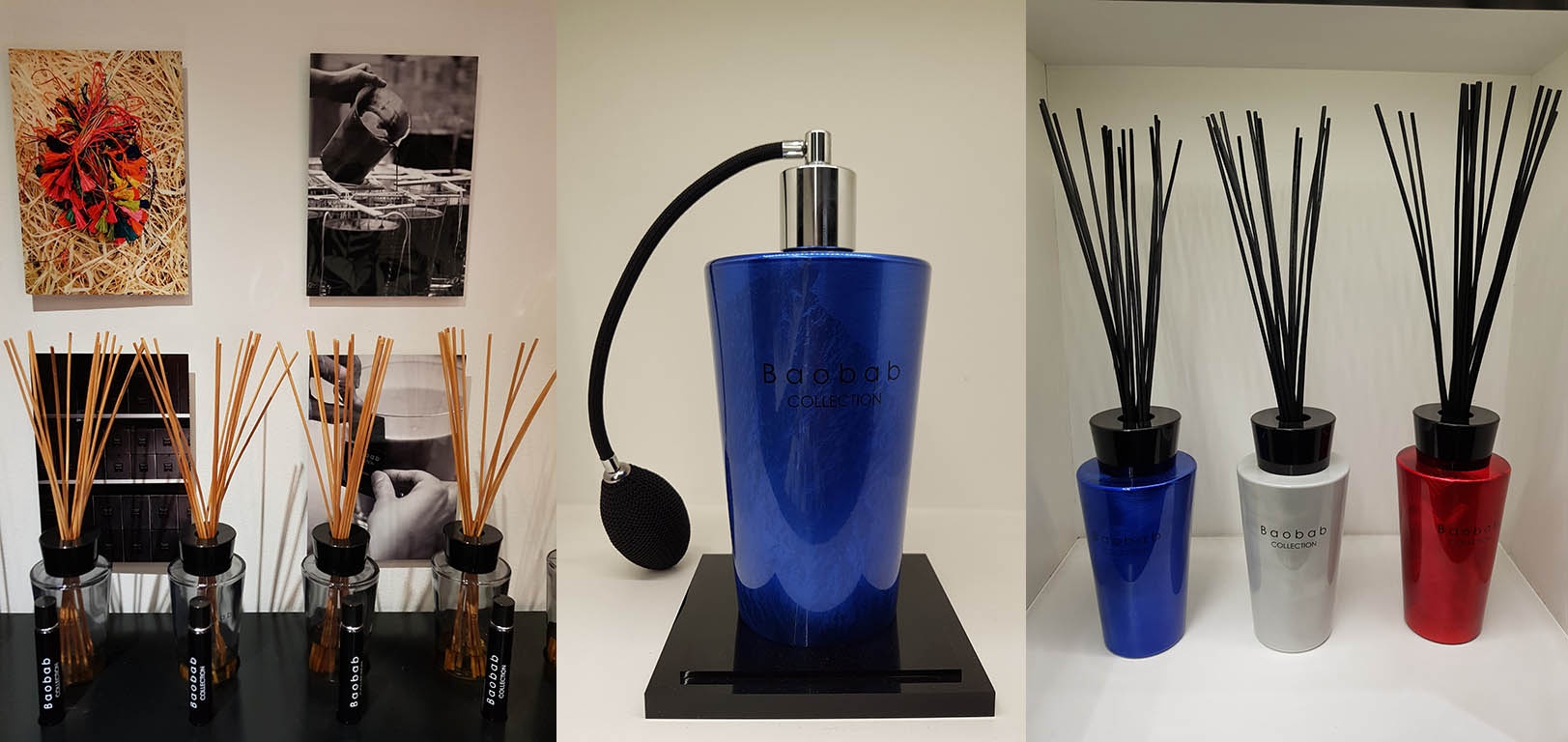
Room diffusers with their naturally clear fragrances are a popular line of the collection and make a charming addition to a room that can be tucked away in small spaces. They cross several collections and also appear in the Disco themes with candles named after Diana (Ross) Tina (Turner) and Gloria (Gaynor). The flashing bright colours of the late 1970’s Disco era and studio 54 are brought to life with snappy scents that are uplifting but not over powering.
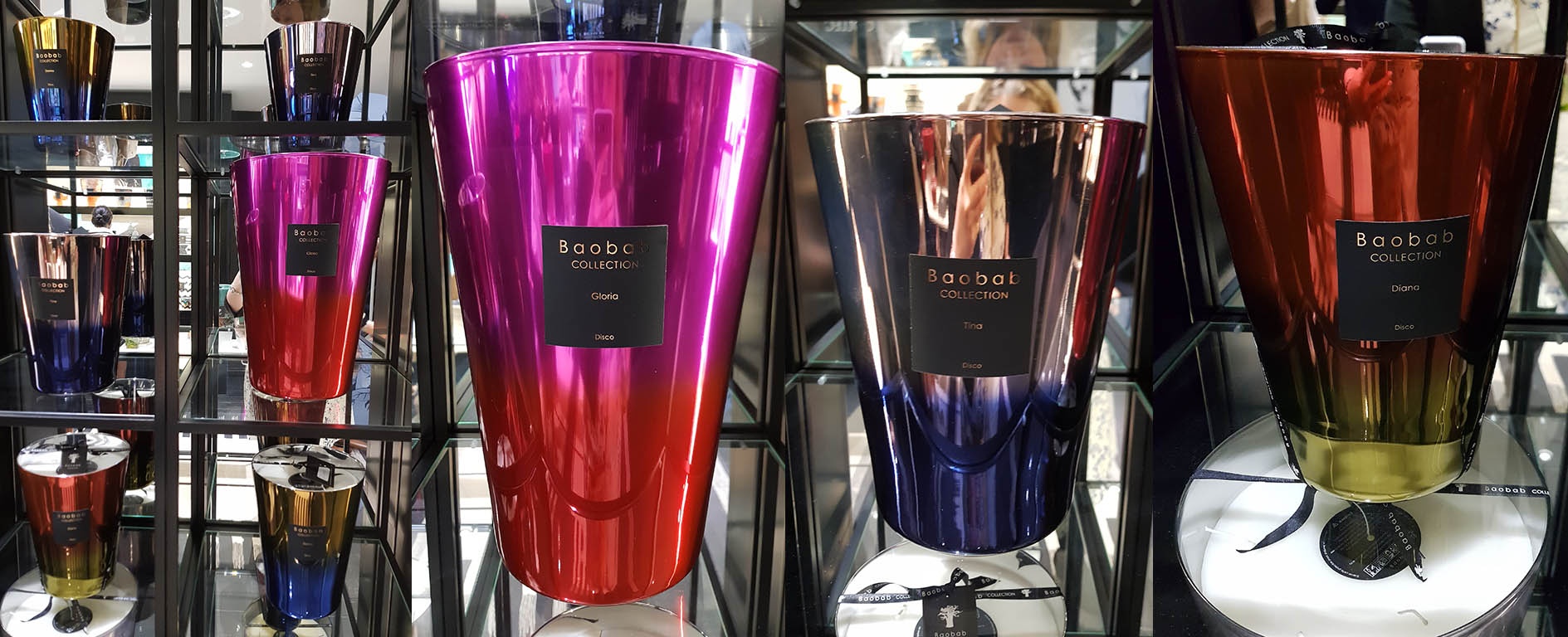
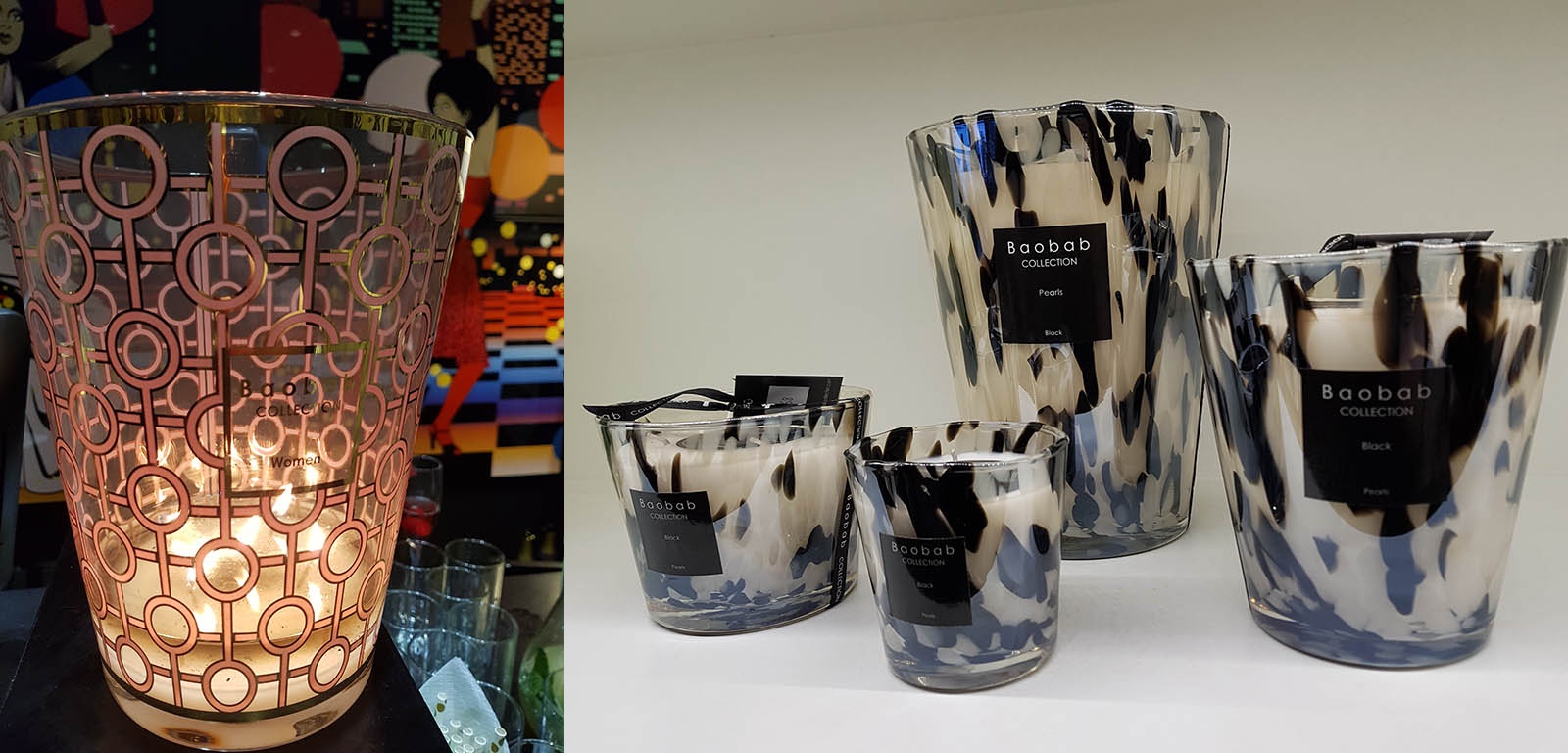
As the candles burn through the glass they create an optical illusion through many of the designs that carry styles of the Art Nuevo. The candle supporting women and women’s charities from it’s sale profits features a boldly interlaced design. The circle and cross of the feminine medical symbol is multiplied many times over to give out a signal of strength. The soft feather like strokes of the Pearls candle glass design also show the subtle individuality that make the glassware collectable. The candles below to the left celebrate the iconic architecture of Victor Horta creator of the Brussels Art Nouveau and the city where the Baobab project began. These are unique timeless pieces and it’s wonderful to see the brand stretch it’s message across the globe.
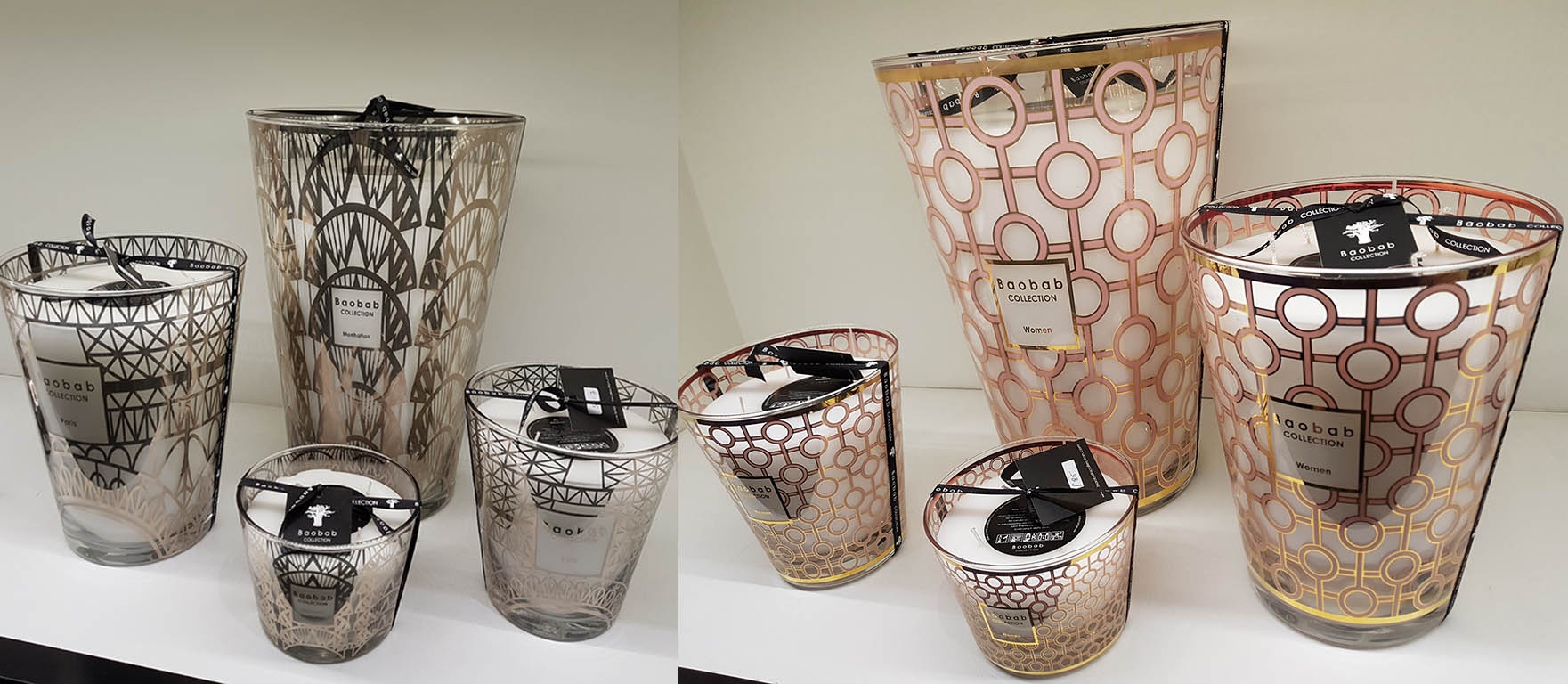
Cruise Collections - feature on CHANEL
The stage was set on board the imagined ship La Pausa named after the holiday home of Gabrielle Chanel in the south of France, owned by the CHANEL corporation since the 1980s.
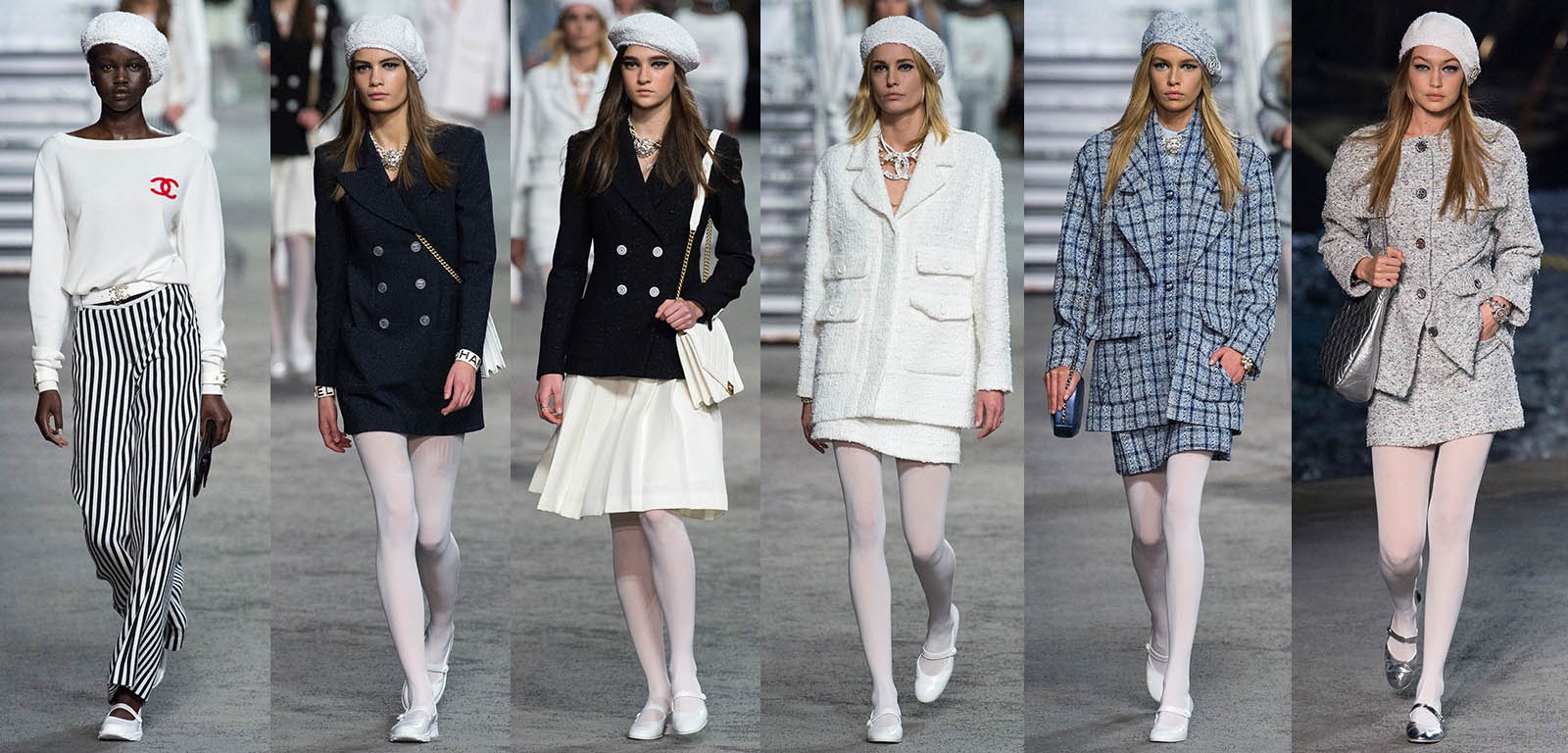
The collection opened with a classic Maritime statement updates as Marine stripes met with inter-locking C’s positioned over the heart in attention drawing Scarlet. A beret worn slightly to the side, present in much of the collection, perfectly formed to sit on the head stylishly or be pulled down a little lower against the new year chill. CHANEL is a brand that lives in it’s history each day seeking to re-invent and adapt. Two of the most classic pieces of the collection came early on with Navy blazer’s appearing perfectly cut to the female figure consciously adapted from the men’s wardrobe paired with either White stockings or a White skirt featuring pleats evoking a uniform look.
A beautiful suit in White woollen tweed features double tiers of breast pockets in a long jacket sitting above a short above the knee skirt. The classic features of the CHANEL Black Jacket are there but statement interlocking C’s in confident shimmer leave no doubt that this is a look from a CHANEL collection. A suit woven in Navy and Light Blue check in the skirt and the jacket adapts this style to the single pocket variation but broadens out the lapels to create a slightly different look. On closer examination however you can see that double pockets are here again as the deep top buttoned pockets at the hips each have a side cut upper pocket on the outside at the diagonal to slip cold fingers into. To the right a soft Blue-Grey suit cut in relaxed contemporary lines teams hips and breast pockets in the jacket with pockets at the waist in the skirt underneath. With extra volume styled into the jacket at the shoulders and the sleeves, this is a soft casual take on Haute Couture.
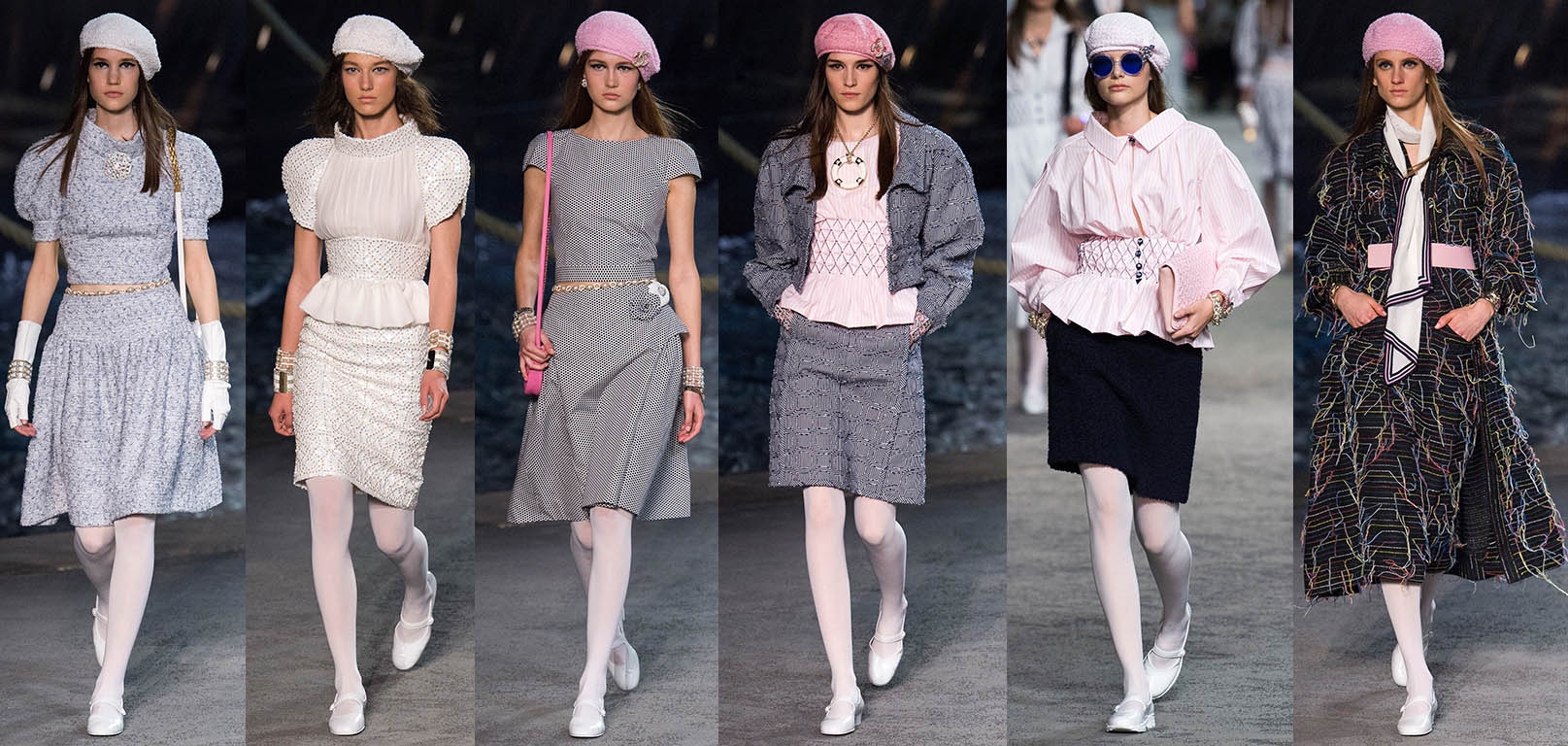
A light sweater slightly cropped at the waist, it's fitted cuffs contrasting balloon sleeves, and knee length skirt with defined waist band rides the understated tone of comfort and luxury CHANEL set for the collection. Looking faintly girlish and referencing the 1980's with it's fingerless gloves, the exquisitely woven fabric is topped with signature details such as a slim boucle band around the waist of the skirt. The brooch appears again, another key feature of jewellery that is reappearing increasingly in designer collections. Some looks in the offering feel like they could be part of a uniform at a private college whilst others are more overtly flexible across many generations of clients. The fitted waist and puffed sleeves take on a new dimension with White silk sewn with pearls accented with peplum detail around the waist. Harking back to the 16th Century the precise geometry of the pearls sewn in the bodice and skirt highlight the skilled workmanship of the artisan. A simple Grey woven two piece continues the light sweater orblouse and skirt theme composing a simple two piece look. Offset with a Magenta Pink purse and two camellia's at the left hip, it's a playful piece.
Putting another casual spin on the traditional suit an open high waist tweed jacket is worn with a smock style blouse and above the knee skirt. It's playing down the formal once again and amongst the hints of rebellion against formality a life raft is made into jewellery in a symbol of fun in the necklace. Light and soft it's also going to keep out the chills of the early Spring at sea or on the land. The Rose of the beret appears in the blouse of this and the next look. Again smock detail gathering is worked into high fashion style giving a comfortable flexibility that is the essence of garment construction in Haute Couture. Wide sleeves puff through the length of the arms to the defined cuffs in perfect tailoring and through this range above I feel Karl and his team channelling my signature colours and creating some dream pieces :-) Completed with a long-style purse, this look is a classic day or dinner, drinks and receptions in the evenings. To the right a more experimental piece shows Black woven tweed with twills of bright colours flowing from the garment like energy darts from the chalice of the woman wearing the garment. A Rose Pink waist band and beret are off-set for Cruise season by nautical stripes in the necktie.
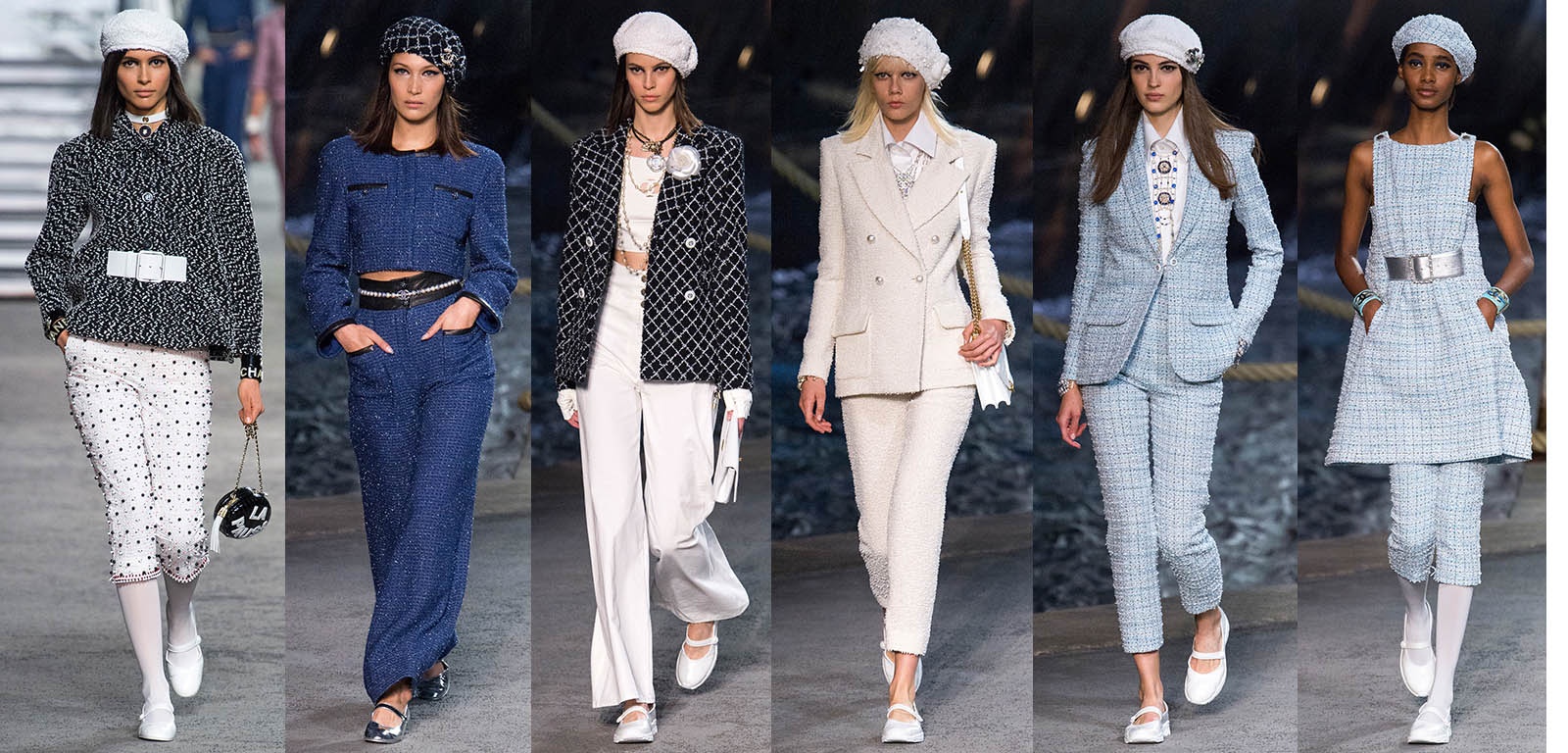
A Black and White boucle jacket cut generously fits the wearer like a loose wrap. A statement buckle at the waist matches a slim White collar choker and a pair of intricately pearl beaded pedal pusher cut trousers. There's a very captivating contrast between the geometry in the sewn pearl detail and the lose fabric of the jacket. A Navy Blue tweed trouser suit brings the collection squarely to focus on a navel theme. Jacket pockets cut at the breast line are bordered with a soft Black trim echoed in the cuffs and the trousers waist band. Pockets at the hips that the hands neatly slip into make a practical style update. Pearls strung around the waist in necklace style and Diamond check tweed of the beret fuse the Anglo-French luxury look that the House carries from it's founder. Centre above the check of the beret appears again in a jacket cut in double breasted style with Camelia brooch at the left lapel. A White cropped blouse and wide cut trousers are matched by the beret producing a two-toned colour look of sophistication.
A Cream-White tweed suit offers a warm stylish seasonal look with a White high collared blouse peeking from underneath a double breasted jacket. Uncomplicated but perfectly executed, it speaks elegance. A Baby Blue woven tweed proved a popular addition to the collection and to the right. A trouser suit softly woven in the charming fabric is accented by a crisp White blouse with jewelled embroidery flowing down the button line. Soft and easy this is classic high day wear. To the right a dress in the same boucle weave is gathered at the waist by the partial belt seen to the left of this range. Front pockets cut on a slight diagonal offer a muff-like place to shield hands from the cold.
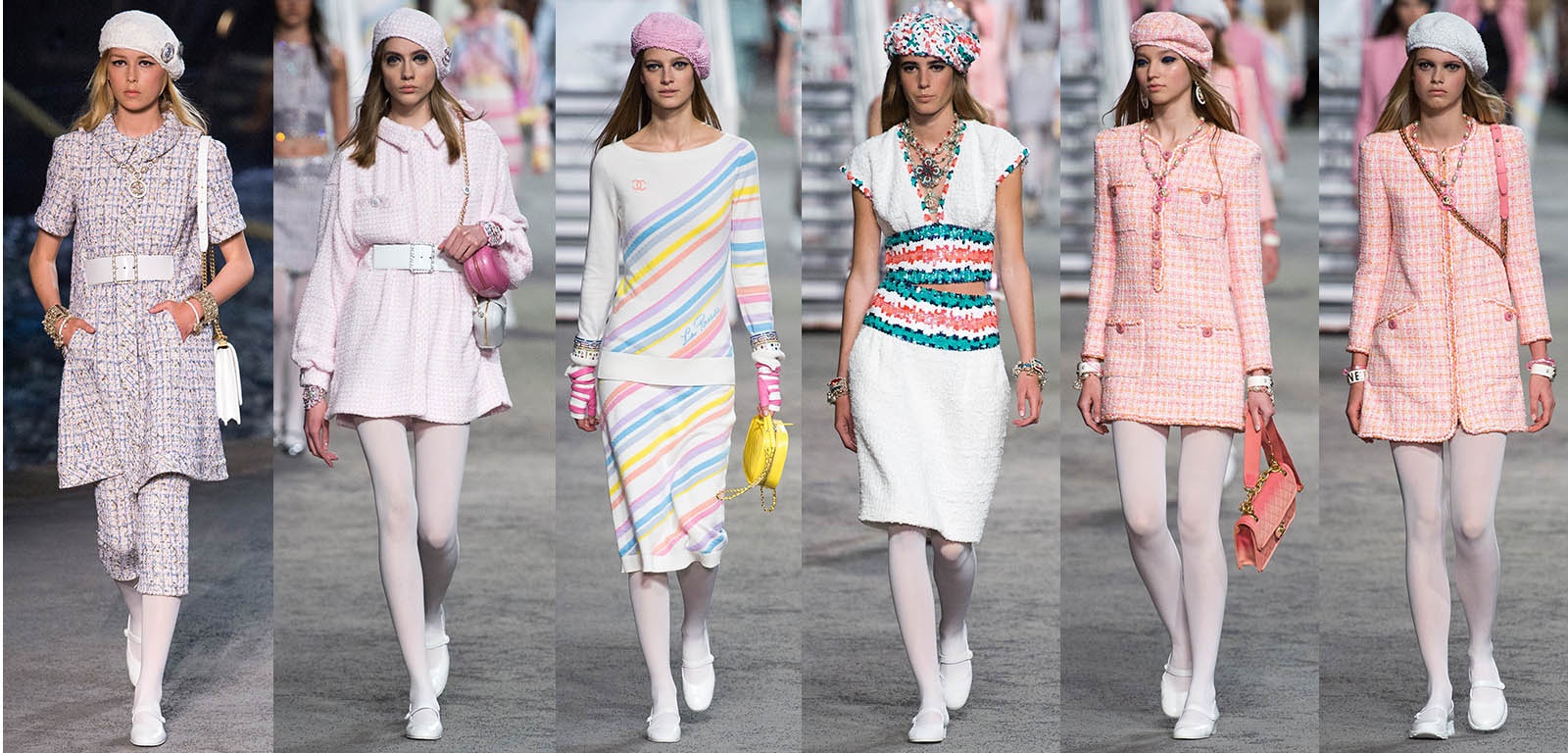
The collection tours through softer shades that evoke child-like playful colours and capture a sense of soft femininity. Blush Pink and Lilac combine in the look above to the left featuring a long line jacket skimming the knees with soft side pockets and the partial belt gather. Matched with cropped trousers this is a casual luxe look that will keep the wearer warm but still embodies lightness and style. It's White beret also features a brooch similar to the one worn at the neckline. A White mini length coat dress is a sweetheart piece that is super-agile in it's uses in your wardrobe. Again cut with the sympathetic softness that is characteristic of this collection, it's softly partially belted with generous fabric in the arms allowing for ease of movement and trapping a little body warmth inside in cooler days of Spring. The matching White beret can be pulled down easily over the left ear, or if you're very careful in the cold over two. The neat collar and cuffs seal the style details.
Centre above candy pastel stripes in bias cut lines across a light sweater and knee length skirt offer a playful interpretation of winter colours. Bringing a note of colour to darker days or sunshine filled travels it's a trans-seasonal piece that could be very useful as a whole or worn as separates. Working with classic lines once more and embracing a slightly Egyptian theme, Salmon and rich Green combine in bars at the waist and the hips of a garment set against a White backdrop. There's a simple classicism in this look that's captivating. To the right two looks that feature one of my very favourite tweeds that I've ever seen come out from CHANEL. A soft Baby Pink is woven with White into two mini length coat dresses that are light, warm and universally adaptable. Pockets are carefully cut and with the beret sitting on top this look can be subtly styled to pitch anywhere between CHANEL college chic, international business woman or someone enjoying time socialising.
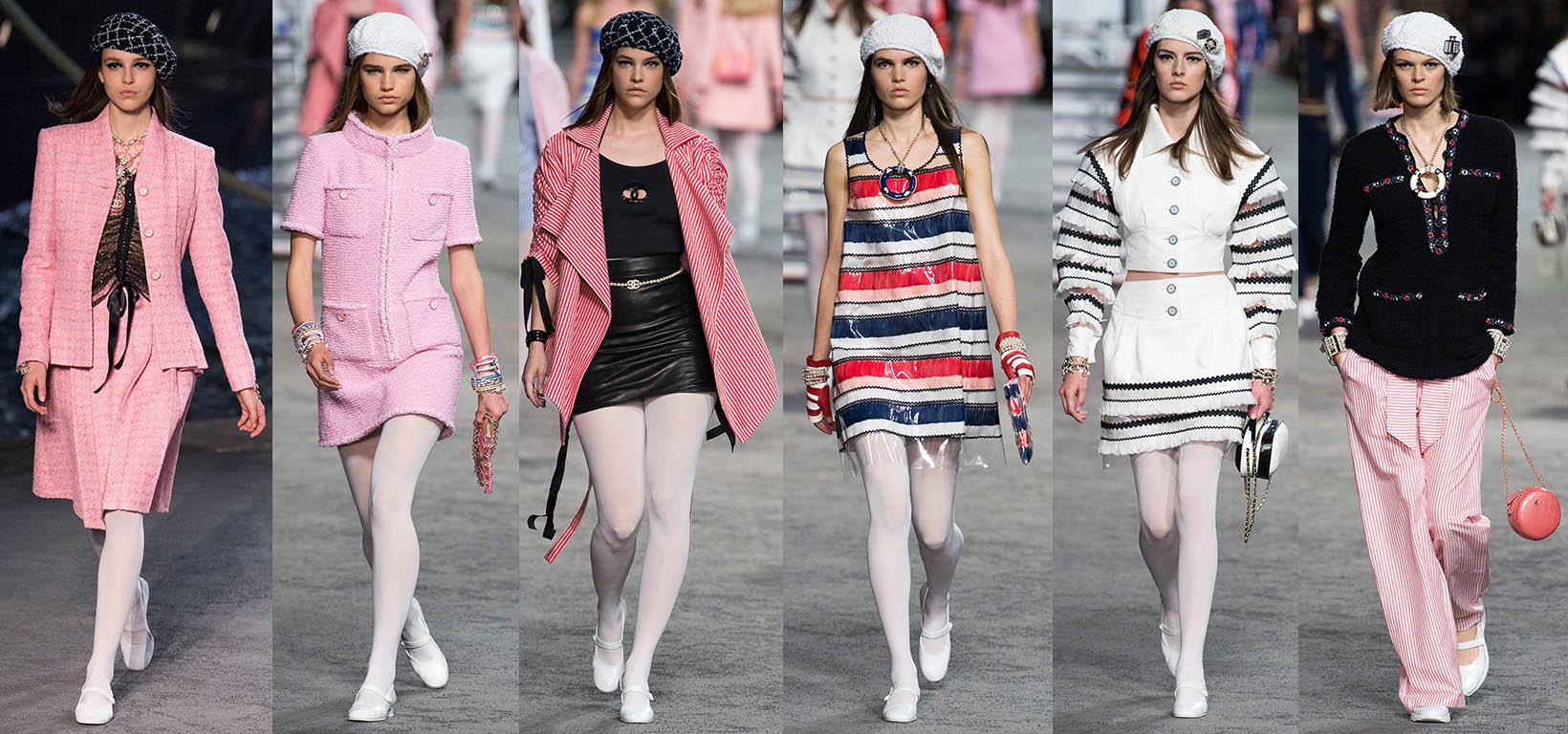
Rose and Black return again in a beautiful dress and jacket combination given a daring twist with a sheer blouse composed of strands of fabric. Fashion made and unmade before your eyes. Anchored by a ribbon running down through the centre of the shirt composition it's generous bow tie adds a touch of prettiness. The beautiful Black check cloth returns in the beret and set against the White tights and low heel Mary Jane's of the collection, again it hints at simple uniformity. Another mini coat dress in soft Rose features an angulated round collar forming a subtle contrast to four square cut pockets. The White beret and small clutch to finish the outfit set the note of harmony of unaffected simplicity. Looking at little towards the evening a Black leather look mini skirt and cropped top are matched to a Magenta-Red candy stripped open shirt. The balloon upper sleeves of earlier in the collection appear again with sash ties at the elbow and the soft Black tweed beret present across the collection, anchors the style amongst its peers.
To the right the navel colours of the French and British flags are enhanced with Blush in stripped bands across a soft perspex mini dress. The round neckline compliments the feel of a 1960's sweet navel look and the life raft charm necklace, fingerless kid gloves and small clutch purse signal that this is a look to party in, or head to the office, if you should feel. The theme of tiered layers takes on a three dimensional expression in the Black and White trimmed mini skirt suit with balloon sleeves. There's a hint of the 1980's here and also the 1880's and 90's looking back to the Parisian heritage of the 'Belle Epoch' but bringing the mis en scene up to date for the clients of today across the generations. A beautiful Black jacket bordered by Roses sits loose and cosy on the wearer teamed with Rose thin stripe trousers in fabric matching earlier blouses. It captures the sophisticated nonchallance of the Parisian mood and the sensibilities of clients around the world. The button like circular Rose purse is a chic 'full stop' to punctuate the completion of the outfit.
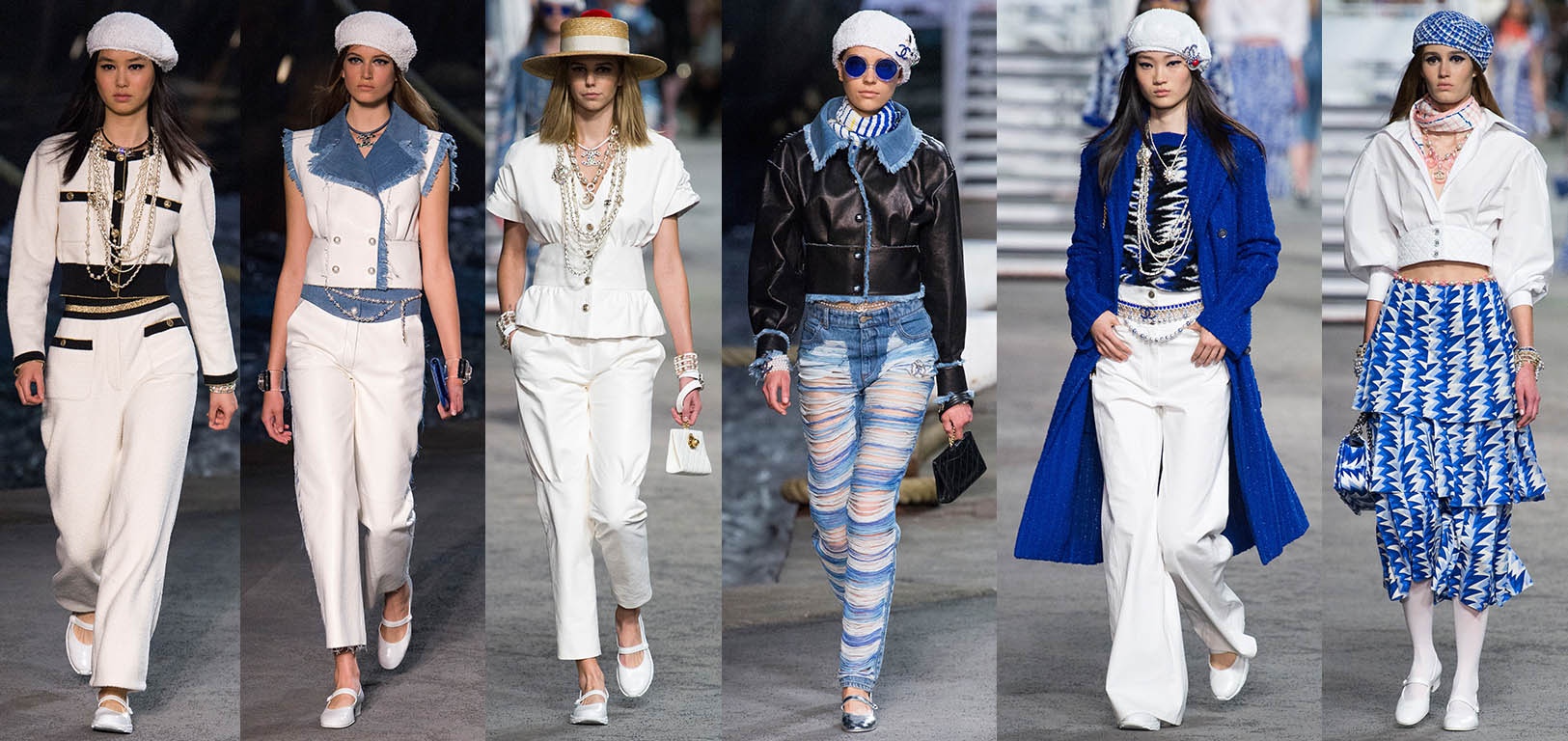
Flirtations with colour return to a monochrome (albeit Navel style) palette with White and Navy Blue forming the defined borders of a cropped jacket and Golden chord belted trousers. Buttoned seams are accented also in the maritime key colour to ground the look in uniformity. Playfulness is expressed by five chains of Golden pearled signature jewellery in the codes of the House. Moving to a more adventurous style the trouser suit gets a playful reawakening with denim lapel fringing echoed in sleeve and seam borders and a high waisband of the trousers. The super versatile Chanel pearl jewellery chain makes an appearance as a belt, one of it's many guises and gently breaks the line of the outfit. The outfit to the centre above bring jewellery into it's own with multiple chains at the neckline descending the jacket. Soft gathers from the shoulders are complimented by ruching effect above a broad waist band holding the focus on a slim line figure and White trousers cut in a simplified line are a universal wardrobe staple.
Ripped jeans make a slightly unconventional entrance into a Cruise collection, nodding to the tastes of a new generation of clients who look to find a pair of highly distressed jeans executed to perfection. A leather bomber jacket fringed in Denim may also find it's way very quickly to the top of lists of international clients as it's an easy chic piece to add to the wardrobe and wear across seasons. Then again so are the majority of looks through this collection. Cobalt/Lapis Blues herald the Blues of the high seas and in cruise season the Blues of warmer waters where traditionally always a great draw for clients to explore. A knee length woollen coat sits over a light chevron weave sweater and broad sailor style White trousers. A pearl strung belt keeps the style in check around the navel and a dropped chain gives it an added extra edge. The bomber jacket style is fused with the formal jacket in a look to the right with a high cropped jacket teamed with a chevron print skirt in colour clash wave Blues. It's gentle tiered layers add a further touch of femininity also echoing the rise and fall of the waves of the high seas and gentle bays.
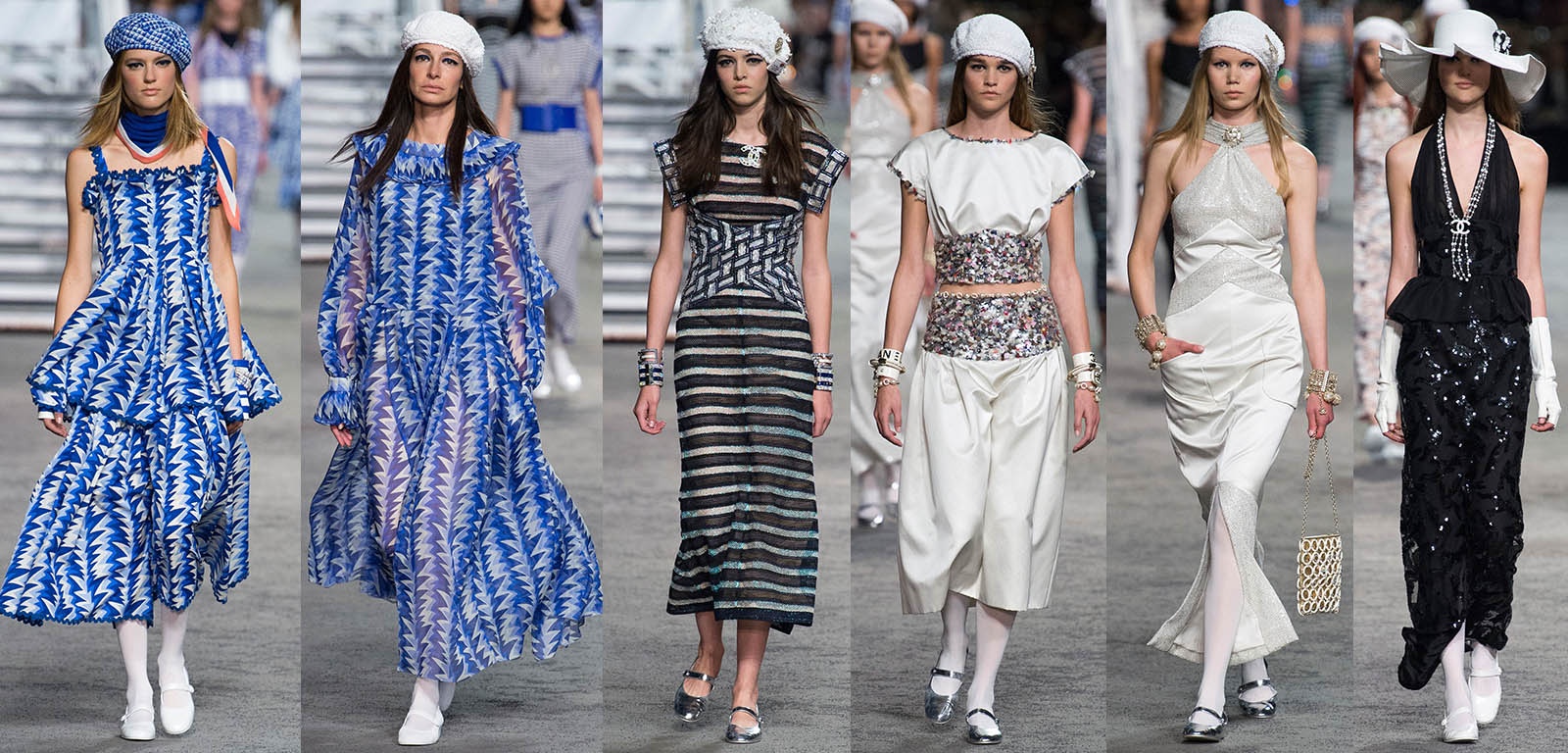
The chopped chevron lines imitating the ocean waves provide a broad spectrum of harmony for the designer to play with. Light layers of fabric that move with the wearer as she walks create an optical illusion effect that draws the eye and subtly plays down the skilful cut and finish of the garment. Simple ruching at the neckline and lengths of the long bodice top add extra texture. Next a slightly sheer long line dress billows around the wearer as she walks imitating the volume created by winds at sea. It's a light piece that would be at home in the Caribbean this winter. Transposing the naval stripes across to monochrome with an optical illusion of Blue, the next look to above also appear faintly Egyptian and communicates both a hint of ocean travel and Egyptian inspired Art Deco. The waist is cleverly crossed with interwoven lines of fabric both replicate the ancient weave knit structure (common to ancient Britain and Egypt) and subtly compliment the beauty of the figure.
To the right the Black and White of evening wear make an appearance for formal dinners on board during those voyages of the winter months, though these would just as easily make a perfect option for engagements onshore across the winter. Glinting broad bands at the waist in the bodice and at the broad skirt bring a jewelled texture contrast to White satin silk. A Silver silk halter neckline dress is a captivating eveningwear piece featuring the lines of the 1920's and 1930's 'modern' style. With a knee length slip it flows freely across the figure while maintaining a clear line, the nautical chevrons now defining the bodice, and would be a beautiful look for the Red Carpet. To the right sequins used judiciously across silk in just the right amount descend from a charming halter neckline that flatters a long slim figure. Peplum detail at the waist breaks the line and creates a contemporary classic.
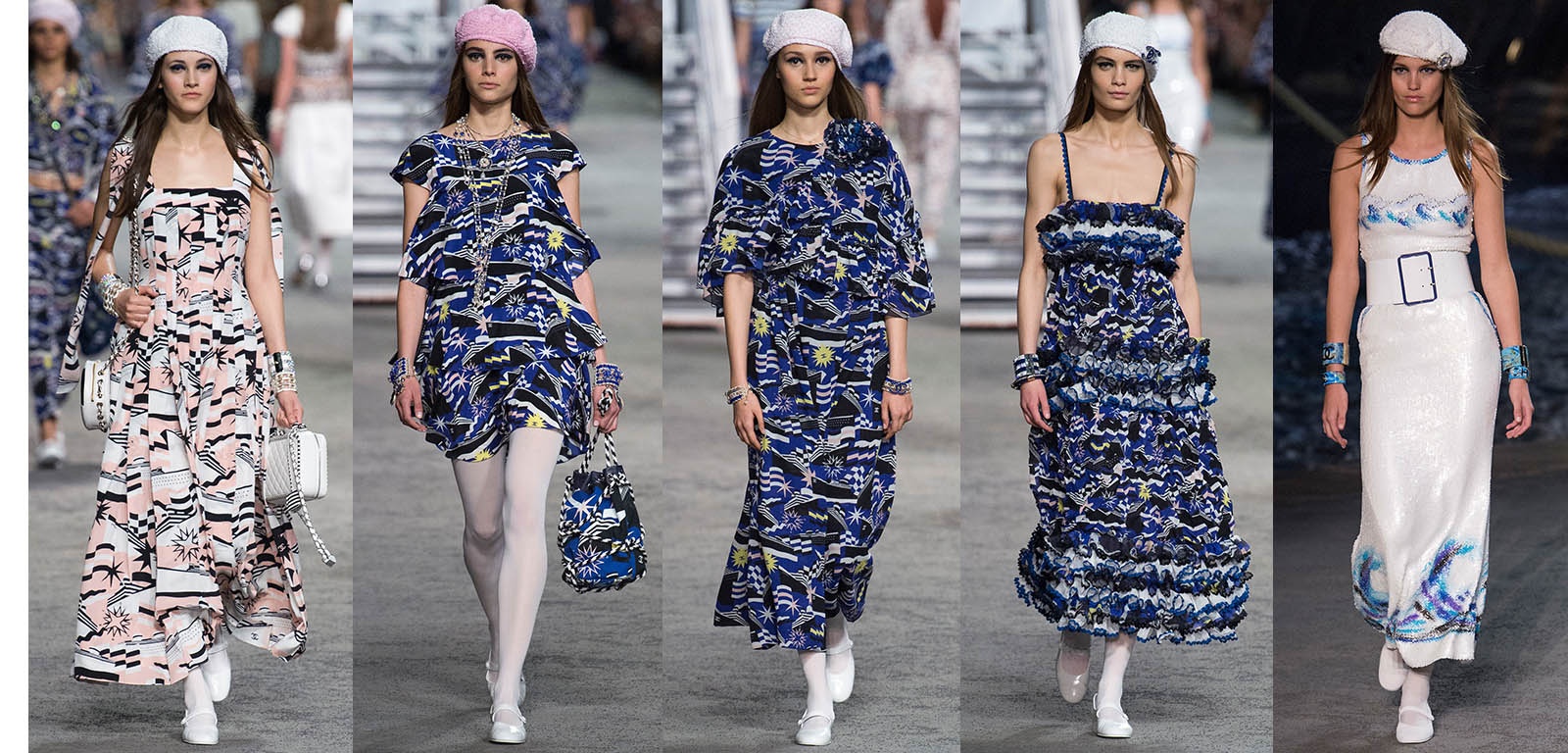
The closing series of looks of the collection, I feel evoke the spirit of the many flags of the Caribbean countries. Bright stars, islands and waves are evoked in a conceptual line drawings set to either Rose, Black and White or marine Blues flecked with bright burst of Golden sunshine. To the left the pleats of a Sun dress are disguised by the strip-collage form of the dress design. It looks like a piece of contemporary art, which many people do look at fashion as, and with two purses the wearer is prepared for a day ashore exploring the tide line or villages of an island. A light blouse and culottes are accessorised with a bucket style clutch bag and cuff bracelets make a feature at the wrists of this short sleeved look. Two dresses of medium volume in contrasting shirtdress and strapped sundress style work the same fabric in plain and ruffle detail forms. Something to suit every mood. To close a bridal option for those who's heart belongs to sailing. Ocean waves and spray reach across the surface of a White dress thickly belted at the waist in a millennial ship shape twist on the sailor uniform. All set for a bon voyage into the future with the good ship SS La Pausa.
Tiara's - past, present and future
Coming soon, some of my adventures and insights into these special pieces of jewellery.

